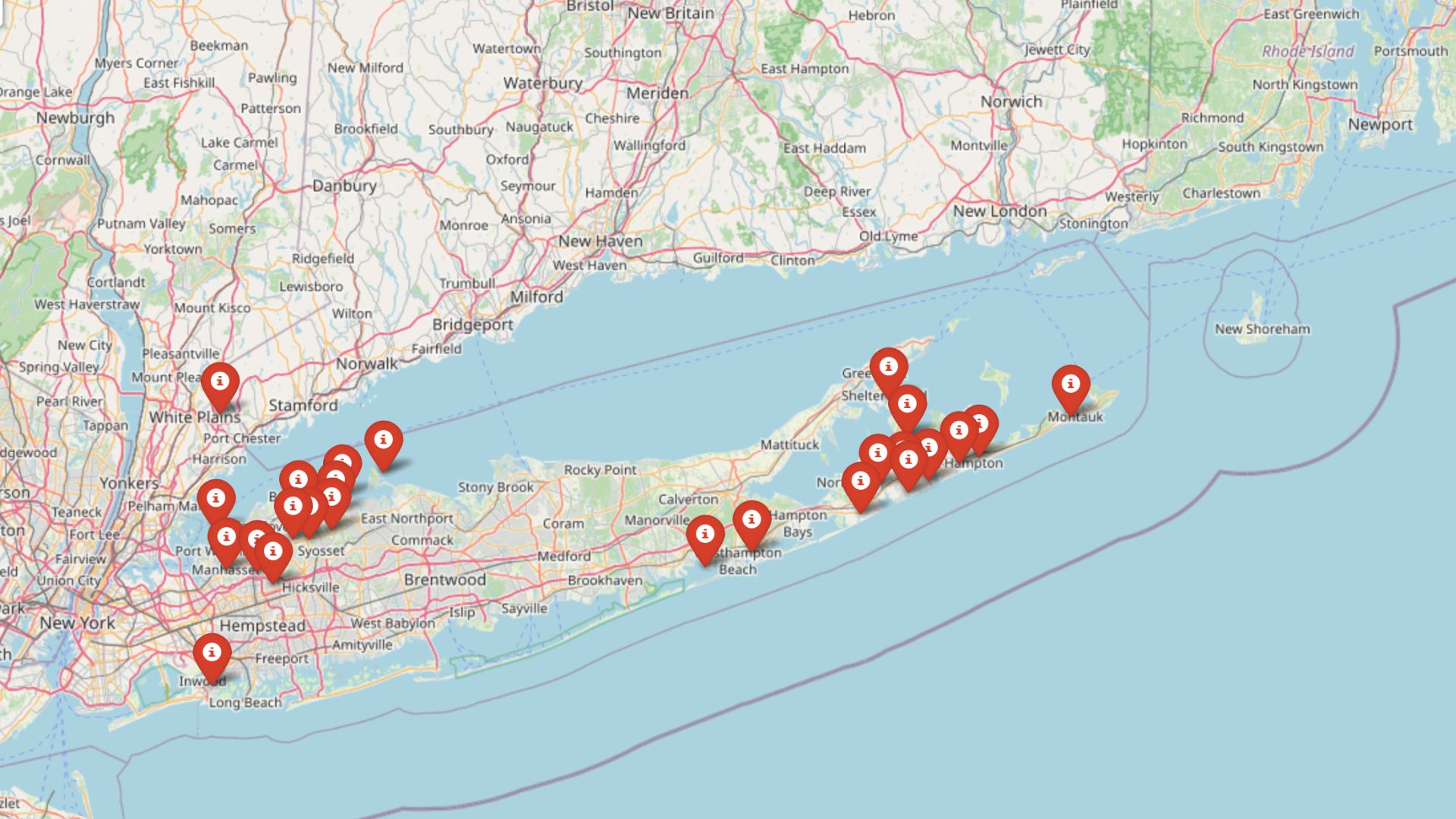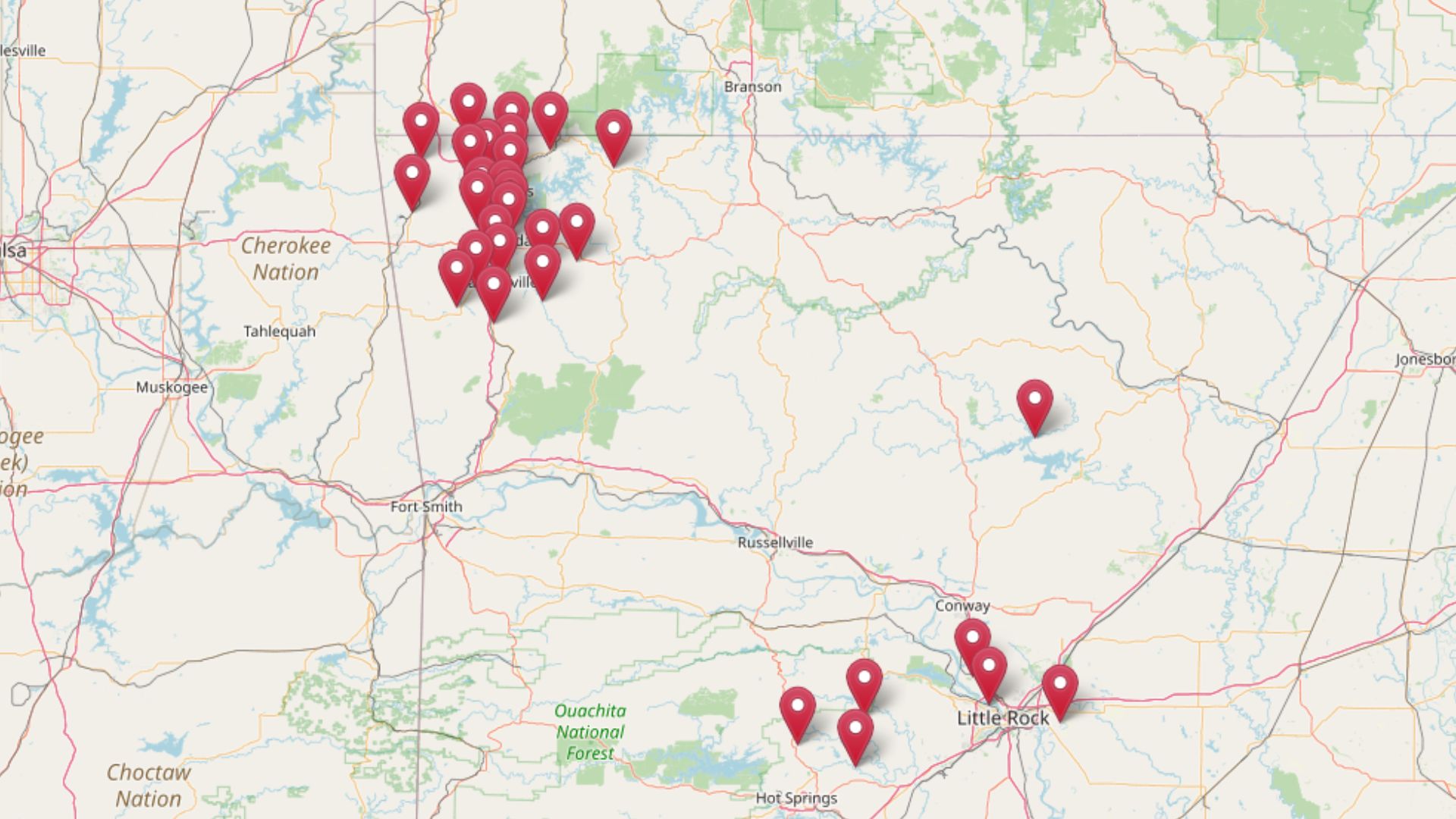
Using the latest Zillow Home Value Index data, we’ve ranked the 30 most expensive towns in Arkansas based on current home prices. These communities represent the state’s most valuable real estate markets. From upscale suburbs surrounding major employment centers to scenic mountain towns that have attracted affluent buyers, each location offers unique reasons for its high property values.
The data reveals dramatic price changes over the past 15 years, with some towns showing increases of more than 250%. Many communities saw their steepest growth after 2020, when remote work and pandemic-driven relocations transformed quiet rural areas into hot housing markets. Whether you’re looking to buy, invest, or simply understand Arkansas’s changing real estate picture, this breakdown shows exactly where prices have climbed highest—and why.
30. Elkins – 122% Home Price Increase Since 2010
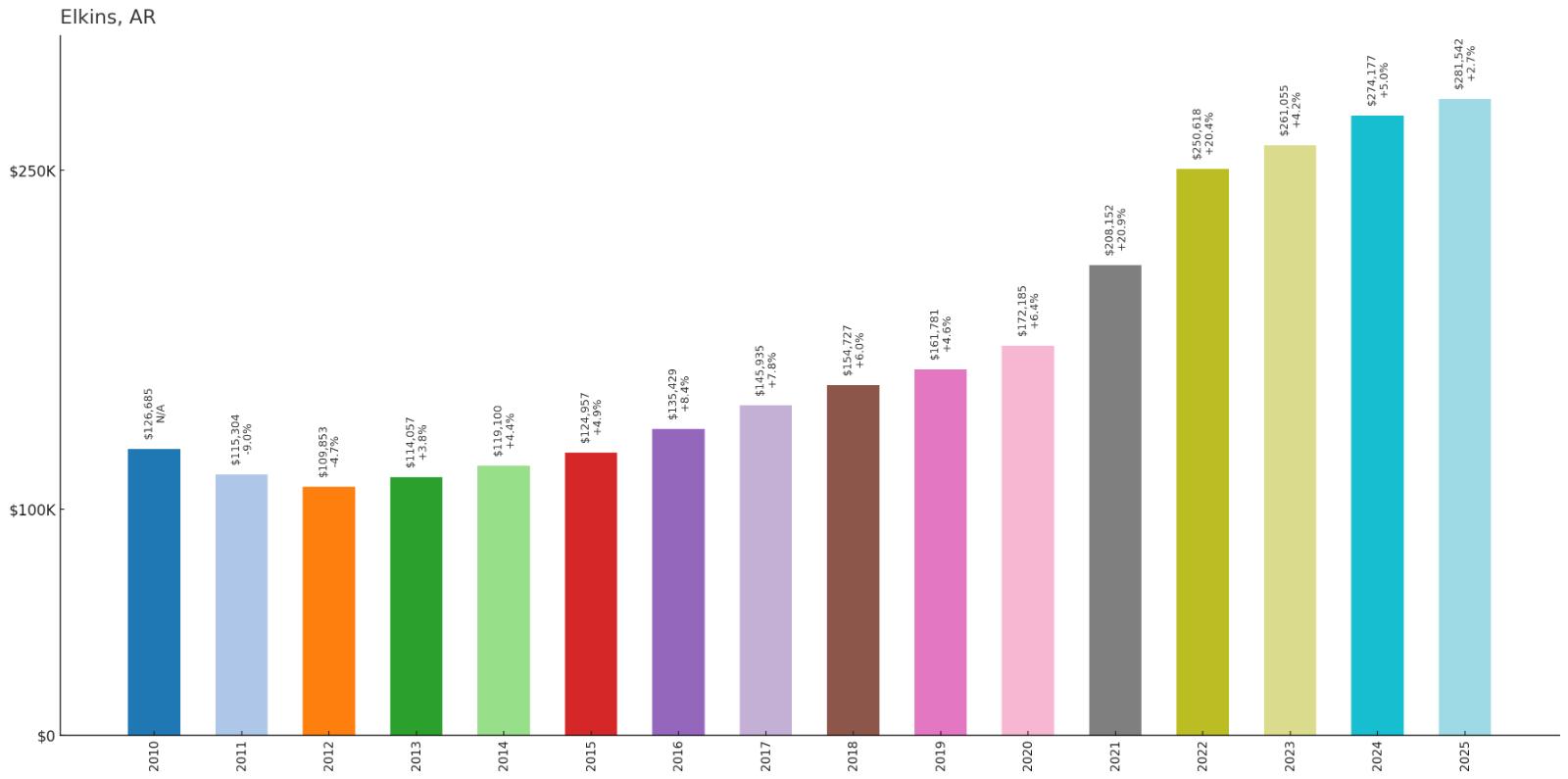
- 2010: $126,685
- 2011: $115,304
- 2012: $109,853
- 2013: $114,057
- 2014: $119,100
- 2015: $124,957
- 2016: $135,429
- 2017: $145,935
- 2018: $154,727
- 2019: $161,781
- 2020: $172,185
- 2021: $208,152
- 2022: $250,618
- 2023: $261,055
- 2024: $274,177
- 2025: $281,542
Elkins experienced steady growth through the 2010s before accelerating sharply after 2020. The town’s home values more than doubled from their 2010 levels, reaching $281,542 by 2025. The most dramatic increases came during 2021 and 2022, when prices jumped by nearly $80,000 in just two years.
Why Elkins?

Why Are People Willing to Pay So Much to Live Here? What’s Special About It?
People choose Elkins for its small-town atmosphere combined with proximity to both Fayetteville and Northwest Arkansas’s job centers. The community offers newer construction, good schools, and a rural setting without sacrificing modern conveniences. Families appreciate the space and privacy that comes with larger lots and custom-built homes.
The town sits strategically along major transportation routes, making commutes manageable while maintaining its quiet character. This balance between accessibility and tranquility has made it increasingly attractive to buyers seeking suburban living outside more crowded areas.
How Elkins Rose to Prominence
Elkins began as a small farming community in Washington County, named after early settler Stephen Elkins. For much of its history, the area remained agricultural with scattered homesteads and modest development. The town’s transformation began in the 1990s and 2000s as Northwest Arkansas’s economy expanded and suburban growth spread outward from Fayetteville.
Strategic location along Highway 16 and proximity to the University of Arkansas made Elkins an attractive option for families and professionals seeking more space and newer homes. The area’s rolling hills and scenic countryside provided an appealing setting for custom home development, attracting builders and buyers looking for rural charm with urban accessibility.
3 Interesting Tidbits
- Historic Crossroads – Elkins sits at the intersection of several historic transportation routes that connected early settlements across the Ozark foothills.
- Agricultural Heritage – The surrounding area still maintains working farms and rural landscapes that preserve the community’s connection to its farming roots.
- Custom Home Haven – Much of Elkins’s recent growth has come from custom home developments that take advantage of the area’s scenic topography and larger available lots.
29. Cammack Village – 65% Home Price Increase Since 2010
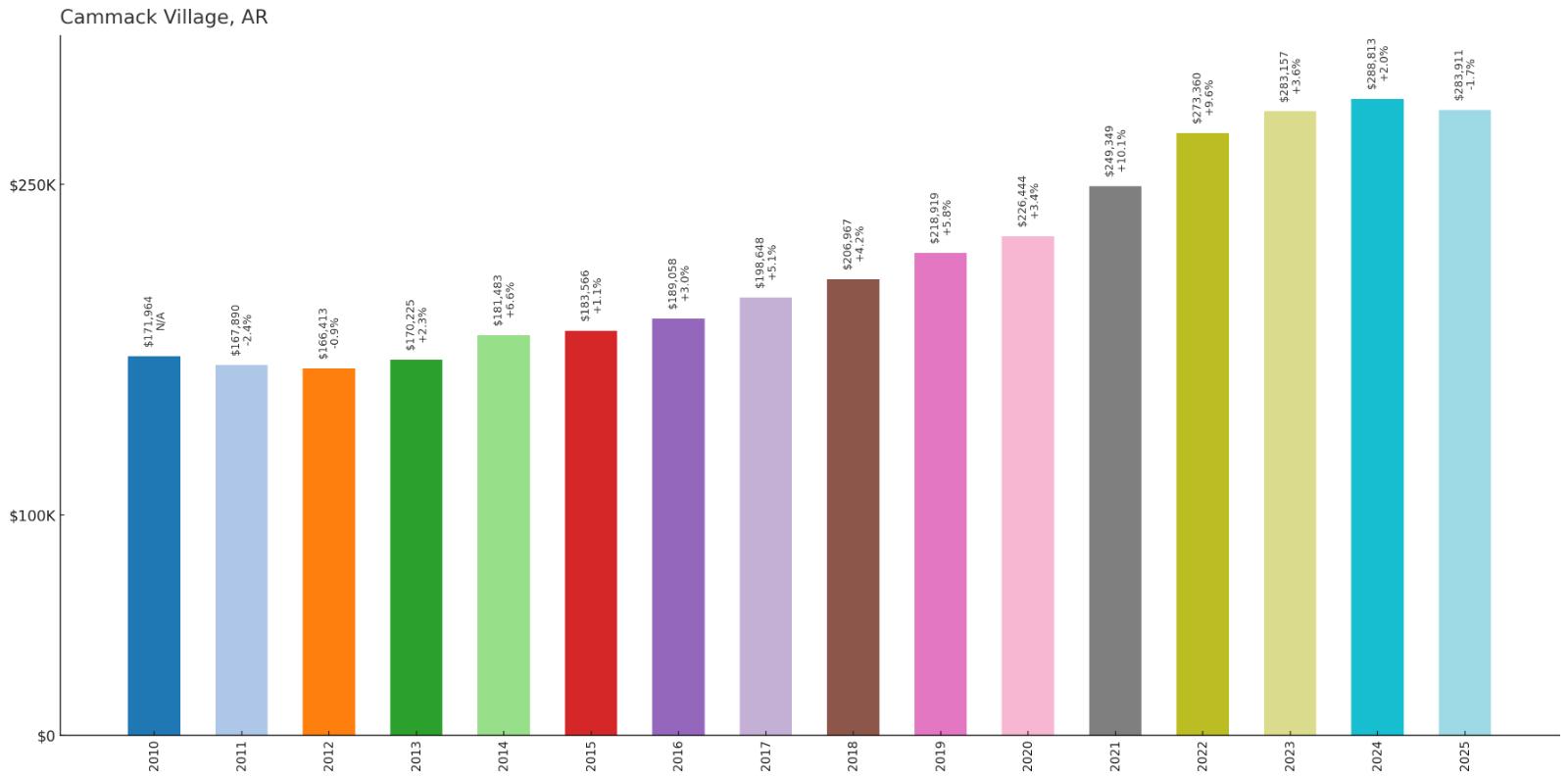
- 2010: $171,964
- 2011: $167,890
- 2012: $166,413
- 2013: $170,225
- 2014: $181,483
- 2015: $183,566
- 2016: $189,058
- 2017: $198,648
- 2018: $206,967
- 2019: $218,919
- 2020: $226,444
- 2021: $249,349
- 2022: $273,360
- 2023: $283,157
- 2024: $288,813
- 2025: $283,911
Cammack Village showed consistent but moderate growth throughout the 2010s and early 2020s. The community’s home values rose steadily from $171,964 in 2010 to a peak of $288,813 in 2024. The market has remained relatively stable with only minor fluctuations, including a slight dip to $283,911 in 2025.
Why Cammack Village?
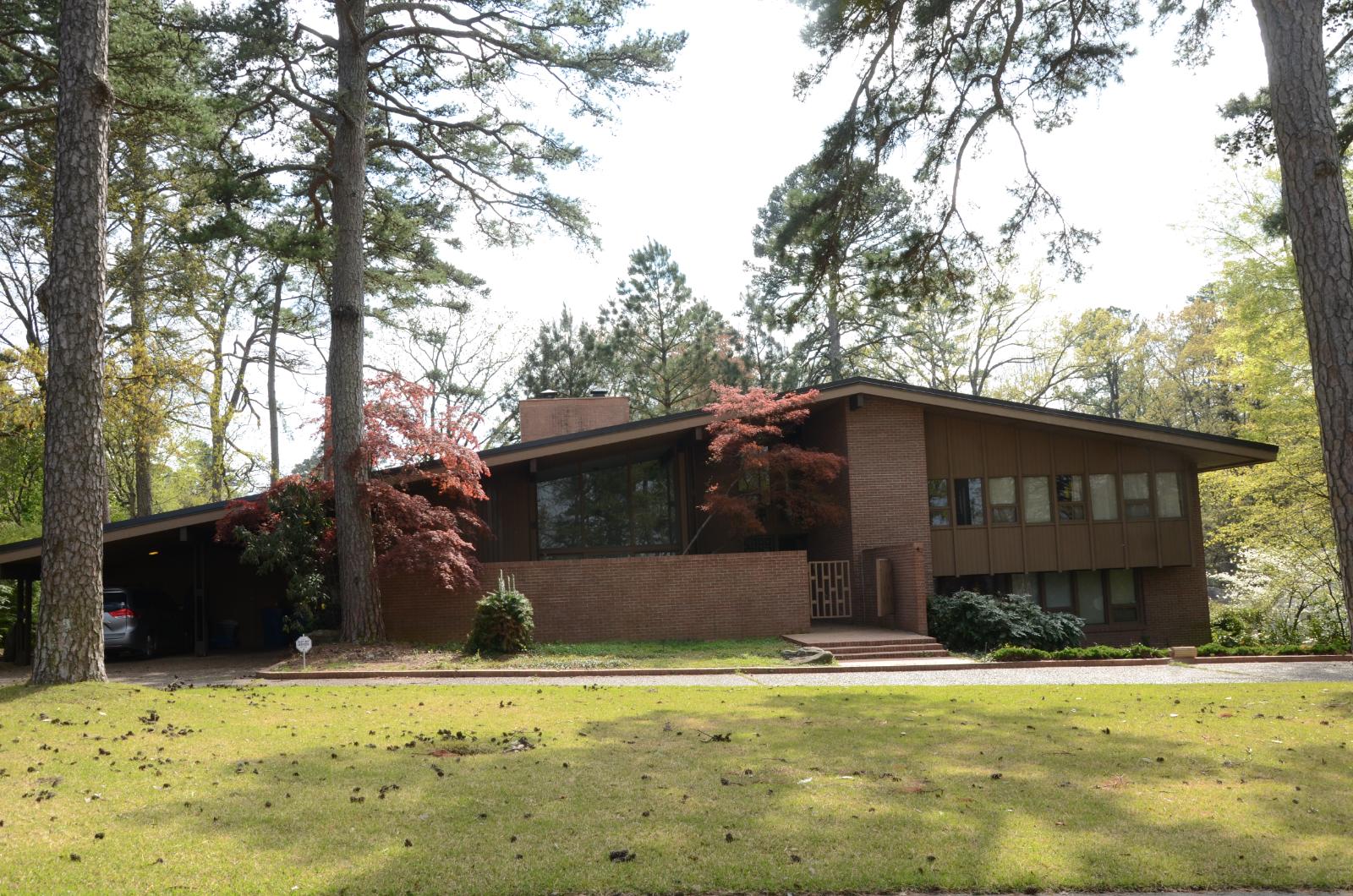
Why Are People Willing to Pay So Much to Live Here? What’s Special About It?
Cammack Village appeals to buyers seeking an established suburban community with mature neighborhoods and quality infrastructure. The area offers well-maintained homes on landscaped lots with easy access to Little Rock’s employment centers. Residents value the community’s stability and the sense of established neighborhood character.
The town’s location provides suburban living while maintaining reasonable commute times to downtown Little Rock and other major employers. This combination of established amenities and urban accessibility has helped maintain steady property values over time.
How Cammack Village Rose to Prominence
Cammack Village was incorporated in 1959 as a suburban community designed to serve Little Rock’s growing middle class. The town was planned as a residential enclave with suburban amenities, including parks, good schools, and well-designed neighborhoods. Its development coincided with the post-war suburban expansion that transformed many American cities.
The community’s careful planning and emphasis on maintaining neighborhood standards helped it establish a reputation for quality residential living. Over the decades, Cammack Village has remained a stable, desirable suburb that attracts families and professionals seeking established neighborhoods close to Little Rock.
3 Interesting Tidbits
- Planned Community – Cammack Village was one of Arkansas’s early examples of comprehensive suburban planning, with designated areas for residential, commercial, and recreational use.
- Municipal Services – The town operates its own police department and municipal services, maintaining local control over community standards and safety.
- Parks and Recreation – Cammack Village features several community parks and recreational facilities that have been central to neighborhood life for decades.
28. Gentry – 172% Home Price Increase Since 2010
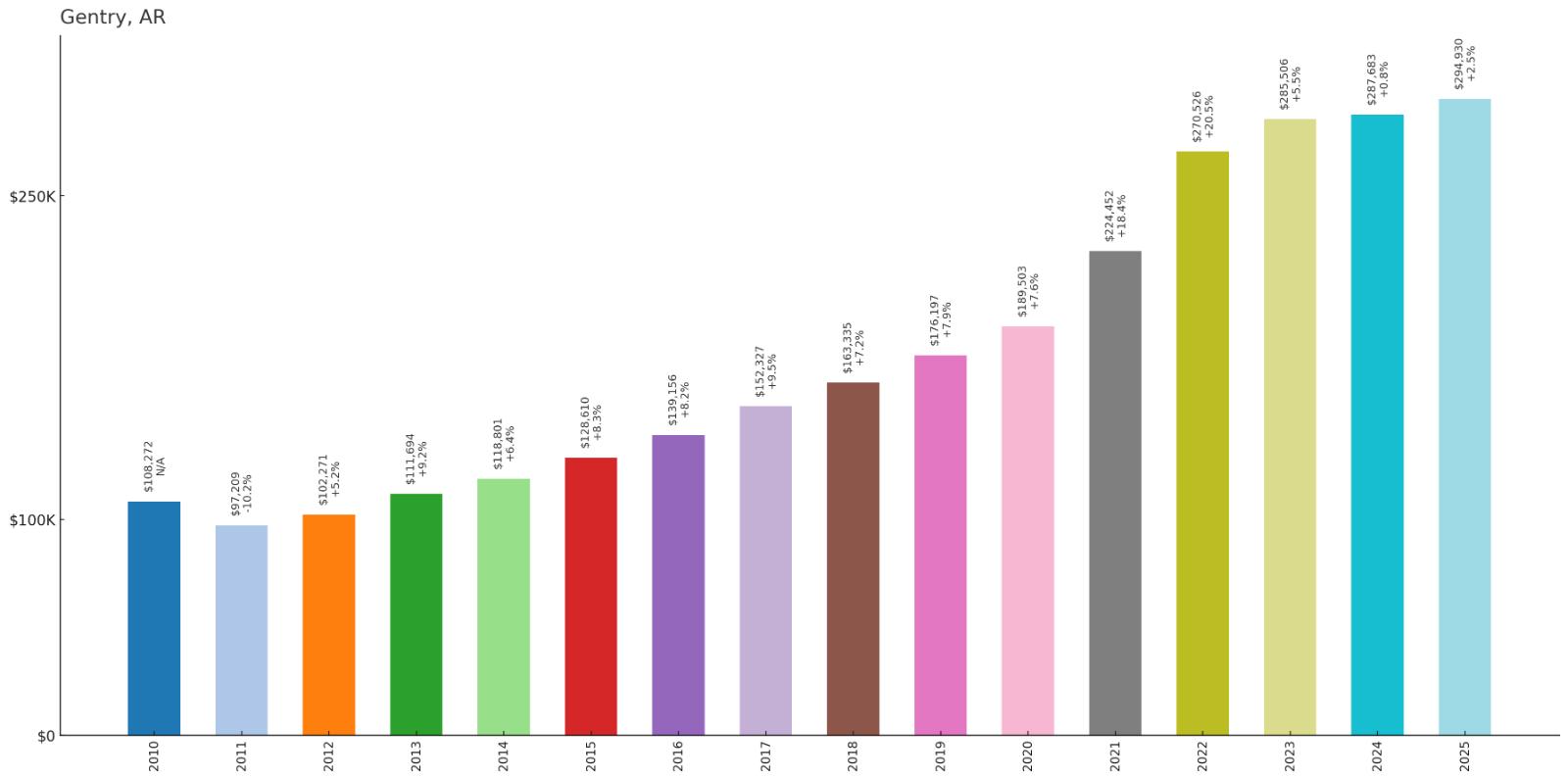
- 2010: $108,272
- 2011: $97,209
- 2012: $102,271
- 2013: $111,694
- 2014: $118,801
- 2015: $128,610
- 2016: $139,156
- 2017: $152,327
- 2018: $163,335
- 2019: $176,197
- 2020: $189,503
- 2021: $224,452
- 2022: $270,526
- 2023: $285,506
- 2024: $287,683
- 2025: $294,930
Gentry’s real estate market shows one of the most dramatic transformations on this list. Home values increased from just $108,272 in 2010 to $294,930 by 2025—a 172% jump. The most explosive growth occurred between 2020 and 2022, when values surged by more than $80,000 in just two years.
Why Gentry?

Why Are People Willing to Pay So Much to Live Here? What’s Special About It?
Gentry attracts buyers with its small-town charm and proximity to the booming Northwest Arkansas economy. The community offers affordable entry points into a desirable region while maintaining a rural character that appeals to families seeking space and tranquility. Many residents appreciate the slower pace of life combined with reasonable access to larger employment centers.
The town’s location in Benton County provides connections to major employers in Bentonville and Rogers without the higher costs associated with living directly in those markets. This has made Gentry particularly attractive to first-time homebuyers and growing families.
How Gentry Rose to Prominence
Gentry was established in the 1890s as a railroad town, serving as a shipping point for local agricultural products and timber. The community remained primarily agricultural through most of the 20th century, with poultry farming becoming a major economic driver. The town’s economy was closely tied to the regional poultry industry and related agricultural businesses.
As Northwest Arkansas transformed into a major economic region centered around Bentonville and Rogers, Gentry’s proximity to these growth centers made it increasingly attractive for residential development. The combination of available land, lower costs, and improving transportation connections helped fuel the town’s recent real estate boom.
3 Interesting Tidbits
- Railroad Heritage – Gentry’s historic depot and railroad connections played a crucial role in the community’s early development and agricultural shipping.
- Poultry Capital – The town sits in the heart of Arkansas’s poultry region, which has been a major economic driver for the area for decades.
- Wild Wilderness Safari – Gentry is home to a drive-through wildlife safari that attracts visitors from across the region, adding to the local economy and community character.
27. Lonsdale – 90% Home Price Increase Since 2010
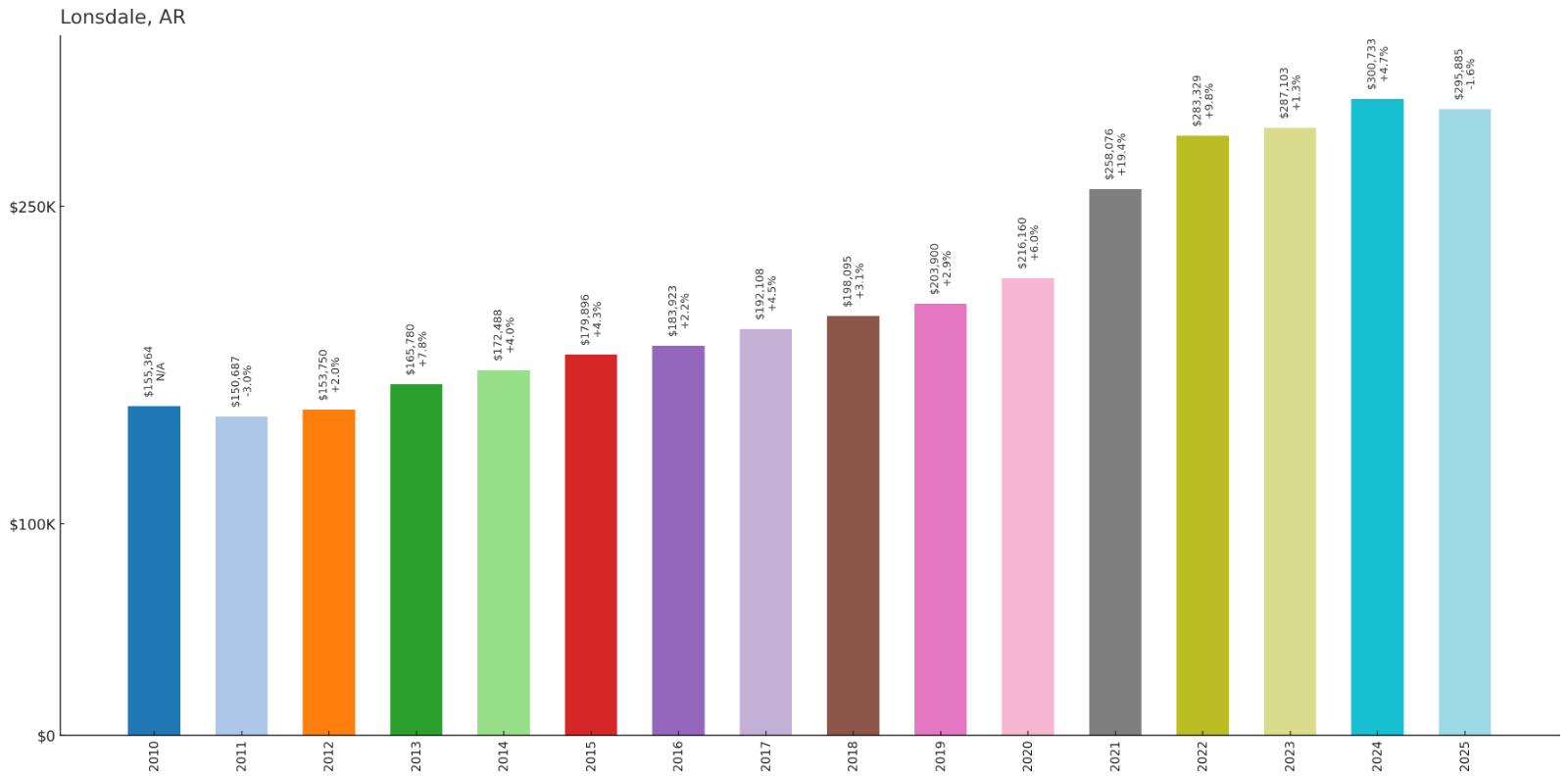
- 2010: $155,364
- 2011: $150,687
- 2012: $153,750
- 2013: $165,780
- 2014: $172,488
- 2015: $179,896
- 2016: $183,923
- 2017: $192,108
- 2018: $198,095
- 2019: $203,900
- 2020: $216,160
- 2021: $258,076
- 2022: $283,329
- 2023: $287,103
- 2024: $300,733
- 2025: $295,885
Lonsdale demonstrated steady appreciation throughout the 2010s before accelerating after 2020. The community’s home values nearly doubled from $155,364 in 2010 to $295,885 in 2025. The sharpest increases came in 2021 and 2022, when prices jumped by more than $65,000 over two years.
Why Lonsdale?
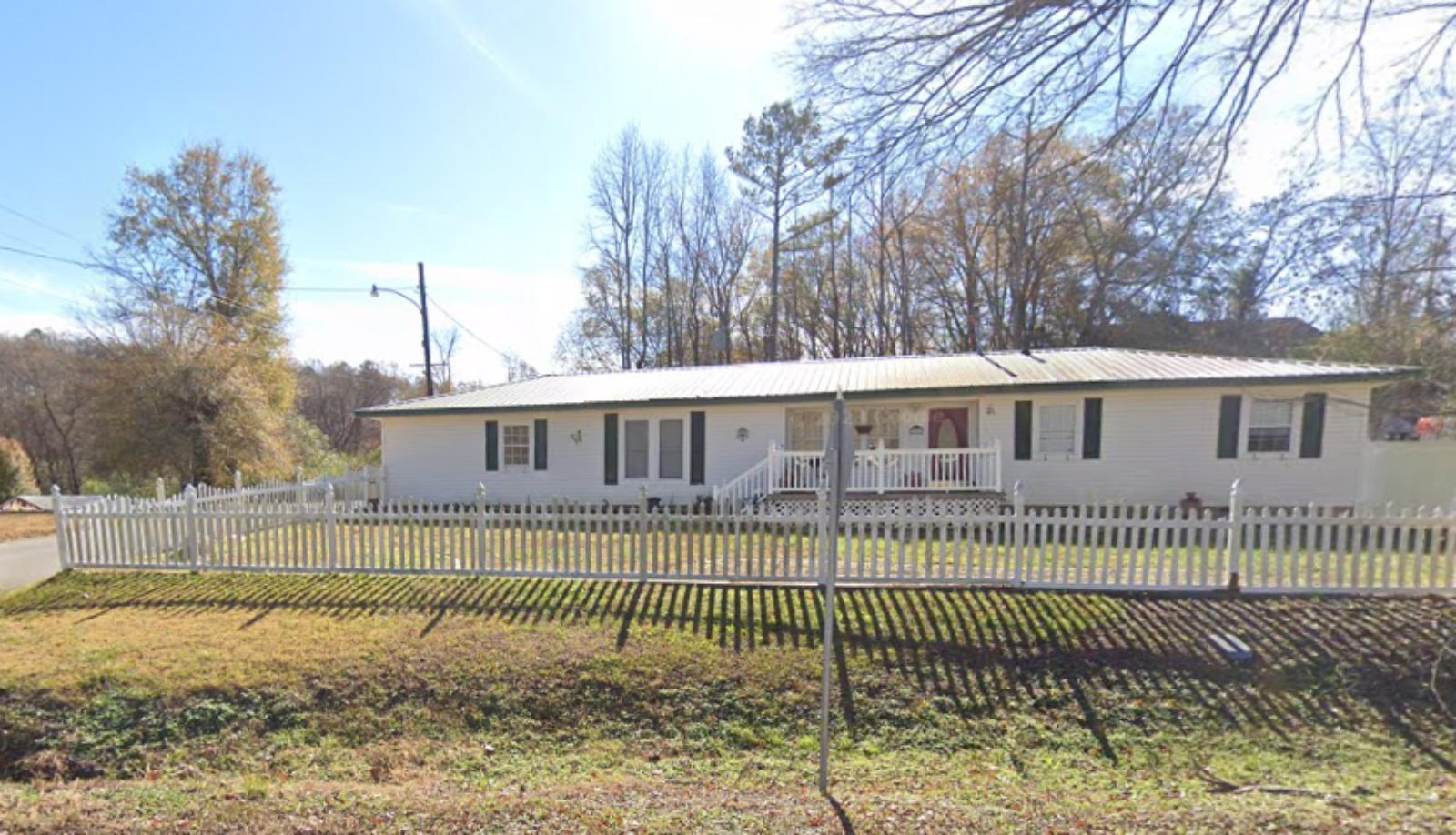
Why Are People Willing to Pay So Much to Live Here? What’s Special About It?
Lonsdale appeals to buyers seeking a rural lifestyle with access to recreational opportunities and reasonable commutes to Hot Springs and Little Rock. The community offers larger lots, privacy, and proximity to outdoor attractions including nearby lakes and natural areas. Residents value the peaceful environment and small-town atmosphere.
The area’s location between Hot Springs and Little Rock provides flexibility for commuters while maintaining a country setting. This strategic positioning has made Lonsdale attractive to people seeking affordable rural living without complete isolation from urban amenities.
How Lonsdale Rose to Prominence
Lonsdale began as a small agricultural community in Garland County, named after an early settler family. The area remained primarily rural through most of its history, with farming and timber as the main economic activities. The community’s development was modest and steady, serving as a quiet residential area for people working in agriculture or nearby towns.
As Hot Springs grew as a tourist destination and Little Rock expanded as a metropolitan center, Lonsdale’s position between these areas became increasingly valuable. The community began attracting residents seeking rural living with access to both recreational opportunities and employment centers, leading to increased development and rising property values.
3 Interesting Tidbits
- Lake Access – Lonsdale provides convenient access to several recreational lakes, making it popular with boating and fishing enthusiasts.
- Timber Heritage – The surrounding area has a long history of timber production, with forestry remaining an important part of the local economy.
- Commuter Haven – Its location between Hot Springs and Little Rock has made Lonsdale a popular choice for commuters seeking rural living.
26. Paron – 60% Home Price Increase Since 2010
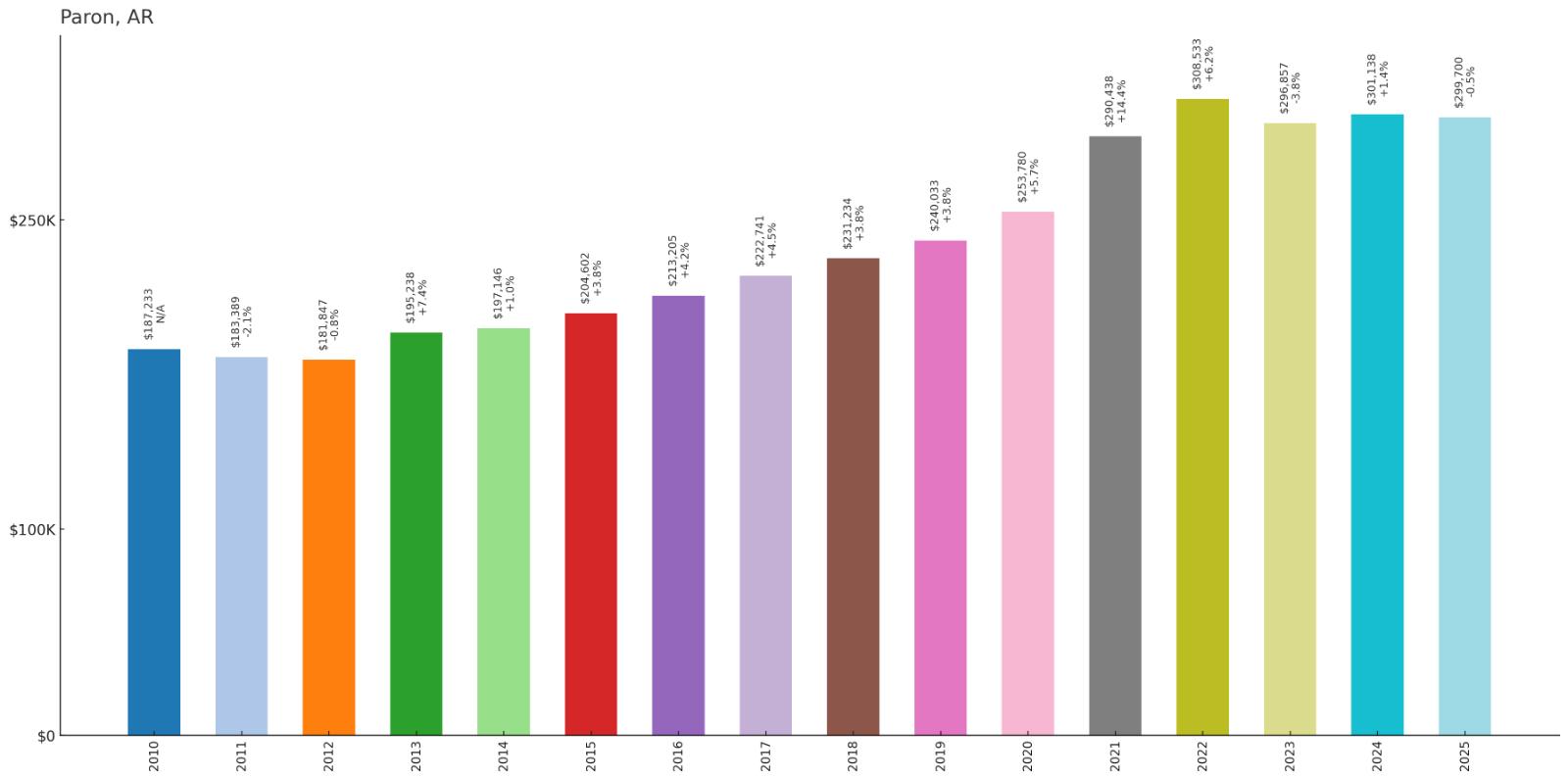
- 2010: $187,233
- 2011: $183,389
- 2012: $181,847
- 2013: $195,238
- 2014: $197,146
- 2015: $204,602
- 2016: $213,205
- 2017: $222,741
- 2018: $231,234
- 2019: $240,033
- 2020: $253,780
- 2021: $290,438
- 2022: $308,533
- 2023: $296,857
- 2024: $301,138
- 2025: $299,700
Paron showed steady but moderate growth throughout the entire 15-year period. Home values increased from $187,233 in 2010 to $299,700 in 2025, representing a 60% gain. The market experienced consistent annual appreciation with the strongest growth occurring during the 2020-2022 period.
Why Paron?
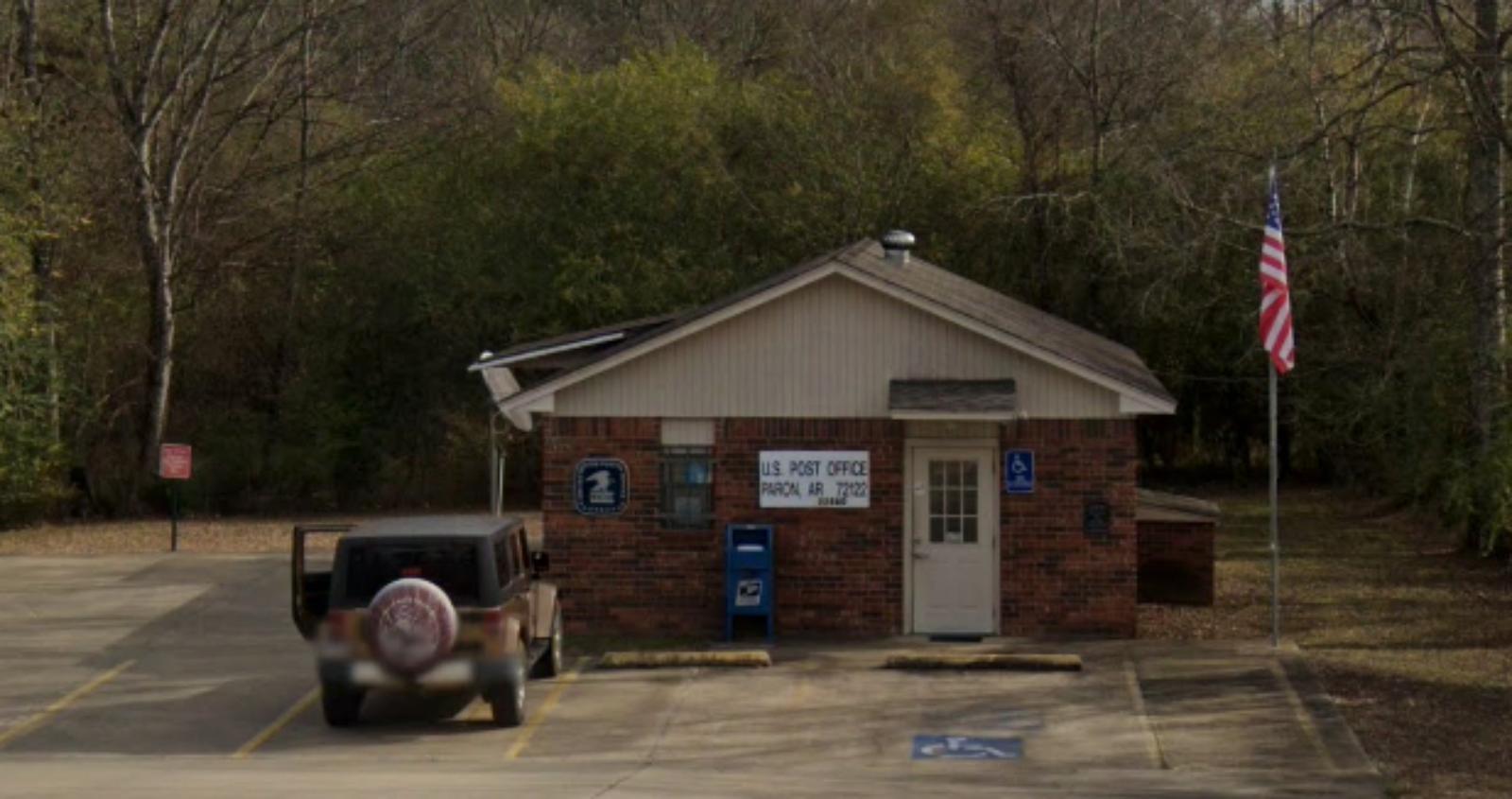
Why Are People Willing to Pay So Much to Live Here? What’s Special About It?
Paron attracts buyers with its rural character and proximity to Little Rock employment opportunities. The unincorporated community offers large lots, custom home sites, and a country lifestyle while maintaining reasonable commute distances to the capital city. Residents appreciate the privacy and space that comes with rural living.
The area’s natural beauty, including forests and rolling terrain, provides an attractive setting for custom homes and residential developments. This combination of rural amenities and urban accessibility has made Paron appealing to professionals and families seeking space and tranquility.
How Paron Rose to Prominence
Paron developed as a rural community in Saline County, historically centered around agriculture and forestry. The area remained sparsely populated through much of the 20th century, with scattered homesteads and small farms characterizing the landscape. The community’s growth was gradual and organic, attracting residents seeking rural living.
As Little Rock’s metropolitan area expanded and commuting became more feasible, Paron began attracting residents looking for rural home sites with access to urban employment. The availability of large tracts of land for custom home development, combined with the area’s natural beauty, helped drive residential growth and property value appreciation.
3 Interesting Tidbits
- Forest Haven – Paron sits amid extensive forested areas that provide natural beauty and recreational opportunities for residents.
- Custom Home Territory – Much of the area’s recent development consists of custom homes built on large lots, taking advantage of the rural setting.
- Commuter Community – The area has become increasingly popular with Little Rock professionals seeking country living within commuting distance.
25. West Fork – 137% Home Price Increase Since 2010
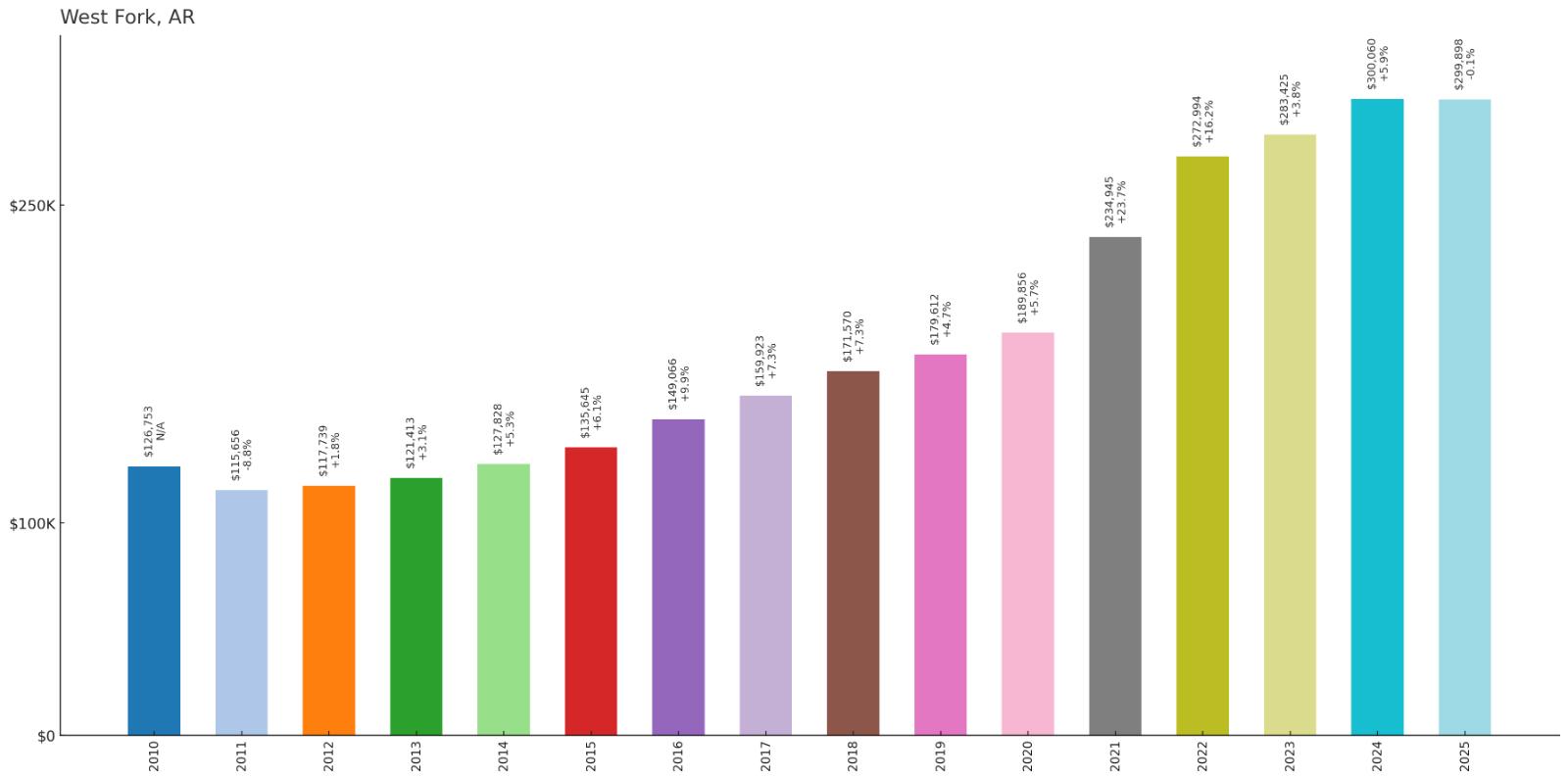
- 2010: $126,753
- 2011: $115,656
- 2012: $117,739
- 2013: $121,413
- 2014: $127,828
- 2015: $135,645
- 2016: $149,066
- 2017: $159,923
- 2018: $171,570
- 2019: $179,612
- 2020: $189,856
- 2021: $234,945
- 2022: $272,994
- 2023: $283,425
- 2024: $300,060
- 2025: $299,898
West Fork experienced remarkable growth, with home values more than doubling from $126,753 in 2010 to $299,898 in 2025. The community showed steady increases throughout the 2010s before accelerating dramatically after 2020. The strongest growth period was 2021-2022, when prices surged by more than $80,000.
Why West Fork?
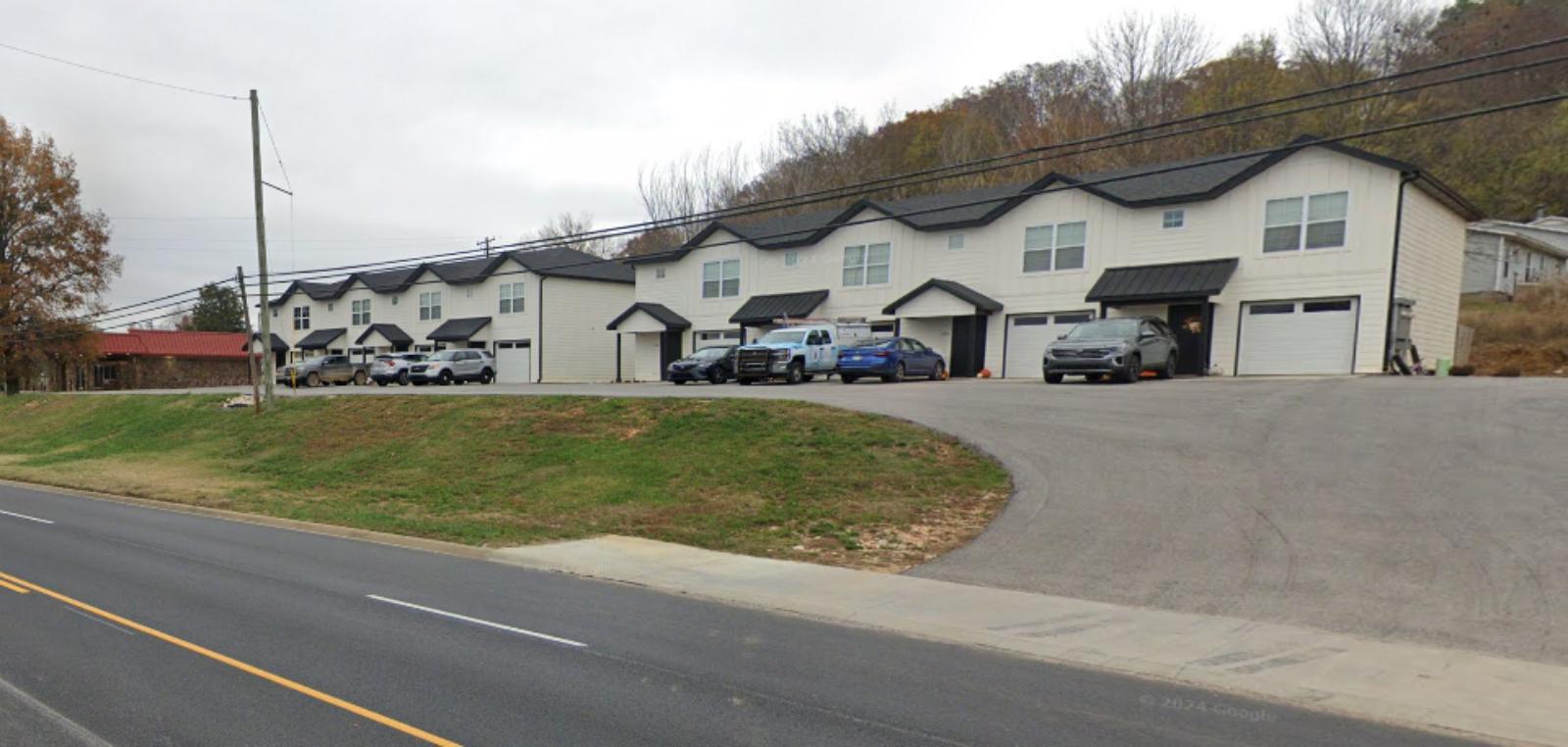
Why Are People Willing to Pay So Much to Live Here? What’s Special About It?
West Fork appeals to buyers seeking small-town living with access to Northwest Arkansas’s economic opportunities. The community offers a rural atmosphere with proximity to Fayetteville and the broader region’s job centers. Families are drawn to the area’s schools, outdoor recreation opportunities, and close-knit community feel.
The town’s location along the West Fork of the White River provides natural amenities and recreational opportunities that enhance its appeal. This combination of community character and natural beauty has made West Fork increasingly attractive to buyers seeking authentic small-town living.
How West Fork Rose to Prominence
West Fork was established in the late 1800s as a small railroad community in Washington County. The town developed around the railroad depot and served as a shipping point for local agricultural products and timber. For much of its history, West Fork remained a quiet rural community with a stable but modest population.
As Northwest Arkansas grew into a major economic region, West Fork’s proximity to Fayetteville and the University of Arkansas made it increasingly attractive for residential development. The town’s authentic small-town character, combined with good schools and outdoor recreation opportunities, began drawing families and professionals seeking community-oriented living.
3 Interesting Tidbits
- Railroad Heritage – West Fork’s historic railroad depot remains a symbol of the community’s transportation history and early development.
- River Town – The West Fork of the White River runs through the community, providing recreational opportunities and natural beauty.
- Agricultural Roots – The surrounding area maintains its agricultural character with working farms and rural landscapes that preserve the community’s heritage.
24. Hot Springs Village – 62% Home Price Increase Since 2010
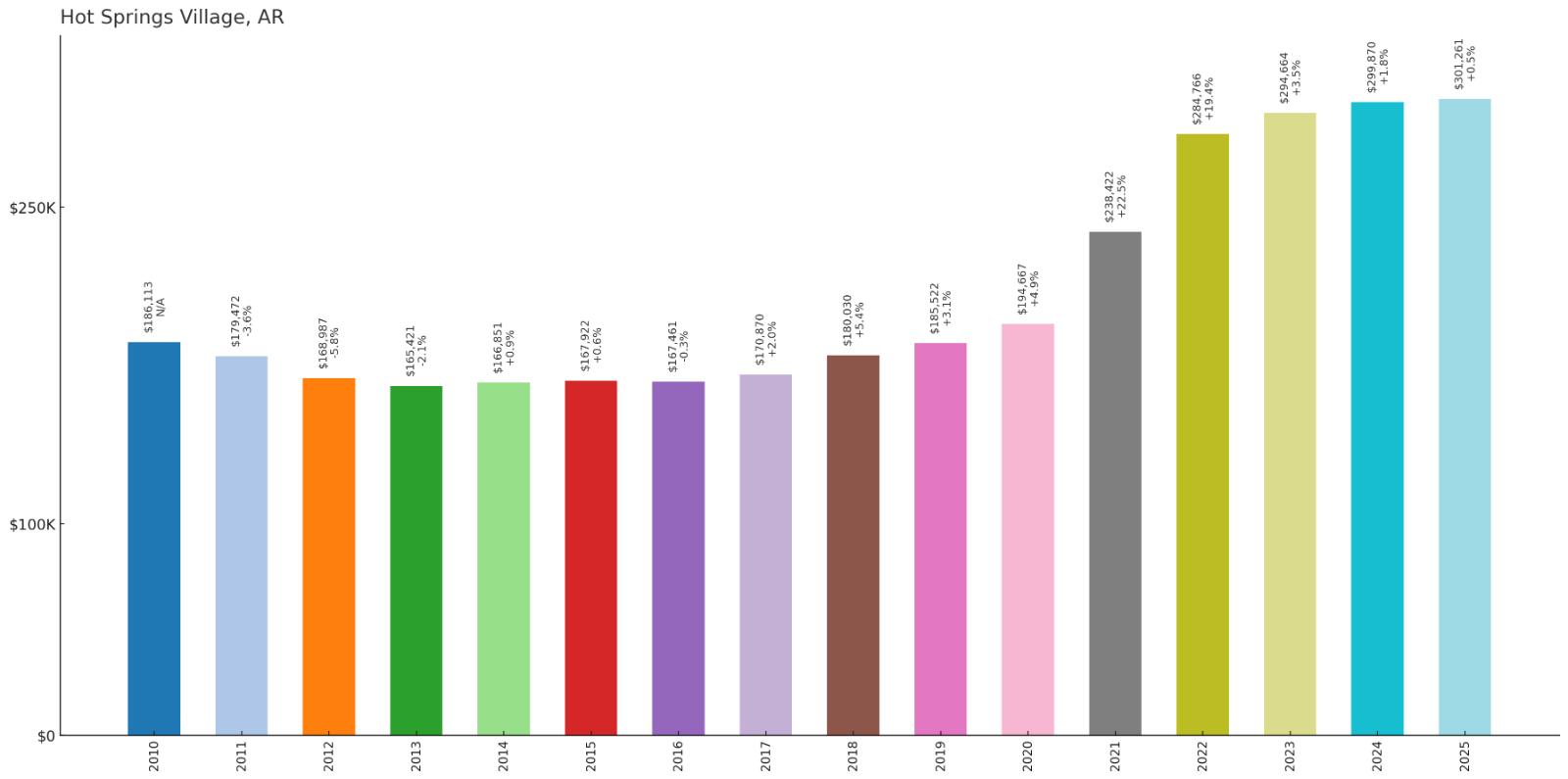
- 2010: $186,113
- 2011: $179,472
- 2012: $168,987
- 2013: $165,421
- 2014: $166,851
- 2015: $167,922
- 2016: $167,461
- 2017: $170,870
- 2018: $180,030
- 2019: $185,522
- 2020: $194,667
- 2021: $238,422
- 2022: $284,766
- 2023: $294,664
- 2024: $299,870
- 2025: $301,261
Hot Springs Village experienced a unique growth pattern, with prices declining through the mid-2010s before recovering strongly after 2018. The community’s home values increased from $186,113 in 2010 to $301,261 in 2025, with the most dramatic growth occurring between 2020 and 2022. This surge added more than $100,000 to home values in just two years.
Why Hot Springs Village?

Why Are People Willing to Pay So Much to Live Here? What’s Special About It?
Hot Springs Village attracts buyers with its resort-style amenities and active adult community atmosphere. The planned community offers golf courses, lakes, recreational facilities, and organized activities that appeal to retirees and second-home buyers. Residents value the comprehensive amenities and maintenance-free lifestyle options.
The community’s gated environment provides security and exclusivity while maintaining proximity to Hot Springs’ attractions and medical facilities. This combination of resort amenities and practical services has made Hot Springs Village particularly appealing to affluent retirees.
How Hot Springs Village Rose to Prominence
Hot Springs Village was developed in the 1970s as a master-planned resort and retirement community. The development was designed to take advantage of the natural beauty of the Ouachita Mountains and the proximity to Hot Springs’ tourism and healthcare facilities. From its inception, the community was planned as an upscale destination for retirees and second-home owners.
The community’s extensive amenities, including multiple golf courses, private lakes, and recreational facilities, established it as one of Arkansas’s premier planned communities. Over the decades, Hot Springs Village has continued to expand and enhance its facilities, maintaining its position as a leading destination for active adult living.
3 Interesting Tidbits
- Golf Paradise – Hot Springs Village features multiple championship golf courses designed by renowned architects, making it a premier golf destination.
- Private Lakes – The community includes several private lakes for residents, offering boating, fishing, and waterfront living opportunities.
- Gated Security – As one of the largest gated communities in the United States, Hot Springs Village provides extensive security and controlled access.
23. Scott – 59% Home Price Increase Since 2010
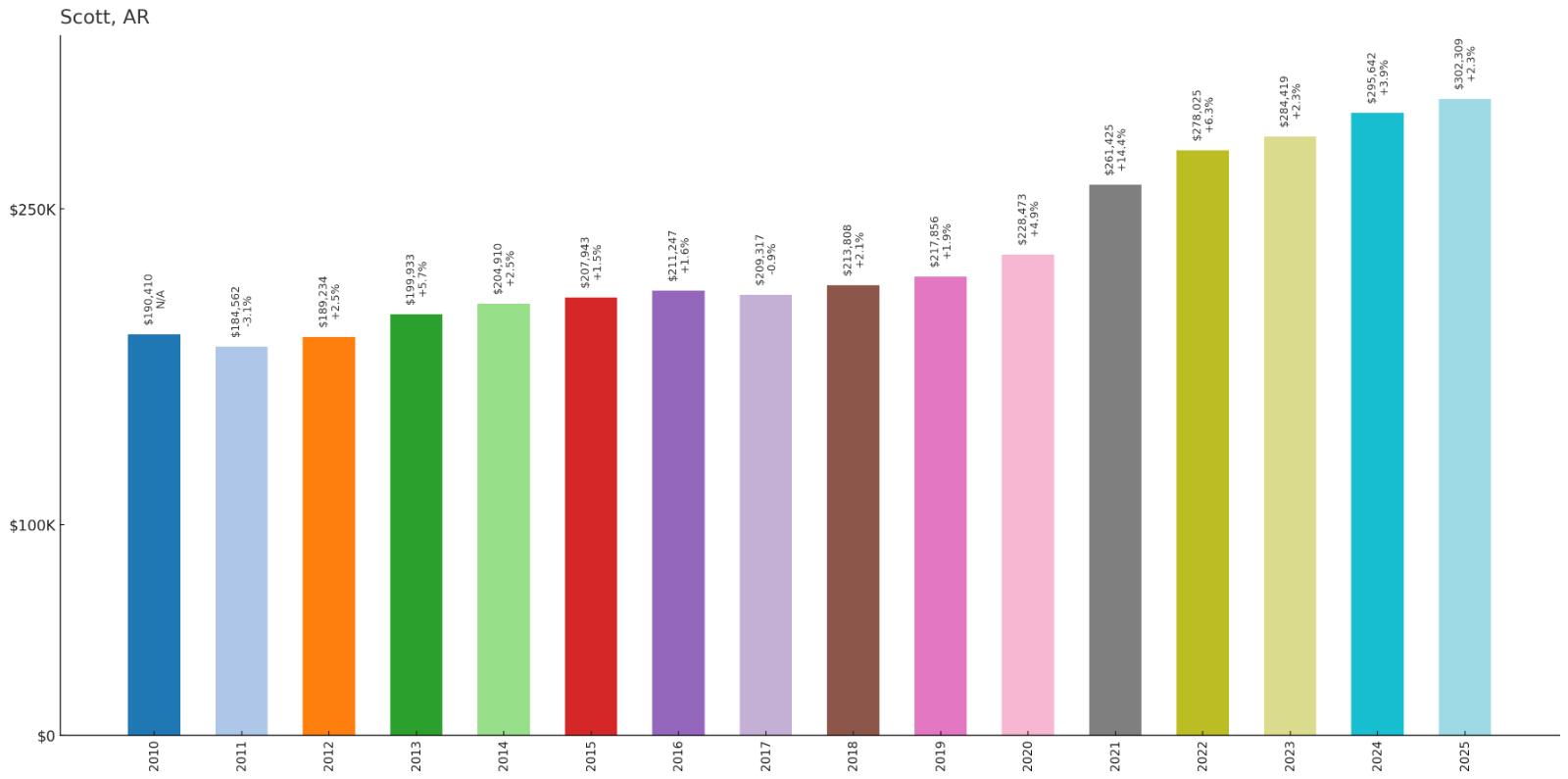
- 2010: $190,410
- 2011: $184,562
- 2012: $189,234
- 2013: $199,933
- 2014: $204,910
- 2015: $207,943
- 2016: $211,247
- 2017: $209,317
- 2018: $213,808
- 2019: $217,856
- 2020: $228,473
- 2021: $261,425
- 2022: $278,025
- 2023: $284,419
- 2024: $295,642
- 2025: $302,309
Scott demonstrated steady growth throughout the entire 15-year period, with home values increasing from $190,410 in 2010 to $302,309 in 2025. The community showed consistent annual appreciation with accelerating growth after 2020. The strongest period was 2021-2022, when values jumped by more than $45,000.
Why Scott?
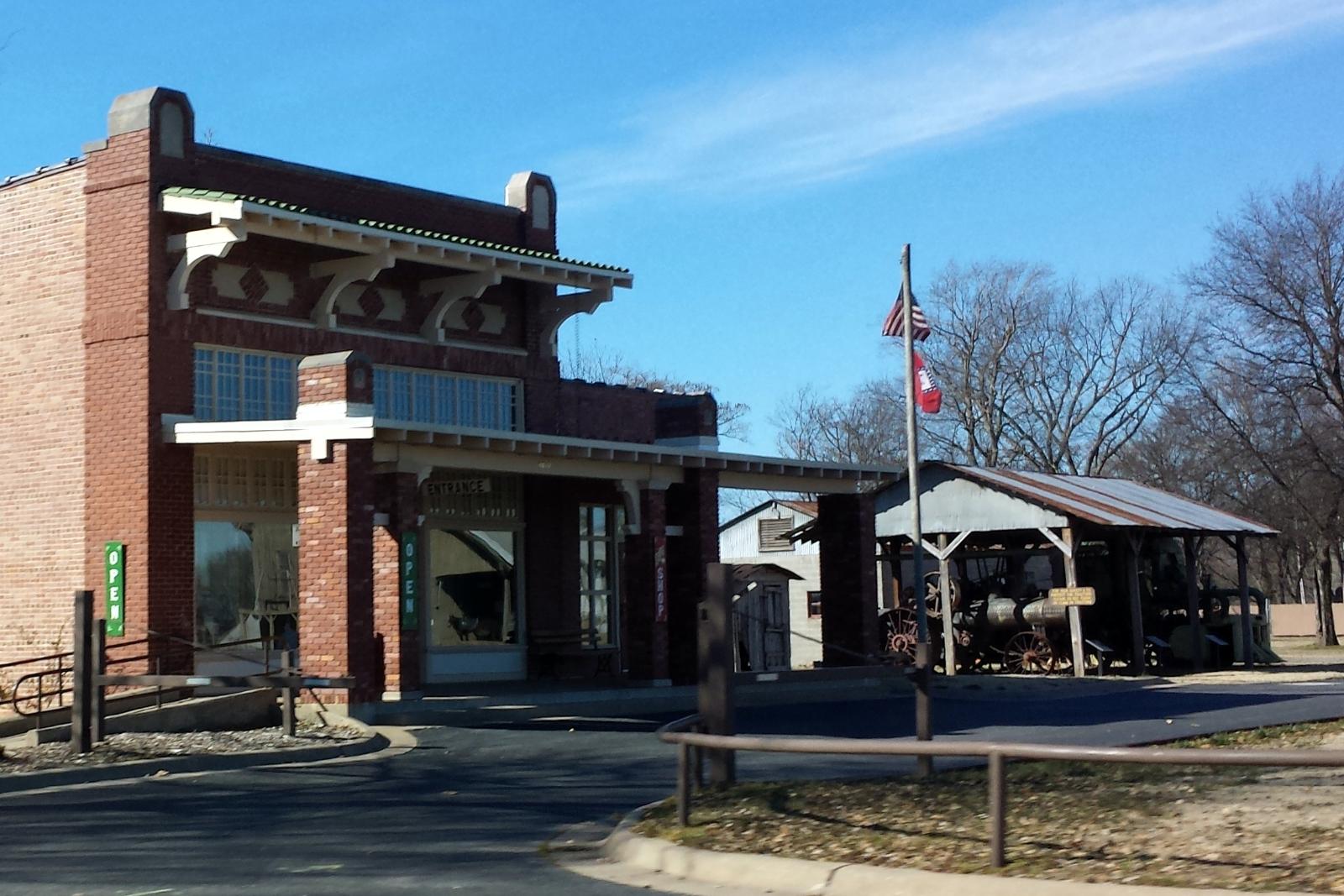
Why Are People Willing to Pay So Much to Live Here? What’s Special About It?
Scott attracts buyers with its rural character and agricultural heritage while providing reasonable access to Little Rock employment centers. The community offers larger lots and country living with the convenience of modern infrastructure and services. Residents appreciate the peaceful environment and strong sense of community.
The area’s location along the Pulaski-Lonoke county line provides strategic access to multiple employment markets while maintaining its rural identity. This balance has made Scott appealing to families and professionals seeking country living without complete isolation.
How Scott Rose to Prominence
Scott developed as an agricultural community in the Arkansas Delta region, with its economy built around farming, particularly cotton and rice production. The area’s fertile soil and strategic location made it an important agricultural center, with farming remaining the primary economic activity through much of the 20th century.
As Little Rock’s metropolitan area expanded and agricultural land became valuable for residential development, Scott began attracting residents seeking rural living with urban access. The community’s agricultural heritage and rural character, combined with improving transportation connections, helped drive residential growth and property value appreciation.
3 Interesting Tidbits
- Delta Heritage – Scott sits in the Arkansas Delta region, known for its rich agricultural soil and farming tradition.
- Plantation History – The area includes several historic plantations that have been preserved as museums, showcasing the region’s agricultural past.
- Agricultural Hub – Farming remains an important part of the local economy, with many residents involved in agriculture or related businesses.
22. Maumelle – 45% Home Price Increase Since 2010
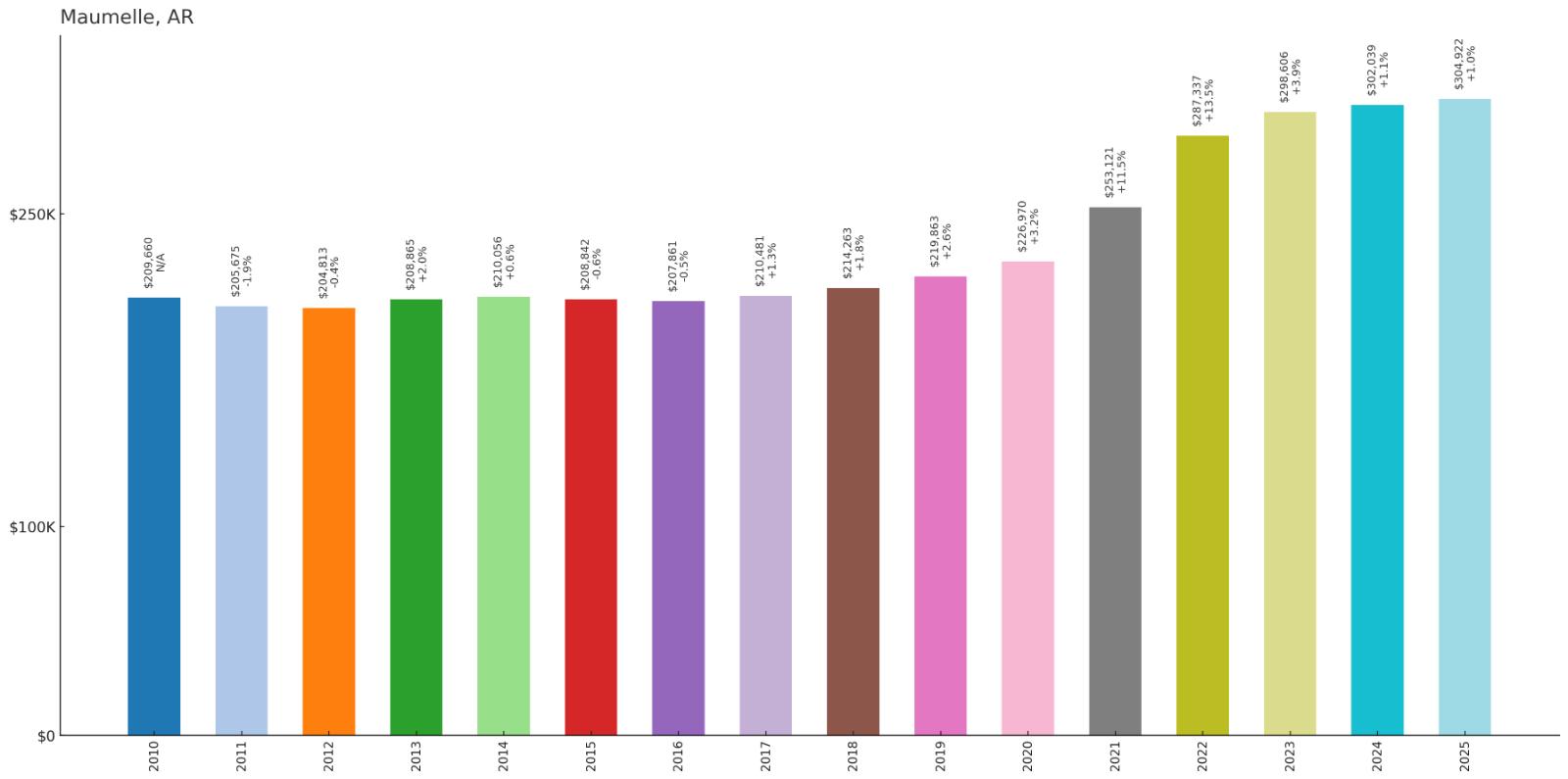
- 2010: $209,660
- 2011: $205,675
- 2012: $204,813
- 2013: $208,865
- 2014: $210,056
- 2015: $208,842
- 2016: $207,861
- 2017: $210,481
- 2018: $214,263
- 2019: $219,863
- 2020: $226,970
- 2021: $253,121
- 2022: $287,337
- 2023: $298,606
- 2024: $302,039
- 2025: $304,922
Maumelle showed the most stable growth pattern among high-value Arkansas markets. Home values increased gradually from $209,660 in 2010 to $304,922 in 2025, representing a 45% gain. The community experienced steady annual appreciation with more modest increases than most other towns on this list.
Why Maumelle?
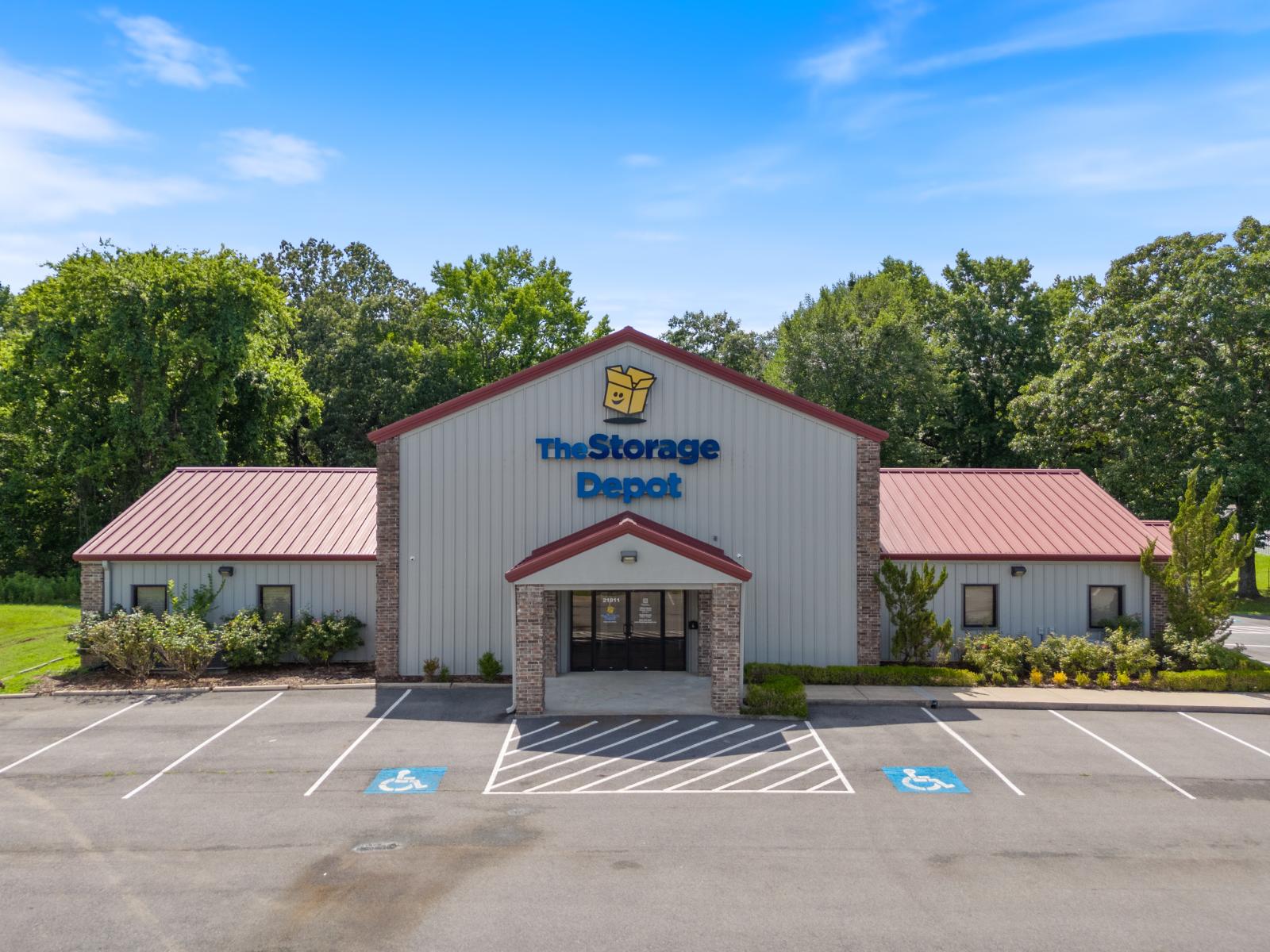
Why Are People Willing to Pay So Much to Live Here? What’s Special About It?
Maumelle appeals to buyers seeking established suburban living with comprehensive amenities and professional management. The planned community offers parks, recreational facilities, and organized activities while maintaining high standards for property maintenance and community appearance. Families value the excellent schools and safe neighborhoods.
The city’s location provides easy access to Little Rock employment centers while maintaining a suburban identity. This combination of convenience and community amenities has made Maumelle consistently attractive to middle and upper-middle-class families.
How Maumelle Rose to Prominence
Maumelle was developed in the 1970s as a master-planned community designed to serve Little Rock’s growing suburban population. The development was carefully planned with residential neighborhoods, commercial areas, and extensive green space. From its inception, Maumelle was designed to be an upscale suburban community with high standards for development and maintenance.
The community’s comprehensive planning and professional management helped it establish a reputation for quality residential living. Over the decades, Maumelle has continued to expand while maintaining its standards, making it one of central Arkansas’s most desirable suburban communities.
3 Interesting Tidbits
- Master Planning – Maumelle was one of Arkansas’s early examples of comprehensive master-planned community development.
- Arkansas River Access – The community features extensive trails and parks along the Arkansas River, providing recreational opportunities and scenic beauty.
- Professional Management – Maumelle maintains professional city management and services that help preserve property values and community standards.
21. Eureka Springs – 94% Home Price Increase Since 2010

- 2010: $157,403
- 2011: $156,714
- 2012: $159,540
- 2013: $160,627
- 2014: $162,024
- 2015: $165,666
- 2016: $170,276
- 2017: $174,868
- 2018: $184,279
- 2019: $192,648
- 2020: $208,249
- 2021: $260,388
- 2022: $299,913
- 2023: $294,922
- 2024: $307,063
- 2025: $305,163
Eureka Springs experienced modest growth through the 2010s before surging dramatically after 2020. Home values nearly doubled from $157,403 in 2010 to $305,163 in 2025. The most explosive growth occurred in 2021 and 2022, when prices jumped by nearly $90,000 in two years.
Why Eureka Springs?
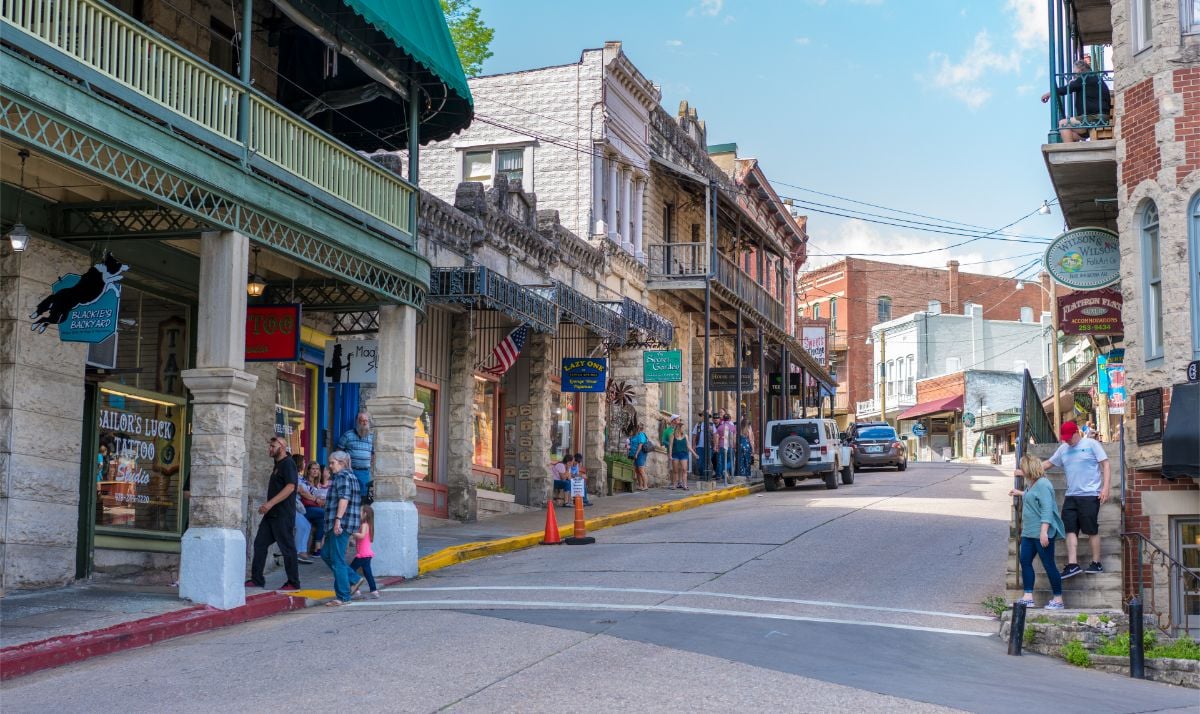
Why Are People Willing to Pay So Much to Live Here? What’s Special About It?
Eureka Springs attracts buyers with its unique Victorian architecture and mountain setting in the Ozarks. The historic town offers a distinctive lifestyle centered around arts, culture, and tourism, appealing to creative professionals and retirees seeking character and community. Residents value the town’s authentic historic charm and cultural amenities.
The community’s tourism economy provides business opportunities while the natural setting offers outdoor recreation and scenic beauty. This combination of cultural attractions and natural amenities has made Eureka Springs particularly appealing to affluent buyers seeking a distinctive lifestyle.
How Eureka Springs Rose to Prominence
Eureka Springs was founded in the 1880s as a health resort town, built around natural springs believed to have healing properties. The Victorian-era boom brought elaborate hotels, ornate homes, and winding streets that followed the mountainous terrain. The town became a popular destination for wealthy visitors seeking the therapeutic benefits of the spring waters.
After the health resort era declined, Eureka Springs reinvented itself as an arts and cultural destination. The preservation of its Victorian architecture, combined with its scenic mountain setting, attracted artists, craftspeople, and cultural enthusiasts. This transformation helped establish the town as a unique tourist destination and desirable place to live.
3 Interesting Tidbits
- No Right Angles – Eureka Springs’ streets follow the natural mountain contours, creating a maze of winding roads with virtually no straight lines or right angles.
- Healing Springs – The town was built around natural springs that attracted thousands of visitors in the late 1800s seeking health benefits from the mineral waters.
- Victorian Treasure – The entire downtown area is listed on the National Register of Historic Places, preserving its unique Victorian architecture and character.
20. Edgemont – 66% Home Price Increase Since 2010
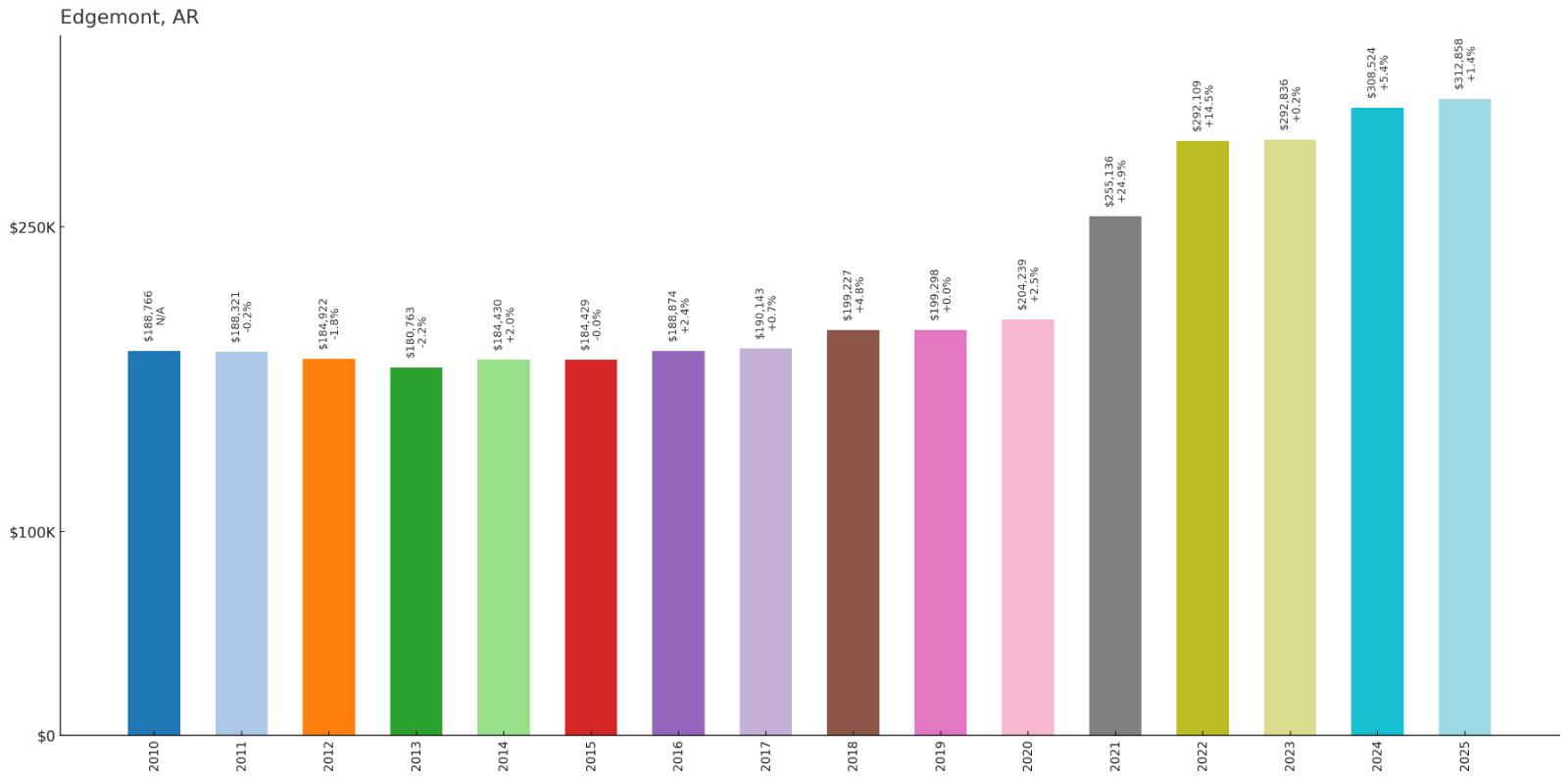
- 2010: $188,766
- 2011: $188,321
- 2012: $184,922
- 2013: $180,763
- 2014: $184,430
- 2015: $184,429
- 2016: $188,874
- 2017: $190,143
- 2018: $199,227
- 2019: $199,298
- 2020: $204,239
- 2021: $255,136
- 2022: $292,109
- 2023: $292,836
- 2024: $308,524
- 2025: $312,858
Edgemont showed relatively flat growth through the 2010s before experiencing a dramatic surge after 2020. Home values remained stable around $185,000-190,000 for nearly a decade before jumping to $312,858 by 2025. The most significant increases came in 2021 and 2022, when prices rose by nearly $90,000.
Why Edgemont?
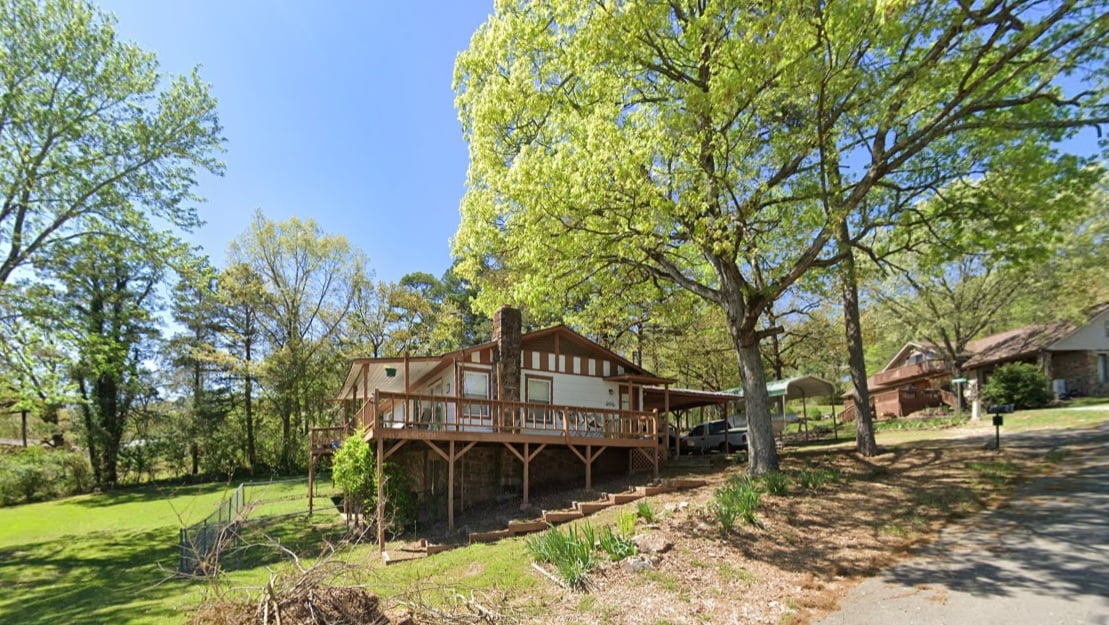
Why Are People Willing to Pay So Much to Live Here? What’s Special About It?
Edgemont attracts buyers seeking lakefront living and outdoor recreation opportunities near Greers Ferry Lake. The unincorporated community offers waterfront properties, boat access, and scenic mountain views that appeal to retirees and second-home buyers. Residents value the peaceful setting and recreational amenities.
The area’s proximity to the lake provides boating, fishing, and water sports opportunities while maintaining a quiet residential character. This combination of natural beauty and recreational access has made Edgemont increasingly attractive to buyers seeking lakefront lifestyle.
How Edgemont Rose to Prominence
Edgemont developed as a small community near Greers Ferry Lake in Cleburne County. The area remained sparsely populated until the completion of Greers Ferry Dam in 1963, which created the large recreational lake that transformed the region. The lake’s creation brought tourism and recreational development to the previously rural area.
As Arkansas’s lake country became increasingly popular for recreation and retirement, Edgemont’s lakefront location made it a prime destination for second homes and permanent residences. The community’s growth has been driven by its scenic setting and access to one of Arkansas’s premier recreational lakes.
3 Interesting Tidbits
- Lake Life Hub – Edgemont sits along Greers Ferry Lake, one of Arkansas’s clearest and most popular recreational lakes.
- Dam Impact – The community’s development was dramatically influenced by the 1963 completion of Greers Ferry Dam, which created the recreational lake.
- Waterfront Living – Many properties in Edgemont offer direct lake access, making it a premier destination for waterfront homes.
19. Prairie Grove – 148% Home Price Increase Since 2010
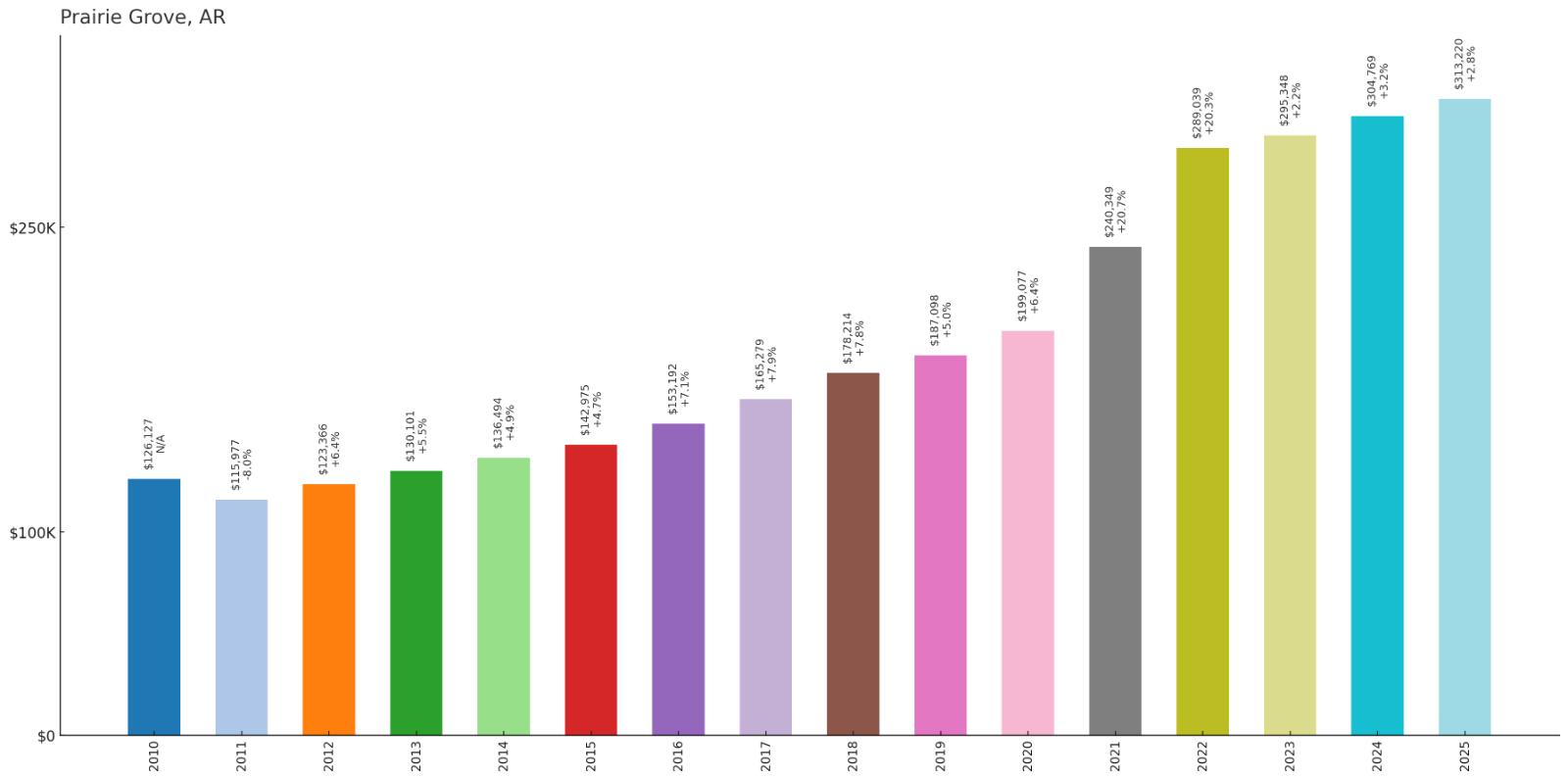
- 2010: $126,127
- 2011: $115,977
- 2012: $123,366
- 2013: $130,101
- 2014: $136,494
- 2015: $142,975
- 2016: $153,192
- 2017: $165,279
- 2018: $178,214
- 2019: $187,098
- 2020: $199,077
- 2021: $240,349
- 2022: $289,039
- 2023: $295,348
- 2024: $304,769
- 2025: $313,220
Prairie Grove experienced steady growth throughout the 2010s before accelerating dramatically after 2020. Home values more than doubled from $126,127 in 2010 to $313,220 in 2025. The strongest growth period was 2021-2022, when prices surged by nearly $90,000 in two years.
Why Prairie Grove?
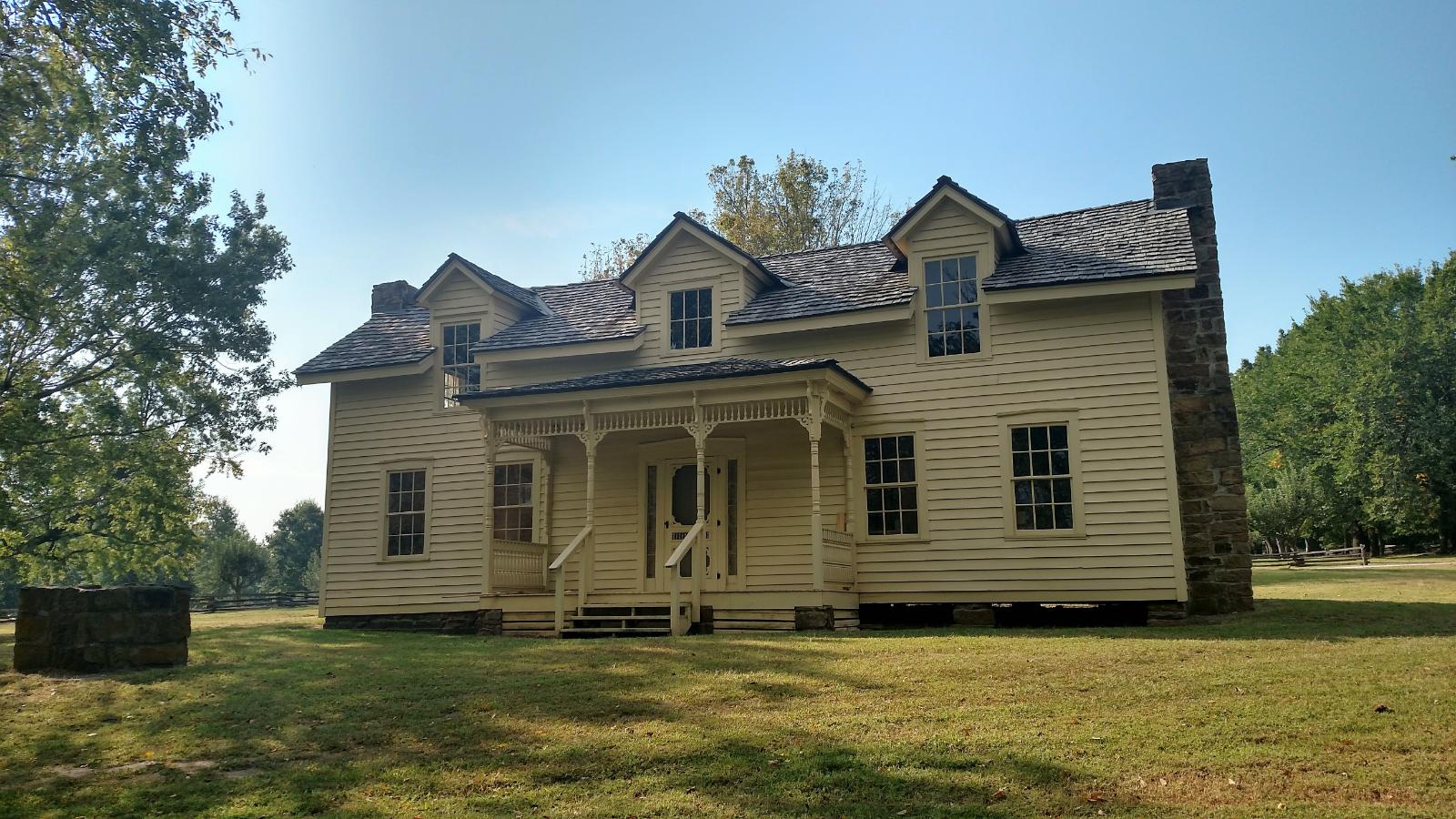
Why Are People Willing to Pay So Much to Live Here? What’s Special About It?
Prairie Grove attracts buyers with its historic charm and proximity to Fayetteville’s employment opportunities. The community offers small-town character with excellent schools and preserved historic sites, appealing to families seeking authentic community living. Residents value the town’s commitment to preserving its Civil War heritage and historic downtown.
The town’s location provides easy access to Northwest Arkansas’s job centers while maintaining its distinct identity and community character. This balance has made Prairie Grove particularly attractive to families and professionals seeking established neighborhoods with history and character.
How Prairie Grove Rose to Prominence
Prairie Grove was established in the 1830s and gained national significance as the site of the Civil War Battle of Prairie Grove in 1862. The town’s historic importance led to the preservation of the battlefield as a state park, which became central to the community’s identity. After the war, Prairie Grove developed as a regional agricultural and educational center.
The community’s proximity to Fayetteville and the University of Arkansas, combined with its preserved historic character, made it increasingly attractive for residential development. Prairie Grove’s commitment to historic preservation while accommodating modern growth has helped it become one of northwest Arkansas’s most desirable small towns.
3 Interesting Tidbits
- Civil War Battlefield – Prairie Grove is home to a preserved Civil War battlefield that attracts thousands of visitors annually and serves as the town’s centerpiece.
- Historic Downtown – The community maintains a well-preserved historic downtown district with antique shops, restaurants, and community events.
- Educational Heritage – Prairie Grove has a long tradition of educational excellence, with the school system serving as a major community asset.
18. Farmington – 126% Home Price Increase Since 2010
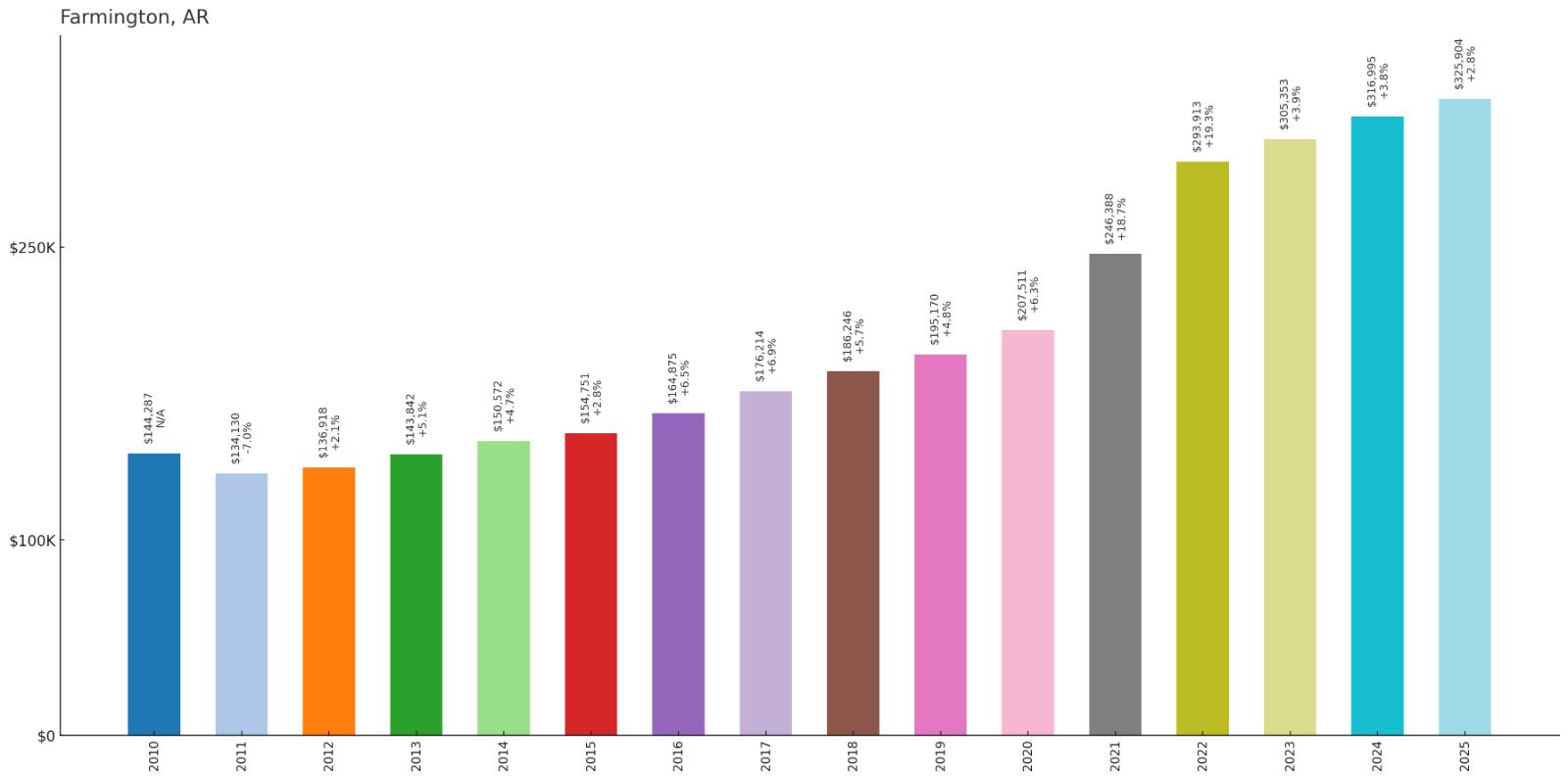
- 2010: $144,287
- 2011: $134,130
- 2012: $136,918
- 2013: $143,842
- 2014: $150,572
- 2015: $154,751
- 2016: $164,875
- 2017: $176,214
- 2018: $186,246
- 2019: $195,170
- 2020: $207,511
- 2021: $246,388
- 2022: $293,913
- 2023: $305,353
- 2024: $316,995
- 2025: $325,904
Farmington showed consistent growth throughout the entire period, with home values more than doubling from $144,287 in 2010 to $325,904 in 2025. The community experienced steady increases through the 2010s before accelerating after 2020. The strongest growth came in 2021-2022, when values jumped by nearly $85,000.
Why Farmington?
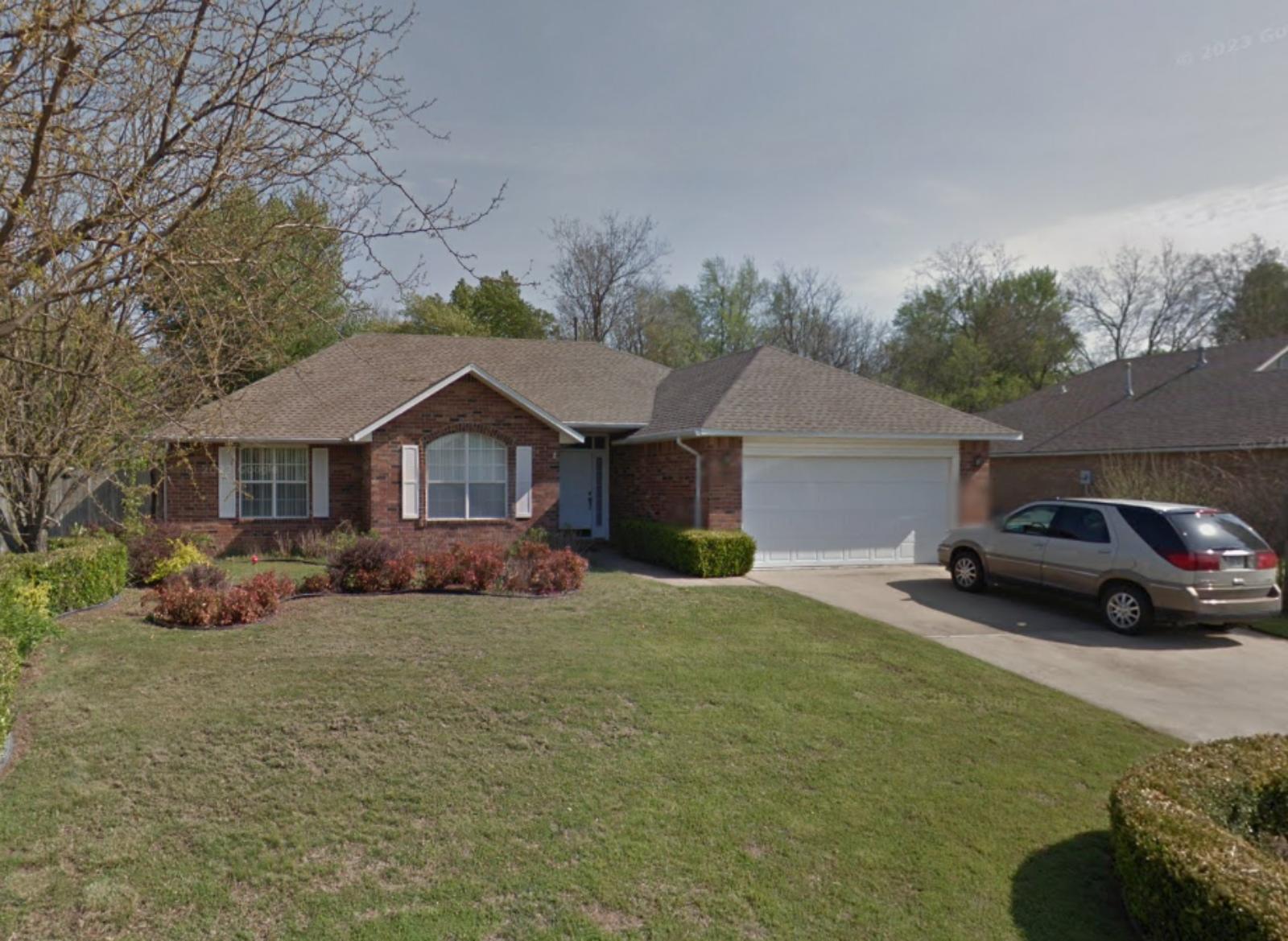
Why Are People Willing to Pay So Much to Live Here? What’s Special About It?
Farmington attracts buyers seeking small-town living with access to Fayetteville’s amenities and employment opportunities. The community offers excellent schools, family-friendly neighborhoods, and a strong sense of community that appeals to growing families. Residents appreciate the town’s commitment to managed growth and quality development.
The town’s location adjacent to Fayetteville provides suburban convenience while maintaining its distinct community identity. This proximity to the University of Arkansas and regional employment centers has made Farmington increasingly attractive to professionals and families.
How Farmington Rose to Prominence
Farmington was incorporated in 1977, making it one of Arkansas’s newer municipalities. The town developed as a suburban community serving Fayetteville’s expanding population, with careful planning from its inception. The community was designed to balance residential growth with preservation of its rural character and small-town atmosphere.
As Northwest Arkansas grew into a major economic region, Farmington’s strategic location and commitment to quality development made it increasingly attractive for families and professionals. The town’s emphasis on excellent schools, parks, and community amenities helped establish it as one of the region’s most desirable suburban communities.
3 Interesting Tidbits
- Young Municipality – Farmington was incorporated in 1977, making it one of Arkansas’s newer cities with modern planning from its start.
- School Excellence – The Farmington School District is highly rated and serves as a major attraction for families moving to the area.
- Managed Growth – The community has carefully managed its growth to preserve small-town character while accommodating new residents.
17. Springdale – 148% Home Price Increase Since 2010
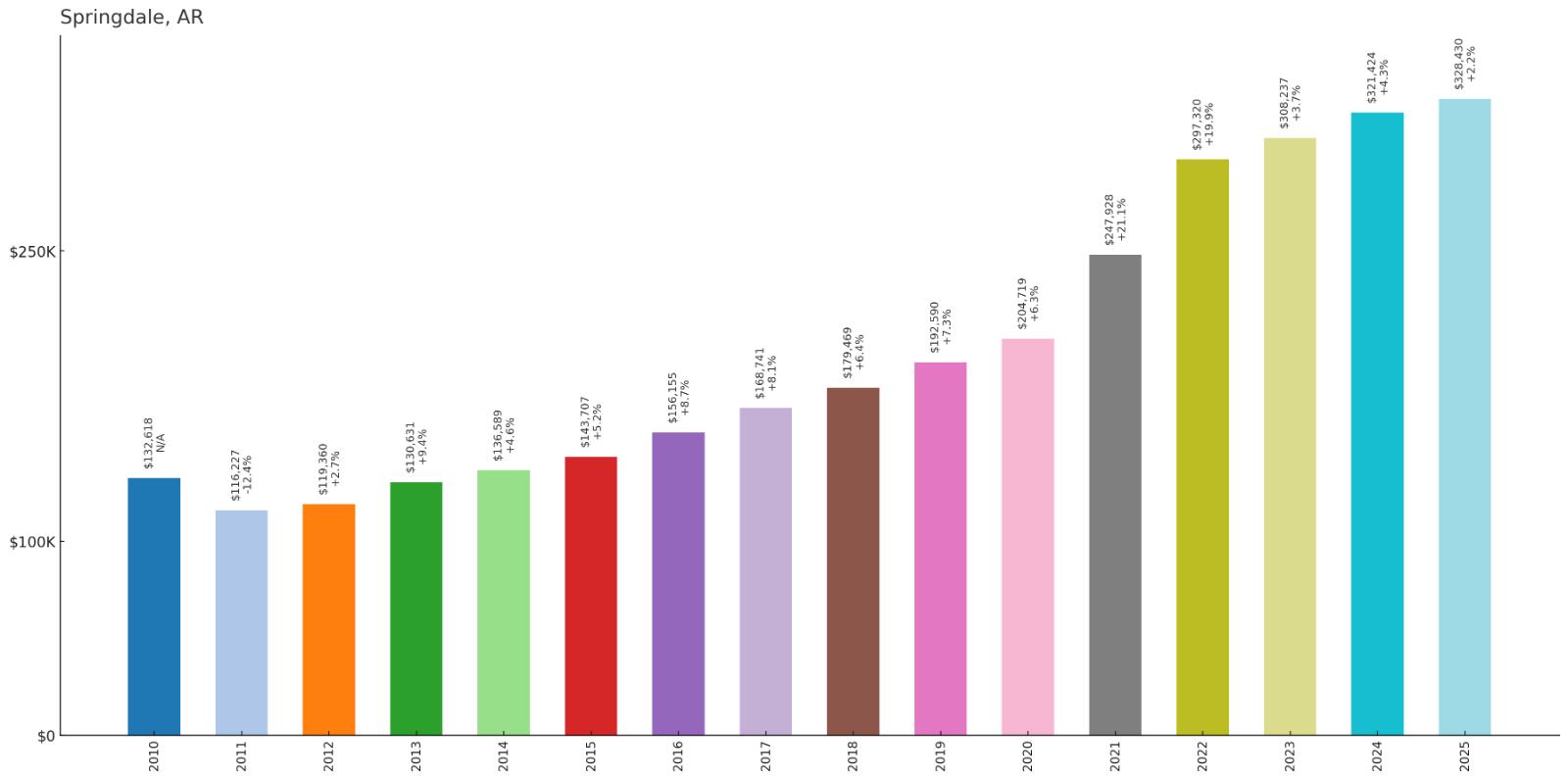
- 2010: $132,618
- 2011: $116,227
- 2012: $119,360
- 2013: $130,631
- 2014: $136,589
- 2015: $143,707
- 2016: $156,155
- 2017: $168,741
- 2018: $179,469
- 2019: $192,590
- 2020: $204,719
- 2021: $247,928
- 2022: $297,320
- 2023: $308,237
- 2024: $321,424
- 2025: $328,430
Springdale demonstrated remarkable growth, with home values more than doubling from $132,618 in 2010 to $328,430 in 2025. After initial declines in 2011-2012, the market recovered strongly and accelerated throughout the decade. The most dramatic increases came in 2021-2022, when prices surged by nearly $90,000.
Why Springdale?

Why Are People Willing to Pay So Much to Live Here? What’s Special About It?
Springdale attracts buyers with its central location in Northwest Arkansas and access to major employers like Tyson Foods. The city offers diverse neighborhoods, good schools, and extensive amenities while maintaining more affordable pricing than nearby Bentonville or Fayetteville. Residents value the community’s cultural diversity and economic opportunities.
The city’s position as a transportation hub and employment center provides job opportunities and convenient access to the broader region. This combination of economic vitality and residential amenities has made Springdale increasingly attractive to families and professionals.
How Springdale Rose to Prominence
Springdale was established in the 1870s as a railroad town, serving as a shipping point for the region’s agricultural products. The community grew steadily as a regional center for agriculture and transportation. The arrival of major employers like Tyson Foods helped transform Springdale into an important economic hub.
As Northwest Arkansas developed into a major economic region, Springdale’s central location and diverse economy made it a key player in the area’s growth. The city has continued to expand and diversify, attracting new residents and businesses while maintaining its role as a regional economic center.
3 Interesting Tidbits
- Poultry Capital – Springdale is home to Tyson Foods headquarters, making it central to Arkansas’s poultry industry.
- Transportation Hub – The city serves as a major transportation and logistics center for Northwest Arkansas.
- Cultural Diversity – Springdale has one of the most diverse populations in Arkansas, with significant Hispanic and Marshallese communities.
16. Bethel Heights – 140% Home Price Increase Since 2010

- 2010: $141,422
- 2011: $123,228
- 2012: $129,120
- 2013: $138,786
- 2014: $150,936
- 2015: $157,070
- 2016: $168,121
- 2017: $181,242
- 2018: $193,273
- 2019: $204,378
- 2020: $218,221
- 2021: $263,790
- 2022: $318,190
- 2023: $331,421
- 2024: $335,813
- 2025: $339,307
Bethel Heights experienced exceptional growth, with home values more than doubling from $141,422 in 2010 to $339,307 in 2025. After recovering from early-decade declines, the community showed consistent appreciation through the 2010s before surging after 2020. The strongest period was 2021-2022, when values jumped by more than $100,000.
Why Bethel Heights?
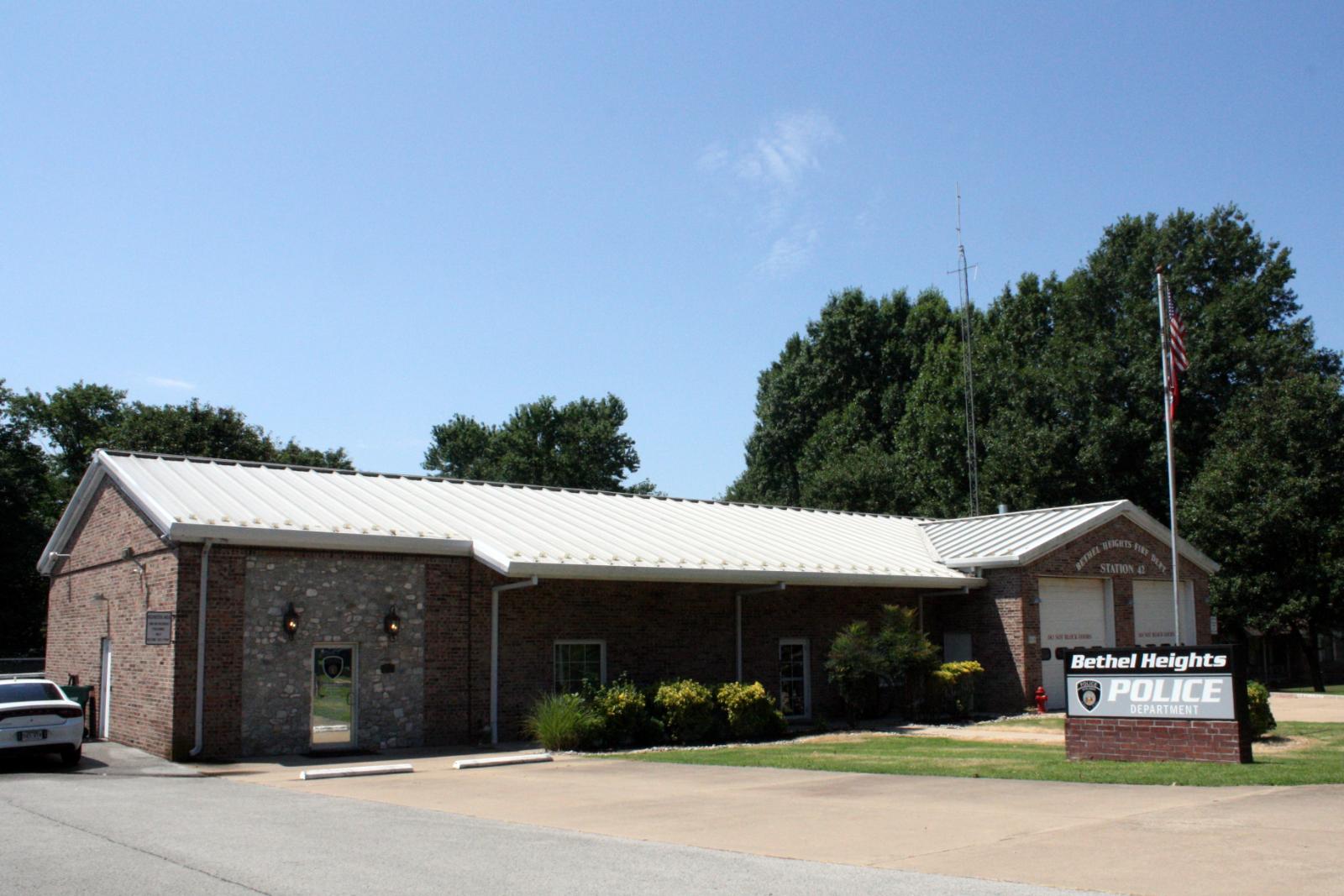
Why Are People Willing to Pay So Much to Live Here? What’s Special About It?
Bethel Heights attracts buyers with its strategic location between major Northwest Arkansas employment centers and excellent schools. The community offers newer developments and suburban amenities while maintaining reasonable commute times to Bentonville, Rogers, and Fayetteville. Families value the area’s growth potential and modern infrastructure.
The town’s position north of Springdale provides access to the region’s job markets while offering space for new residential development. This combination of location and growth opportunity has made Bethel Heights increasingly attractive to families and professionals.
How Bethel Heights Rose to Prominence
Bethel Heights developed as a small rural community in northern Benton County, remaining largely agricultural through most of the 20th century. The area began experiencing residential growth as Northwest Arkansas’s economy expanded and suburban development spread outward from established centers.
The community’s incorporation and subsequent development coincided with the region’s transformation into a major economic hub. Bethel Heights’ strategic location and available land for development made it an attractive option for residential growth, leading to steady appreciation in property values.
3 Interesting Tidbits
- Strategic Location – Bethel Heights sits at the intersection of major highways, providing convenient access to multiple employment centers.
- New Development – Much of the community consists of newer residential developments that take advantage of modern planning and infrastructure.
- School District – The area is served by highly-rated school districts that attract families to the community.
15. Johnson – 128% Home Price Increase Since 2010
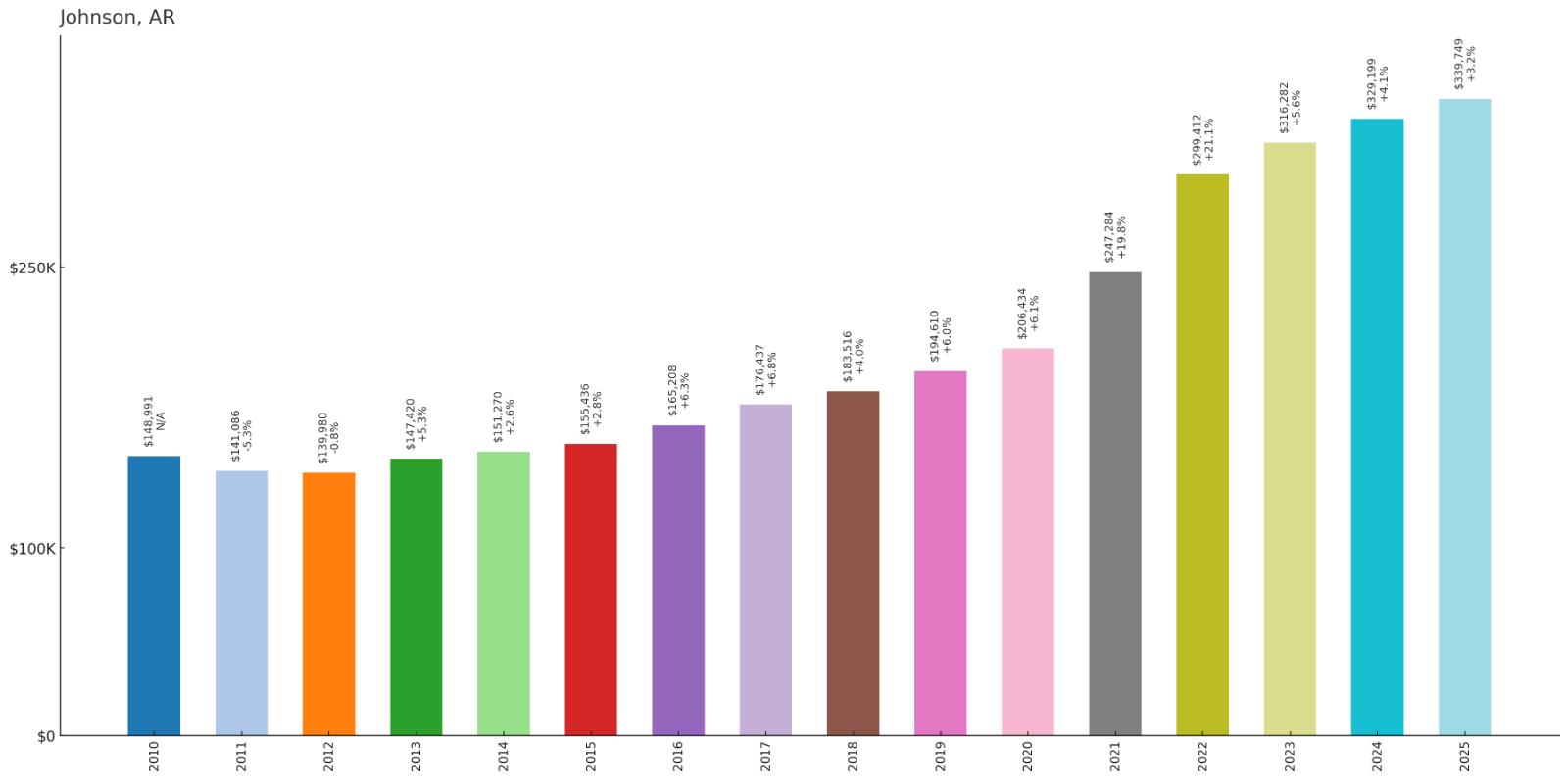
- 2010: $148,991
- 2011: $141,086
- 2012: $139,980
- 2013: $147,420
- 2014: $151,270
- 2015: $155,436
- 2016: $165,208
- 2017: $176,437
- 2018: $183,516
- 2019: $194,610
- 2020: $206,434
- 2021: $247,284
- 2022: $299,412
- 2023: $316,282
- 2024: $329,199
- 2025: $339,749
Johnson showed steady appreciation throughout the entire period, with home values more than doubling from $148,991 in 2010 to $339,749 in 2025. The community experienced consistent growth through the 2010s before accelerating significantly after 2020. The strongest increases came in 2021-2022, when prices jumped by more than $90,000.
Why Johnson?
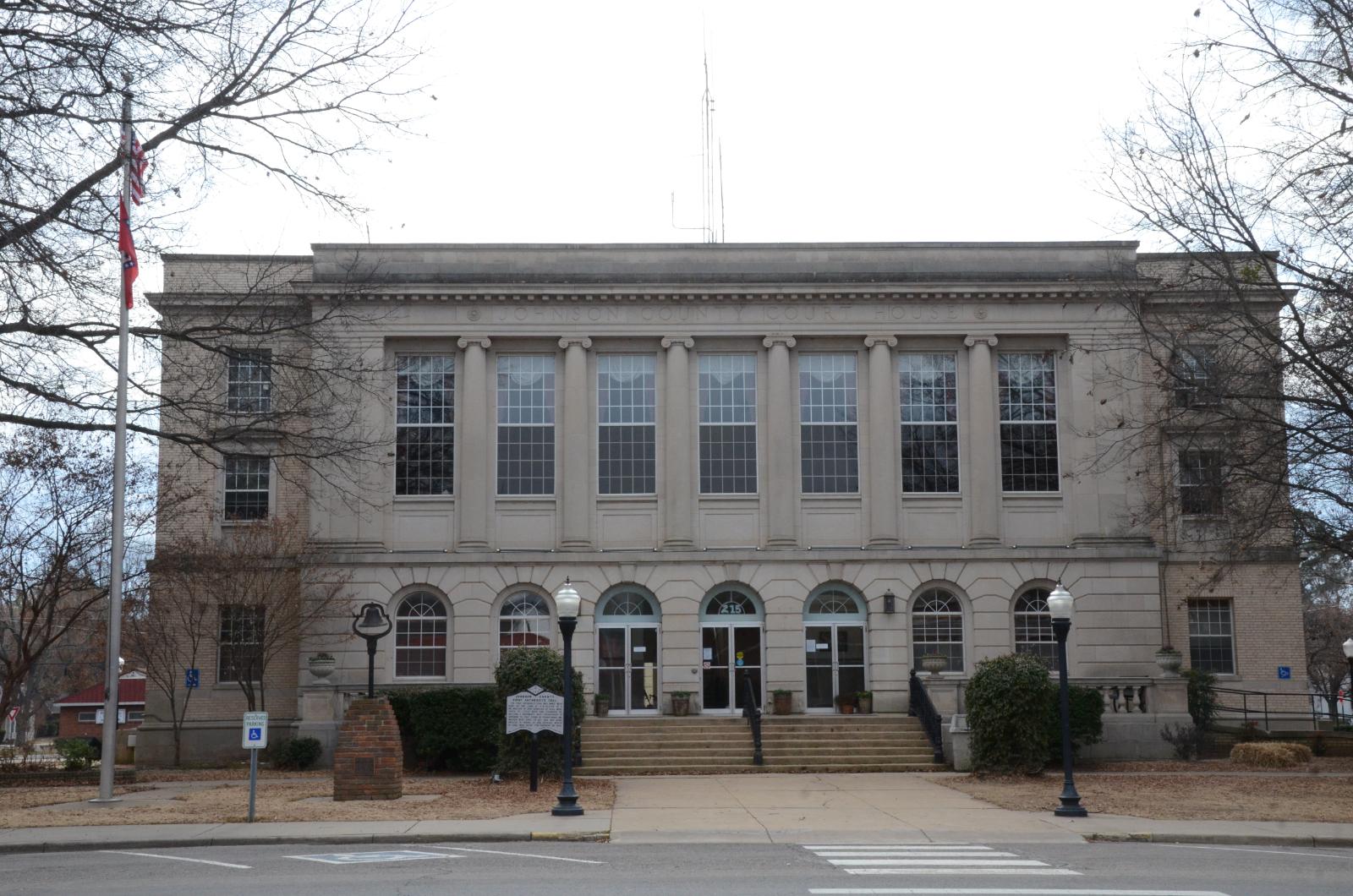
Why Are People Willing to Pay So Much to Live Here? What’s Special About It?
Johnson attracts buyers with its prime location along the I-49 corridor between Fayetteville and Springdale. The community offers suburban living with easy access to the University of Arkansas and major employment centers throughout Northwest Arkansas. Residents value the convenient location and access to urban amenities.
The town’s position provides the benefits of suburban living while maintaining short commute times to multiple job markets. This strategic advantage has made Johnson increasingly attractive to professionals and families seeking convenience and accessibility.
How Johnson Rose to Prominence
Johnson developed as a small community in Washington County, strategically located along major transportation routes connecting Fayetteville and Springdale. The area remained primarily agricultural through much of the 20th century, with modest residential development serving local families.
As Northwest Arkansas grew into a major economic region and Interstate 49 improved transportation connections, Johnson’s central location became increasingly valuable. The community began attracting residents who wanted convenient access to multiple employment centers while maintaining suburban living, leading to steady growth and property appreciation.
3 Interesting Tidbits
- Corridor Position – Johnson sits along the busy I-49 corridor that connects all of Northwest Arkansas’s major cities.
- University Access – The community provides easy access to the University of Arkansas and its associated employment opportunities.
- Central Hub – Johnson’s location makes it convenient to reach any major Northwest Arkansas destination within 20 minutes.
14. Pea Ridge – 176% Home Price Increase Since 2010
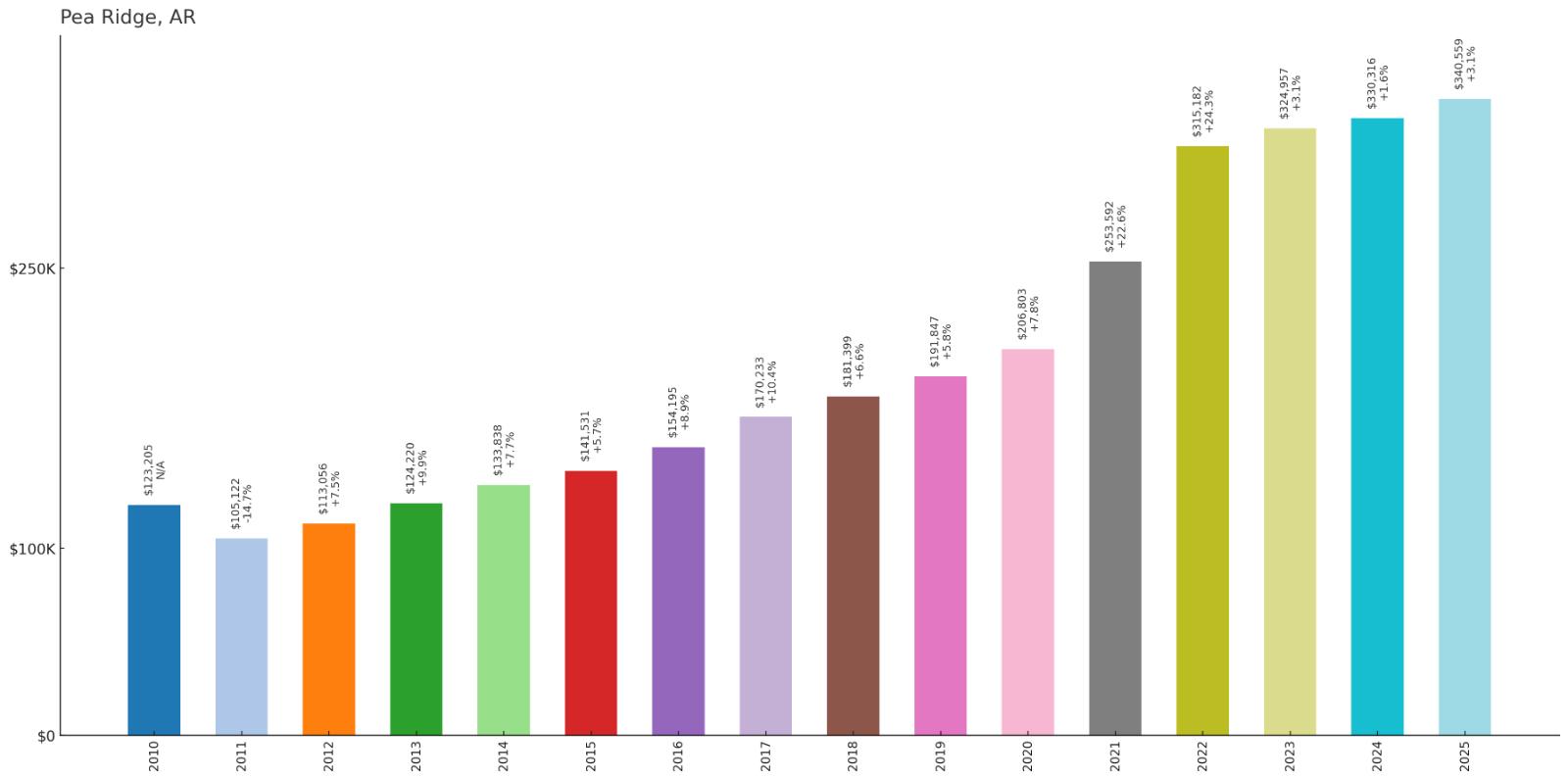
- 2010: $123,205
- 2011: $105,122
- 2012: $113,056
- 2013: $124,220
- 2014: $133,838
- 2015: $141,531
- 2016: $154,195
- 2017: $170,233
- 2018: $181,399
- 2019: $191,847
- 2020: $206,803
- 2021: $253,592
- 2022: $315,182
- 2023: $324,957
- 2024: $330,316
- 2025: $340,559
Pea Ridge demonstrated exceptional growth, with home values nearly tripling from $123,205 in 2010 to $340,559 in 2025. After recovering from early-decade declines, the community showed consistent appreciation through the 2010s before exploding after 2020. The strongest period was 2021-2022, when prices surged by more than $85,000.
Why Pea Ridge?
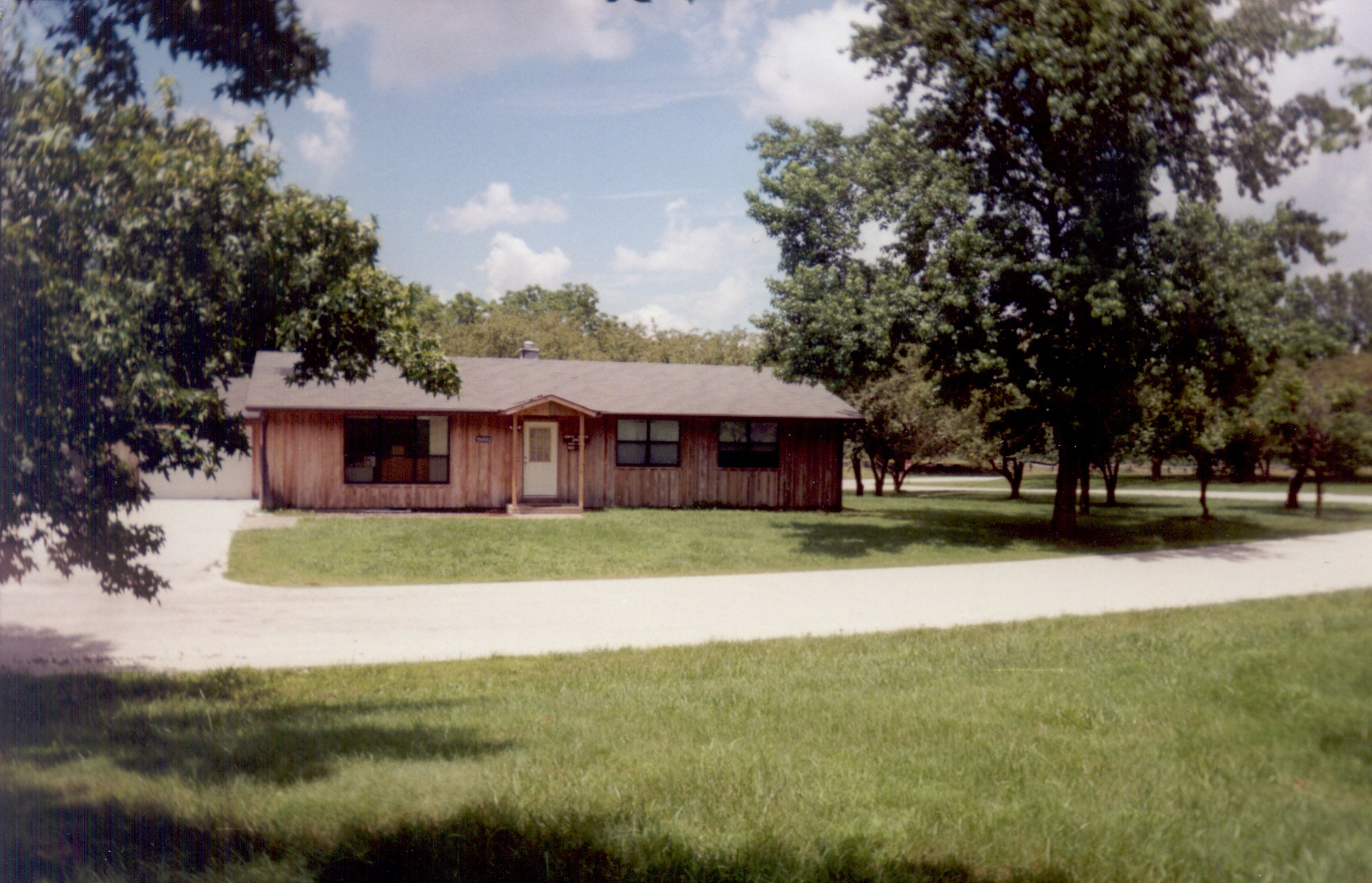
Why Are People Willing to Pay So Much to Live Here? What’s Special About It?
Pea Ridge attracts buyers with its historic significance and proximity to major Northwest Arkansas employment centers. The community offers small-town living with access to preserved Civil War battlefields and outdoor recreation, appealing to families seeking character and history. Residents value the town’s commitment to preserving its heritage while accommodating growth.
The town’s location provides reasonable access to Bentonville and Rogers while maintaining a distinct community identity. This combination of historical character and modern convenience has made Pea Ridge increasingly attractive to buyers seeking authentic small-town living.
How Pea Ridge Rose to Prominence
Pea Ridge gained national significance as the site of the Civil War Battle of Pea Ridge in 1862, which secured Missouri for the Union. The battlefield was later preserved as a national military park, becoming central to the community’s identity. After the war, Pea Ridge developed as a small agricultural and trading center.
As Northwest Arkansas grew into a major economic region, Pea Ridge’s proximity to Bentonville and Rogers, combined with its preserved historic character, made it increasingly attractive for residential development. The community has worked to balance growth with historic preservation, creating an appealing environment for families and professionals.
3 Interesting Tidbits
- Civil War Battlefield – Pea Ridge National Military Park preserves the site of a crucial 1862 Civil War battle that shaped the war in the Trans-Mississippi region.
- Historic Downtown – The community maintains a historic downtown area that reflects its 19th-century origins and small-town character.
- Apple Festival – Pea Ridge hosts an annual Apple Festival that celebrates the area’s agricultural heritage and brings visitors from across the region.
13. Gravette – 252% Home Price Increase Since 2010
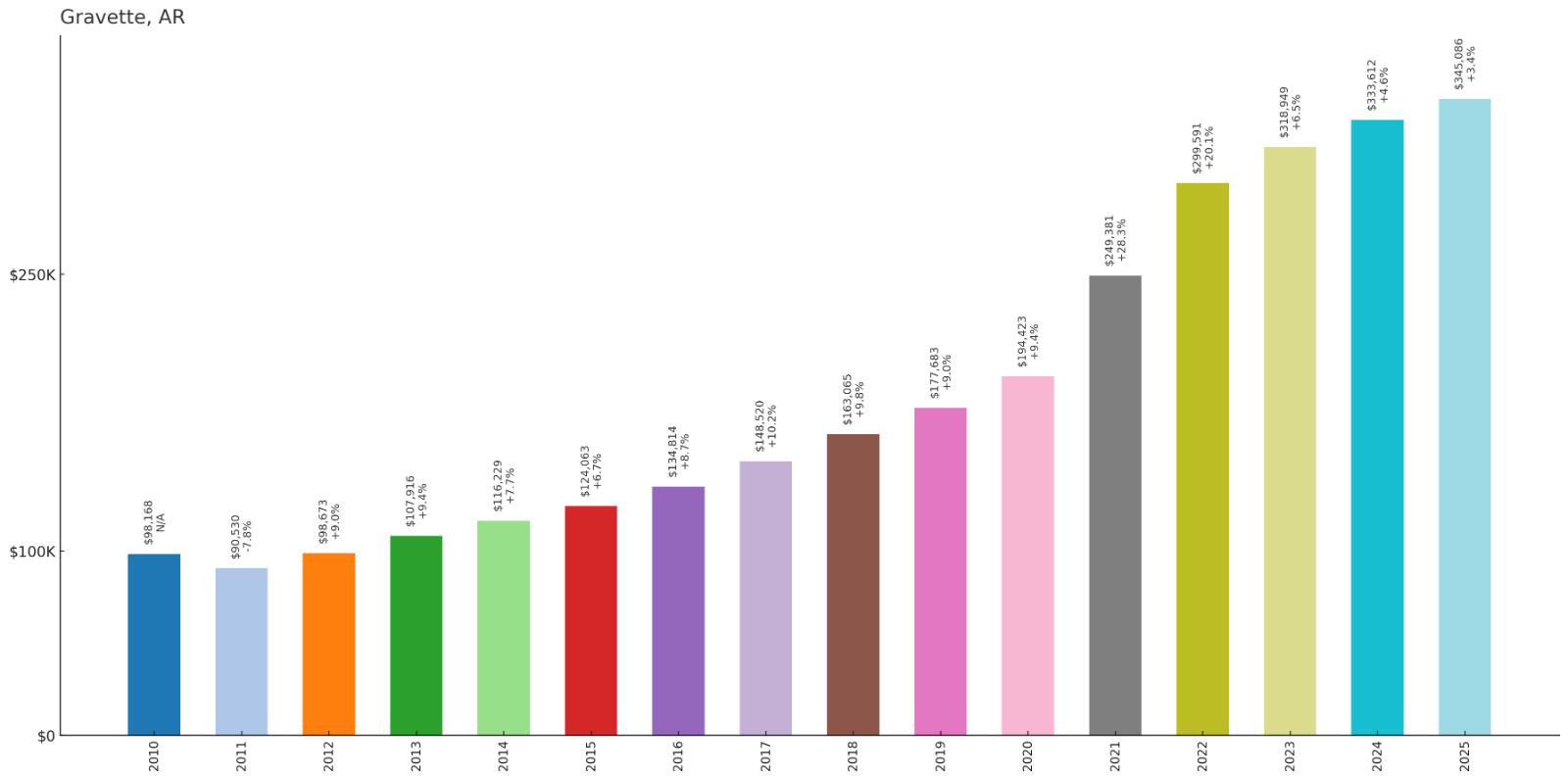
- 2010: $98,168
- 2011: $90,530
- 2012: $98,673
- 2013: $107,916
- 2014: $116,229
- 2015: $124,063
- 2016: $134,814
- 2017: $148,520
- 2018: $163,065
- 2019: $177,683
- 2020: $194,423
- 2021: $249,381
- 2022: $299,591
- 2023: $318,949
- 2024: $333,612
- 2025: $345,086
Gravette experienced the most dramatic transformation of any town on this list. Home values more than tripled from just $98,168 in 2010 to $345,086 in 2025—a remarkable 252% increase. The community showed steady growth throughout the 2010s before exploding after 2020, with particularly strong gains in 2021-2022.
Why Gravette?
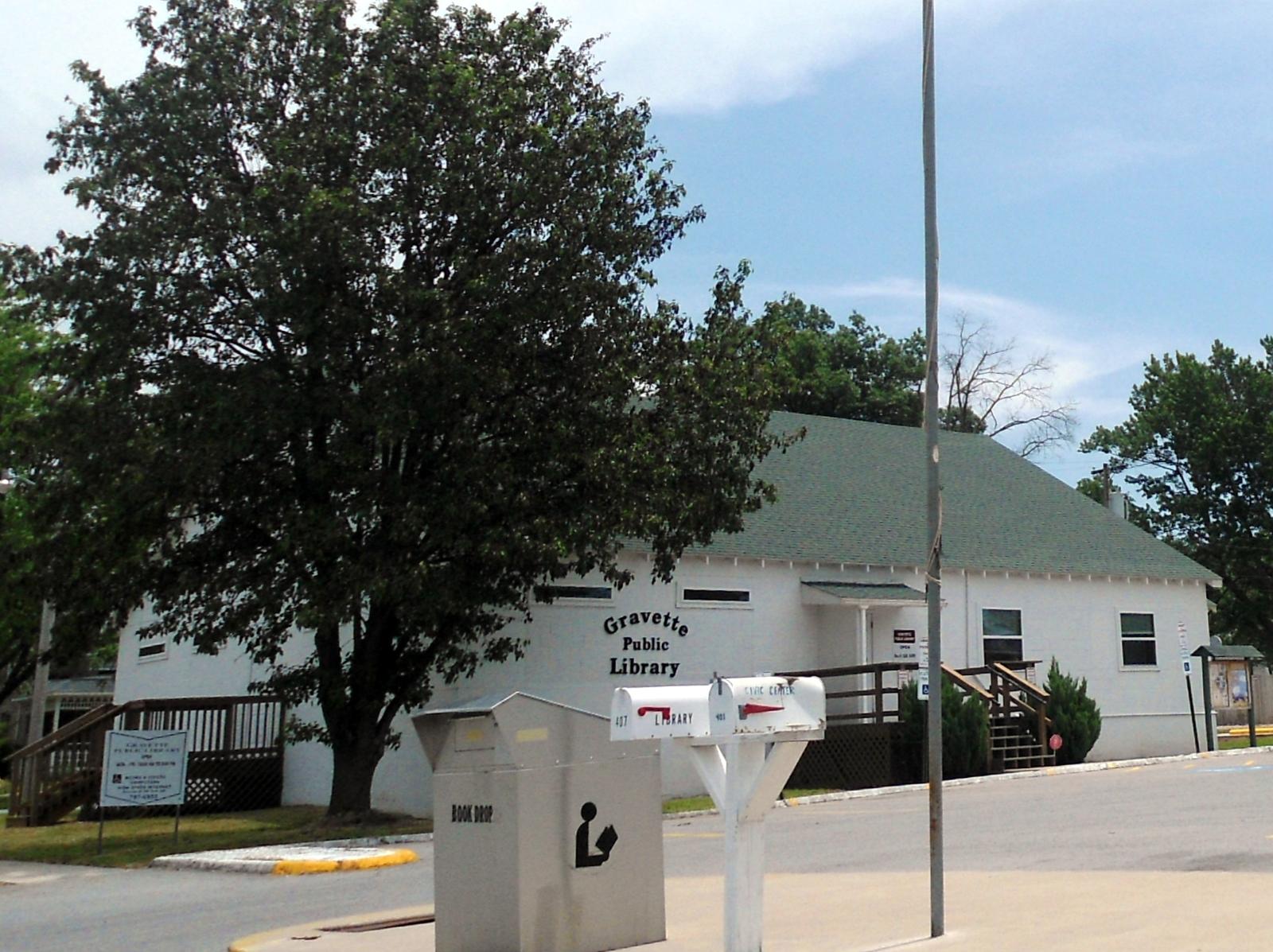
Why Are People Willing to Pay So Much to Live Here? What’s Special About It?
Gravette attracts buyers seeking affordable entry into the booming Northwest Arkansas market while maintaining small-town character. The community offers new construction, family-friendly amenities, and proximity to major employers without the higher costs of Bentonville or Rogers. Families appreciate the excellent schools and growing infrastructure.
The town’s location near the Missouri border provides strategic access to both Arkansas and Missouri employment opportunities while offering space for new residential development. This combination of affordability and growth potential has made Gravette extremely attractive to first-time buyers and growing families.
How Gravette Rose to Prominence
Gravette was established in the 1890s as a railroad town, serving as a shipping point for local timber and agricultural products. The community remained small and primarily agricultural through most of the 20th century, with poultry farming becoming an important part of the local economy.
As the Northwest Arkansas region transformed into a major economic hub centered around Walmart and other large employers, Gravette’s proximity to these growth centers while maintaining lower land costs made it increasingly attractive for residential development. The town has experienced rapid growth as families and professionals sought more affordable options within commuting distance of major job centers.
3 Interesting Tidbits
- Border Town – Gravette sits just minutes from the Missouri state line, providing residents access to employment and amenities in both states.
- Railroad Heritage – The town’s origins as a railroad shipping point are preserved in its historic downtown area and community character.
- Growth Champion – Gravette has been one of Arkansas’s fastest-growing communities, with new subdivisions and infrastructure expanding rapidly.
12. Centerton – 159% Home Price Increase Since 2010
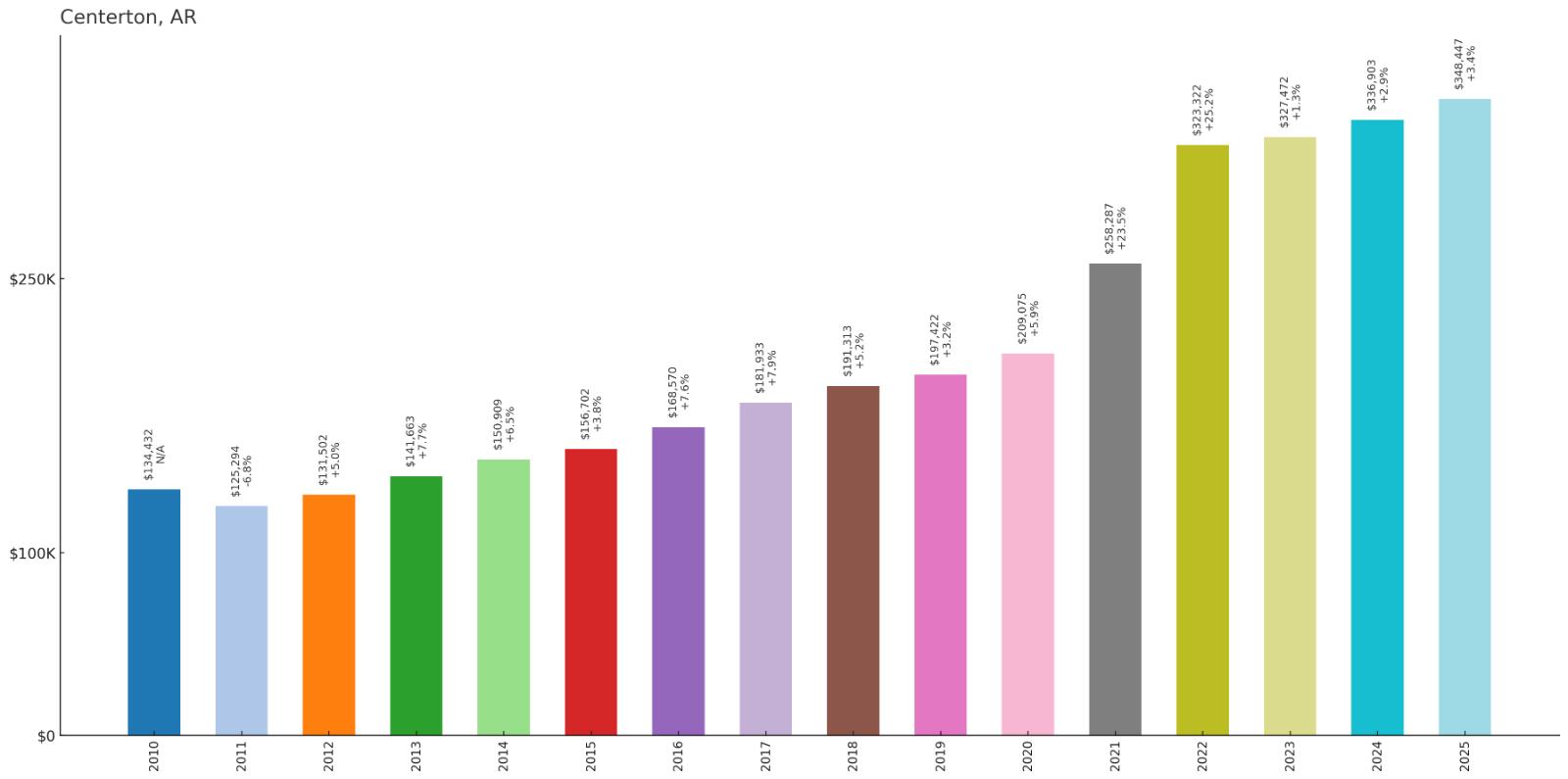
- 2010: $134,432
- 2011: $125,294
- 2012: $131,502
- 2013: $141,663
- 2014: $150,909
- 2015: $156,702
- 2016: $168,570
- 2017: $181,933
- 2018: $191,313
- 2019: $197,422
- 2020: $209,075
- 2021: $258,287
- 2022: $323,322
- 2023: $327,472
- 2024: $336,903
- 2025: $348,447
Centerton showed consistent growth throughout the 2010s before accelerating dramatically after 2020. Home values more than doubled from $134,432 in 2010 to $348,447 in 2025. The most explosive period was 2021-2022, when prices jumped by more than $110,000 in two years.
Why Centerton?
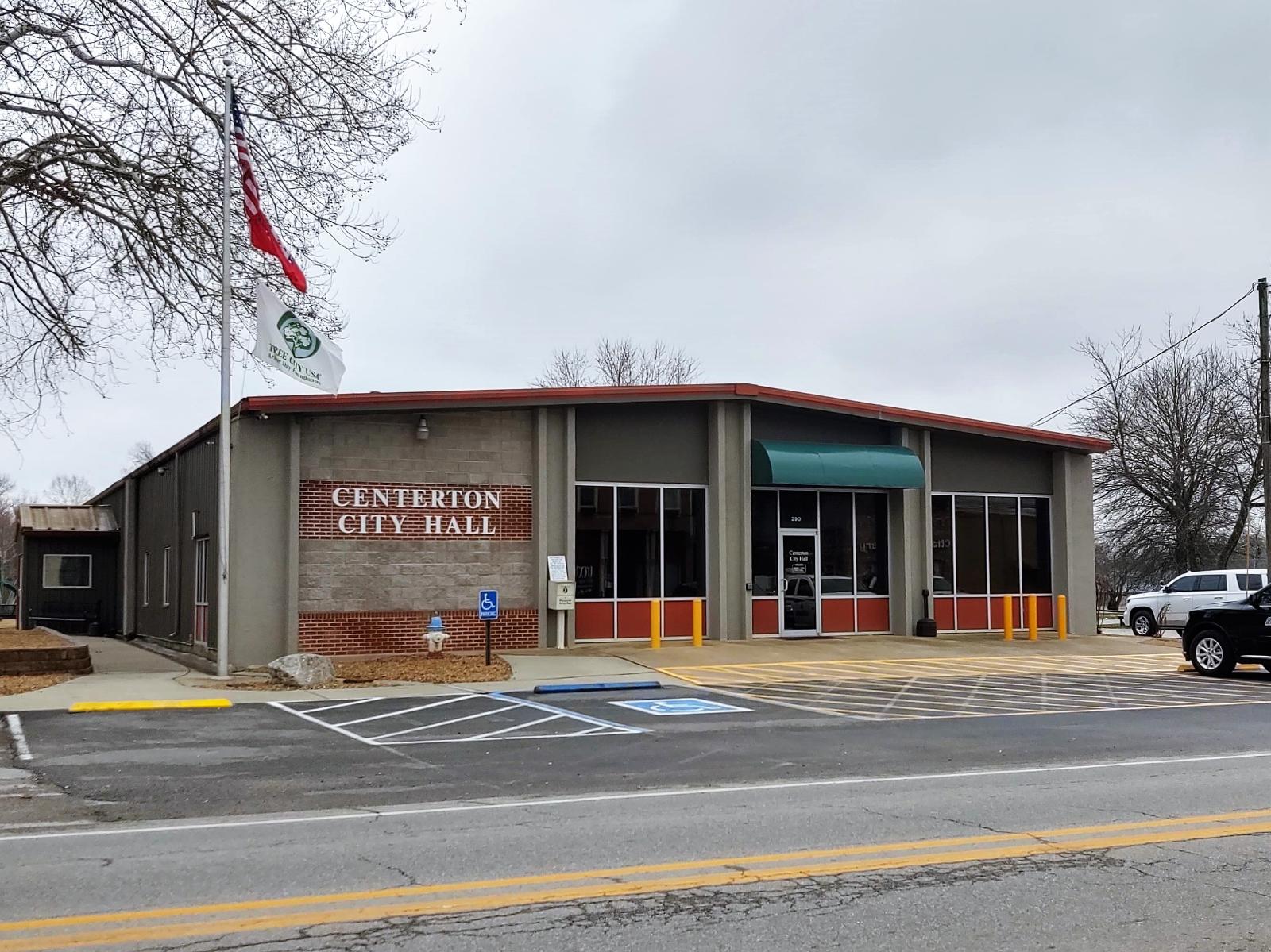
Why Are People Willing to Pay So Much to Live Here? What’s Special About It?
Centerton attracts buyers with its rapid growth and modern amenities combined with proximity to major Northwest Arkansas employers. The community offers new schools, shopping centers, and residential developments that appeal to families seeking contemporary suburban living. Residents value the town’s planned growth and expanding infrastructure.
The town’s location west of Bentonville provides convenient access to Walmart’s headquarters and other major employers while offering newer construction and modern amenities. This combination of convenience and contemporary development has made Centerton one of the region’s fastest-growing communities.
How Centerton Rose to Prominence
Centerton was incorporated in 1988, making it one of Arkansas’s newer municipalities. The town developed rapidly from agricultural land as Northwest Arkansas’s economy boomed, with careful planning for residential and commercial development. From its incorporation, Centerton was designed to accommodate the region’s growth with modern infrastructure and amenities.
The community’s strategic location and commitment to planned development attracted major retailers, schools, and residential builders. As Walmart and other major employers expanded their presence in Northwest Arkansas, Centerton became a prime destination for employees seeking modern suburban living with convenient commutes.
3 Interesting Tidbits
- Newest City – Centerton was incorporated in 1988, making it one of Arkansas’s newest cities with modern planning from its start.
- Retail Hub – The community has become a major retail destination with shopping centers and restaurants serving the broader region.
- Planned Growth – Centerton has experienced some of the most rapid but well-planned growth in Arkansas, with coordinated development of housing, schools, and commercial areas.
11. Lowell – 163% Home Price Increase Since 2010
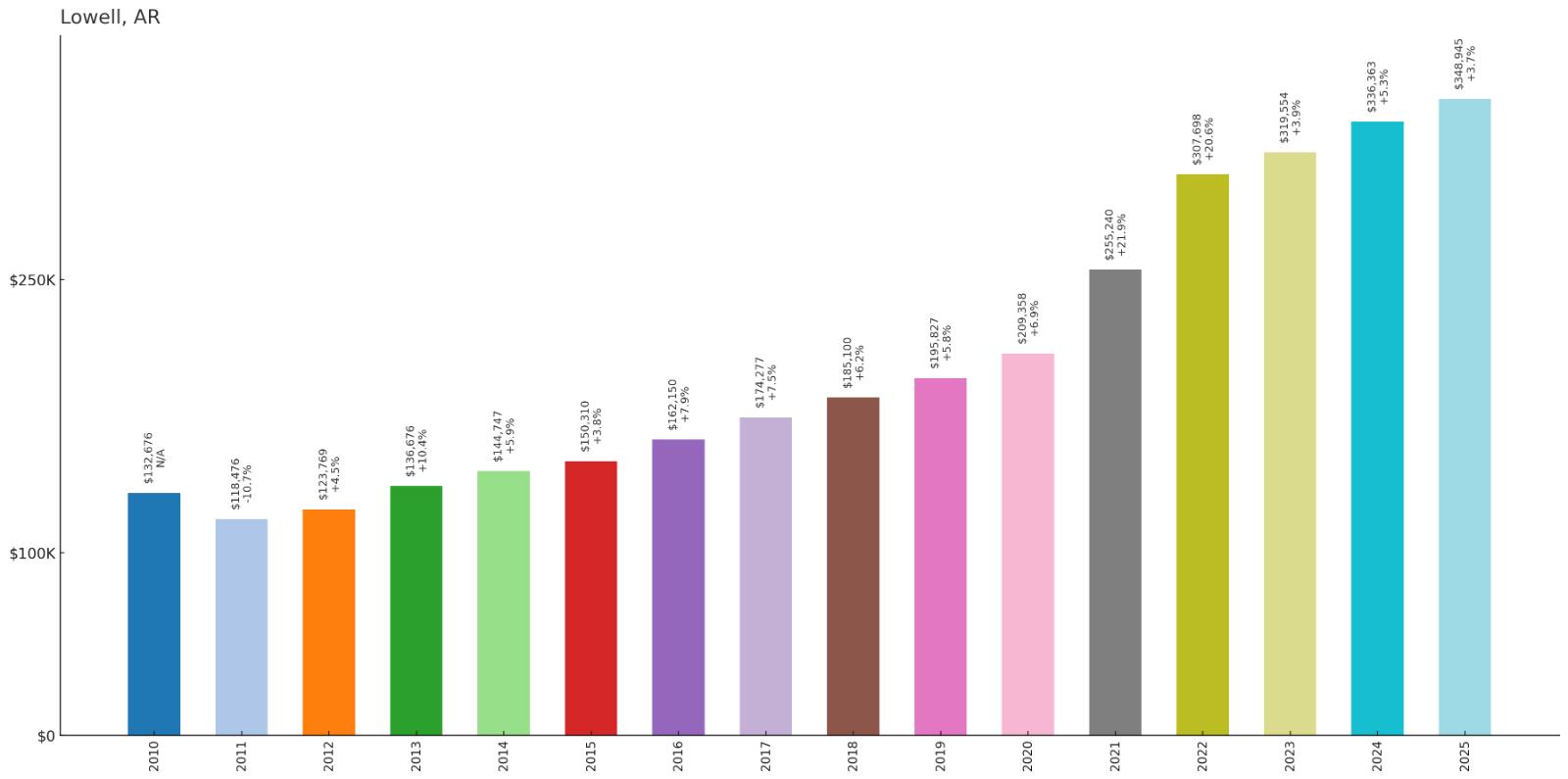
- 2010: $132,676
- 2011: $118,476
- 2012: $123,769
- 2013: $136,676
- 2014: $144,747
- 2015: $150,310
- 2016: $162,150
- 2017: $174,277
- 2018: $185,100
- 2019: $195,827
- 2020: $209,358
- 2021: $255,240
- 2022: $307,698
- 2023: $319,554
- 2024: $336,363
- 2025: $348,945
Lowell demonstrated exceptional growth, with home values more than doubling from $132,676 in 2010 to $348,945 in 2025. After recovering from early-decade declines, the community showed steady appreciation through the 2010s before surging after 2020. The strongest period was 2021-2022, when prices jumped by more than $95,000.
Why Lowell?

Why Are People Willing to Pay So Much to Live Here? What’s Special About It?
Lowell attracts buyers with its strategic location between Fayetteville and Rogers, providing optimal access to Northwest Arkansas’s major employment centers. The community offers established neighborhoods and modern amenities while serving as a transportation and logistics hub. Residents value the convenient location and growing commercial development.
The town’s position along major highways makes it one of the most accessible locations in Northwest Arkansas for commuting to multiple job markets. This strategic advantage, combined with ongoing development and infrastructure improvements, has made Lowell increasingly attractive to professionals and families.
How Lowell Rose to Prominence
Lowell developed as a small agricultural community in Benton County, strategically located along transportation routes connecting the region’s growing cities. The town remained modest in size through most of the 20th century, serving primarily as a rural residential area.
The community’s transformation began as Northwest Arkansas grew into a major economic region and transportation infrastructure improved. Lowell’s central location made it attractive for logistics and transportation companies, while its position between major employment centers drew residential development. The arrival of major employers like J.B. Hunt further enhanced the community’s economic importance and residential appeal.
3 Interesting Tidbits
- Transportation Hub – Lowell is home to J.B. Hunt Transport Services headquarters, one of the largest trucking companies in the United States.
- Strategic Location – The town sits almost exactly between Fayetteville and Rogers, making it ideal for commuters to either city.
- Logistics Center – Lowell has become a major logistics and distribution hub for Northwest Arkansas, attracting warehouses and transportation companies.
10. Bella Vista – 144% Home Price Increase Since 2010
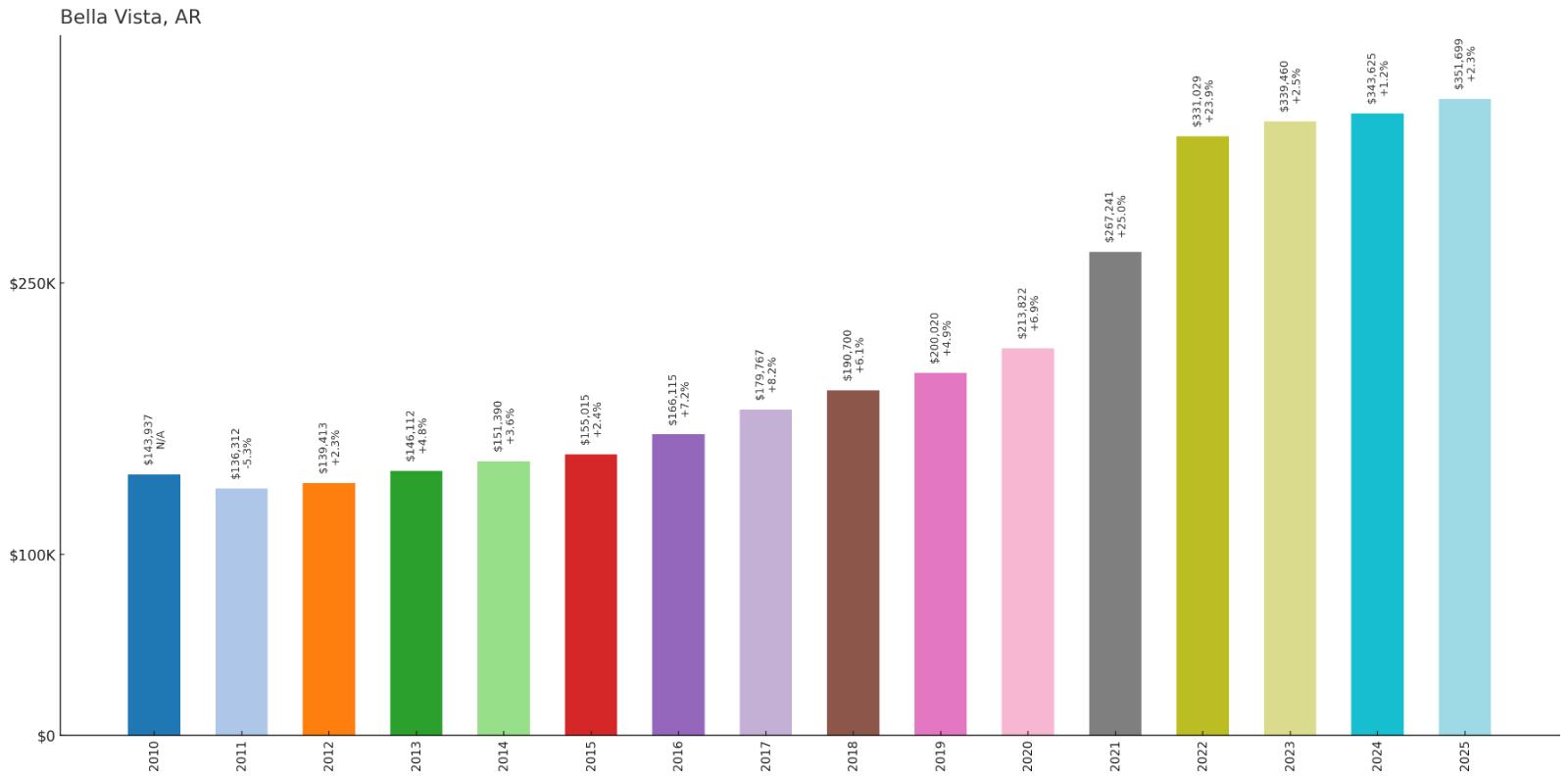
- 2010: $143,937
- 2011: $136,312
- 2012: $139,413
- 2013: $146,112
- 2014: $151,390
- 2015: $155,015
- 2016: $166,115
- 2017: $179,767
- 2018: $190,700
- 2019: $200,020
- 2020: $213,822
- 2021: $267,241
- 2022: $331,029
- 2023: $339,460
- 2024: $343,625
- 2025: $351,699
Bella Vista experienced strong consistent growth, with home values more than doubling from $143,937 in 2010 to $351,699 in 2025. The community showed steady appreciation throughout the 2010s before accelerating significantly after 2020. The strongest period was 2021-2022, when prices surged by more than $115,000.
Why Bella Vista?

Why Are People Willing to Pay So Much to Live Here? What’s Special About It?
Bella Vista attracts buyers with its resort-style amenities and active lifestyle community atmosphere. The planned community offers golf courses, lakes, recreational facilities, and extensive trail systems that appeal to retirees and active families. Residents value the comprehensive amenities and well-maintained environment that comes with community association management.
The community’s location near the Arkansas-Missouri border provides access to employment opportunities in both states while maintaining a resort-like setting. This combination of recreational amenities and strategic location has made Bella Vista particularly appealing to affluent buyers seeking an active lifestyle.
How Bella Vista Rose to Prominence
Bella Vista was developed in the 1960s as a master-planned resort and retirement community, designed to take advantage of the scenic Ozark Mountain setting near the Arkansas-Missouri border. The development included golf courses, lakes, and extensive recreational facilities from its inception, establishing it as a destination for active adults and retirees.
The community’s comprehensive amenities and professional management helped it establish a reputation as one of Arkansas’s premier planned communities. Over the decades, Bella Vista has continued to expand and enhance its facilities while attracting residents from across the region and nation seeking an active, resort-style lifestyle.
3 Interesting Tidbits
- Golf Paradise – Bella Vista features multiple championship golf courses designed by renowned architects, making it a premier golf destination in the region.
- Lake Living – The community includes several private lakes offering boating, fishing, and waterfront living opportunities for residents.
- Trail System – Bella Vista maintains over 100 miles of walking and biking trails connecting neighborhoods, amenities, and natural areas.
9. Hindsville – 130% Home Price Increase Since 2010
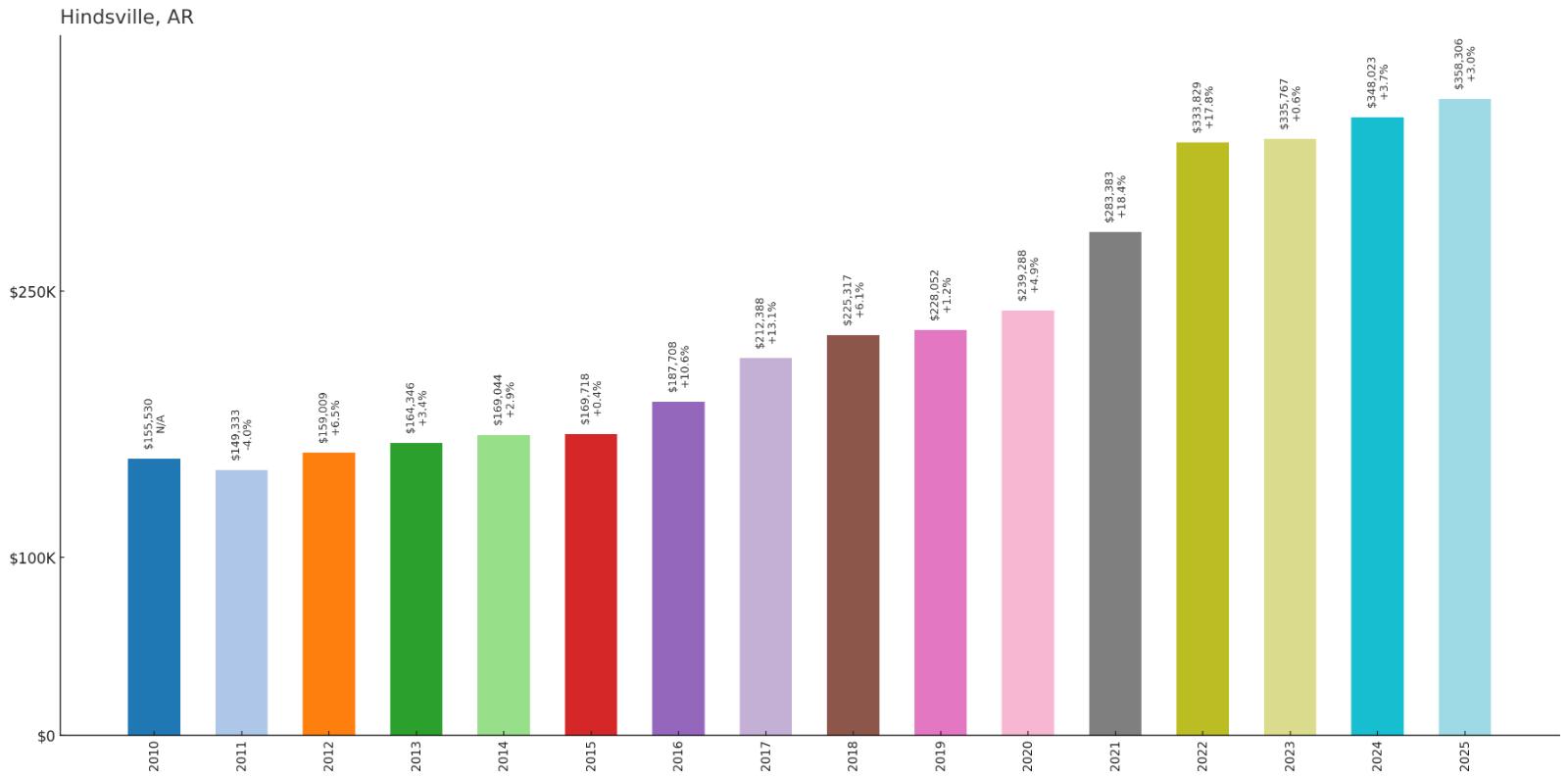
- 2010: $155,530
- 2011: $149,333
- 2012: $159,009
- 2013: $164,346
- 2014: $169,044
- 2015: $169,718
- 2016: $187,708
- 2017: $212,388
- 2018: $225,317
- 2019: $228,052
- 2020: $239,288
- 2021: $283,383
- 2022: $333,829
- 2023: $335,767
- 2024: $348,023
- 2025: $358,306
Hindsville showed steady appreciation throughout the entire period, with home values more than doubling from $155,530 in 2010 to $358,306 in 2025. The community experienced consistent growth through the 2010s before accelerating after 2020. The strongest increases came in 2021-2022, when prices jumped by more than $90,000.
Why Hindsville?
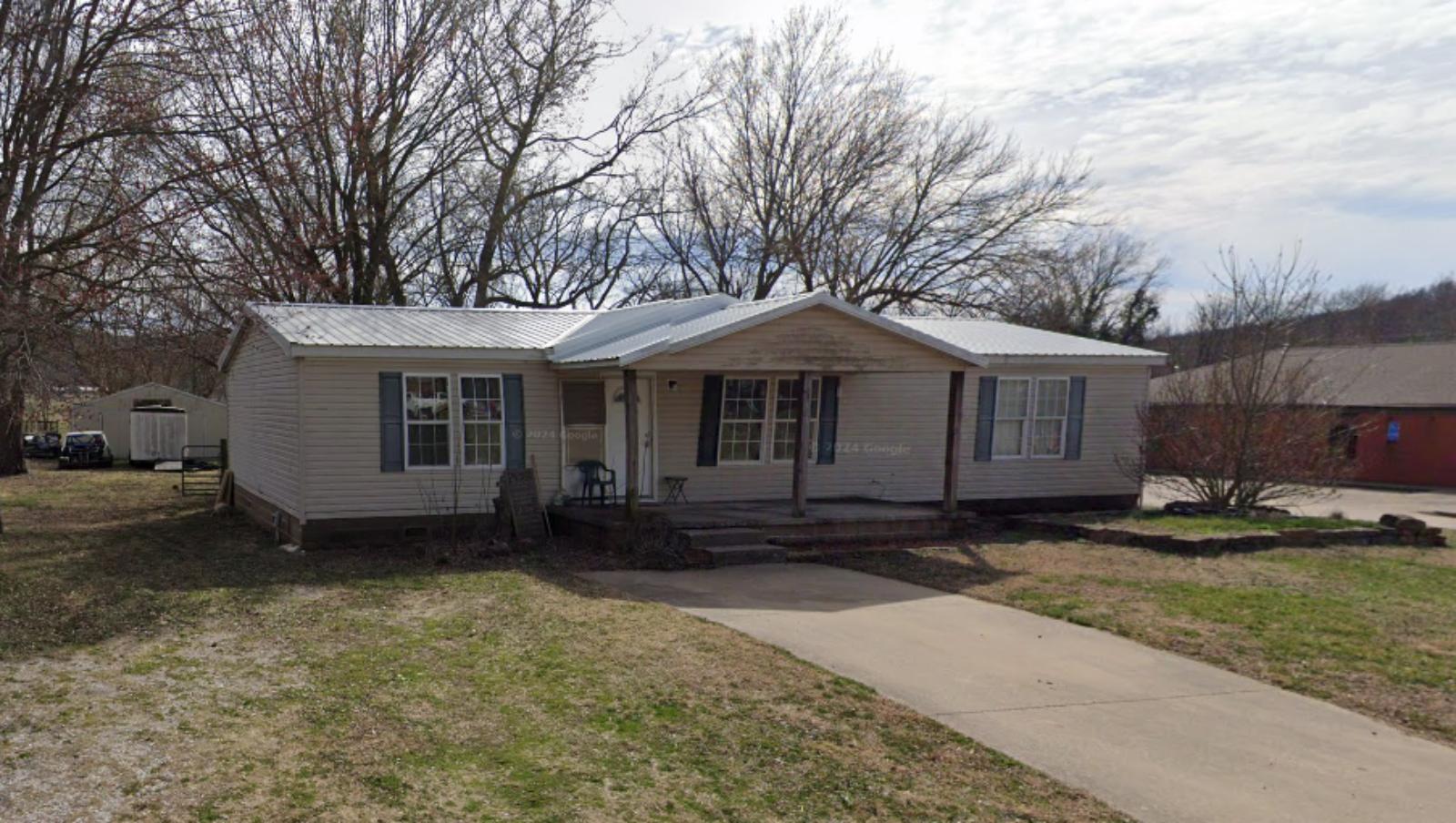
Why Are People Willing to Pay So Much to Live Here? What’s Special About It?
Hindsville attracts buyers seeking rural living with proximity to Northwest Arkansas’s economic opportunities. The small community offers country lifestyle with larger lots and custom home sites while maintaining reasonable access to regional employment centers. Residents value the privacy and space that comes with rural living.
The area’s natural setting and agricultural character provide an appealing environment for those seeking to escape urban density while staying connected to the broader region’s amenities. This combination of rural charm and regional access has made Hindsville increasingly attractive to buyers seeking country living.
How Hindsville Rose to Prominence
Hindsville developed as a small agricultural community in Madison County, remaining primarily rural through most of its history. The area’s economy was built around farming and livestock, with scattered homesteads and small family farms characterizing the landscape.
As Northwest Arkansas’s economy expanded and remote work became more feasible, Hindsville’s rural character and natural beauty began attracting residents seeking country living within reach of regional employment opportunities. The community has maintained its agricultural character while accommodating new residential development.
3 Interesting Tidbits
- Agricultural Heritage – Hindsville maintains its connection to farming and livestock, with many residents involved in agricultural activities.
- Rural Character – The community has preserved its small-town, rural atmosphere despite growing interest from urban buyers.
- Natural Setting – Hindsville’s location in Madison County provides access to scenic landscapes and outdoor recreation opportunities.
8. Fayetteville – 121% Home Price Increase Since 2010
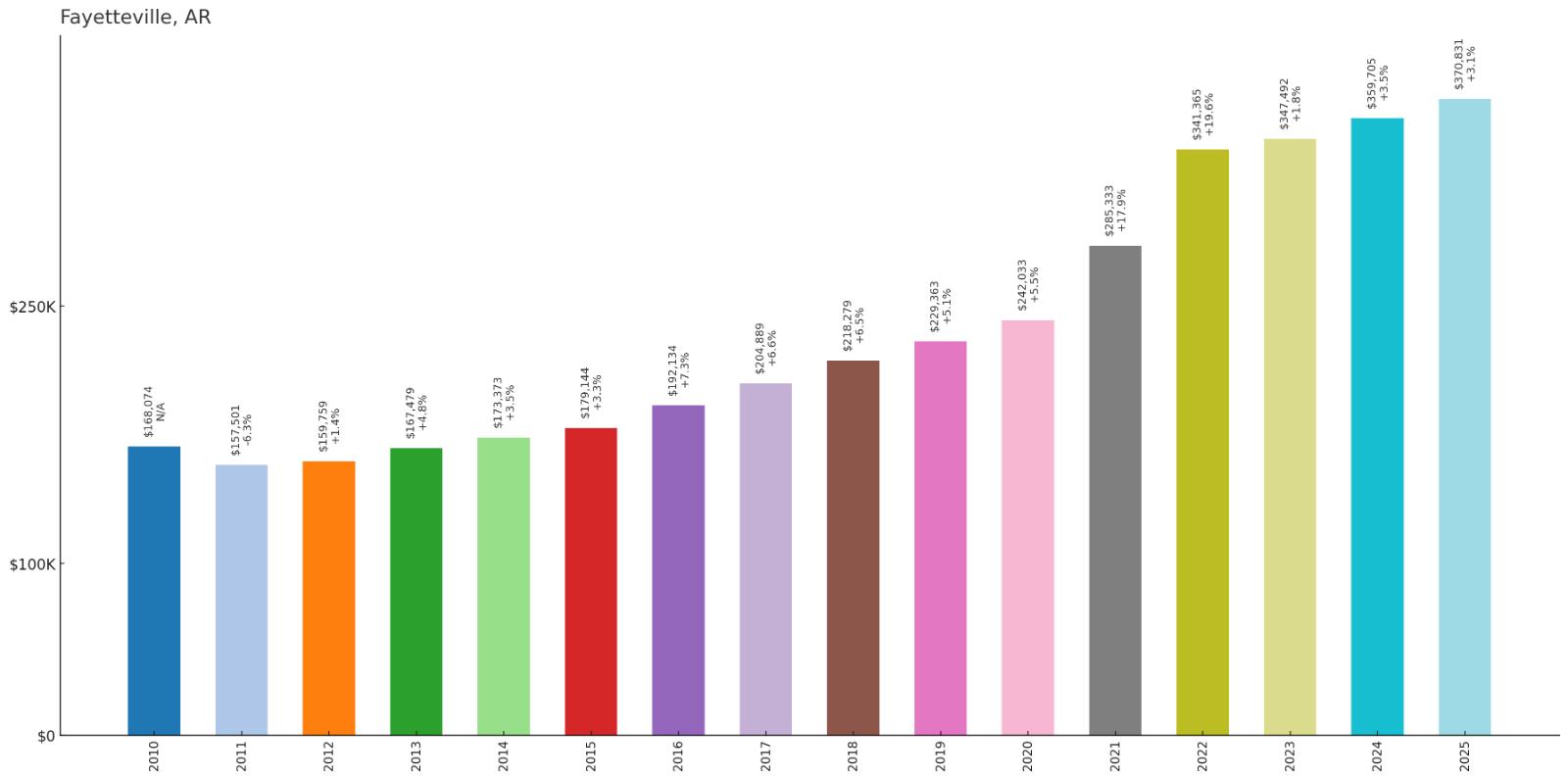
- 2010: $168,074
- 2011: $157,501
- 2012: $159,759
- 2013: $167,479
- 2014: $173,373
- 2015: $179,144
- 2016: $192,134
- 2017: $204,889
- 2018: $218,279
- 2019: $229,363
- 2020: $242,033
- 2021: $285,333
- 2022: $341,365
- 2023: $347,492
- 2024: $359,705
- 2025: $370,831
Fayetteville demonstrated strong consistent growth, with home values more than doubling from $168,074 in 2010 to $370,831 in 2025. The city showed steady appreciation throughout the 2010s before accelerating significantly after 2020. The strongest period was 2021-2022, when prices surged by more than $95,000.
Why Fayetteville?

Why Are People Willing to Pay So Much to Live Here? What’s Special About It?
Fayetteville attracts buyers with its combination of university town culture and major employment opportunities. The city offers diverse neighborhoods, cultural amenities, and educational institutions while serving as home to the University of Arkansas. Residents value the vibrant downtown, arts scene, and intellectual atmosphere that comes with a major university presence.
The city’s role as an educational and cultural center provides unique amenities and opportunities not found in smaller communities. This combination of university resources, cultural attractions, and economic diversity has made Fayetteville consistently attractive to professionals, academics, and families.
How Fayetteville Rose to Prominence
Fayetteville was established in 1828 and became the home of the University of Arkansas in 1871, which shaped the city’s character and economy. The university’s presence attracted educational institutions, cultural amenities, and a diverse population that helped establish Fayetteville as a regional center for education and culture.
As Northwest Arkansas developed into a major economic region, Fayetteville’s role as the university town and cultural center made it increasingly important. The city has balanced its educational mission with economic development, creating a unique environment that attracts both students and professionals to the area.
3 Interesting Tidbits
- University Town – Fayetteville is home to the University of Arkansas, which brings over 27,000 students and extensive cultural and educational resources to the community.
- Razorback Nation – The city serves as the heart of Arkansas Razorback athletics, with Razorback Stadium and Bud Walton Arena hosting major sporting events.
- Cultural Hub – Fayetteville features a vibrant downtown arts district, live music scene, and numerous festivals that attract visitors from across the region.
7. Rogers – 161% Home Price Increase Since 2010
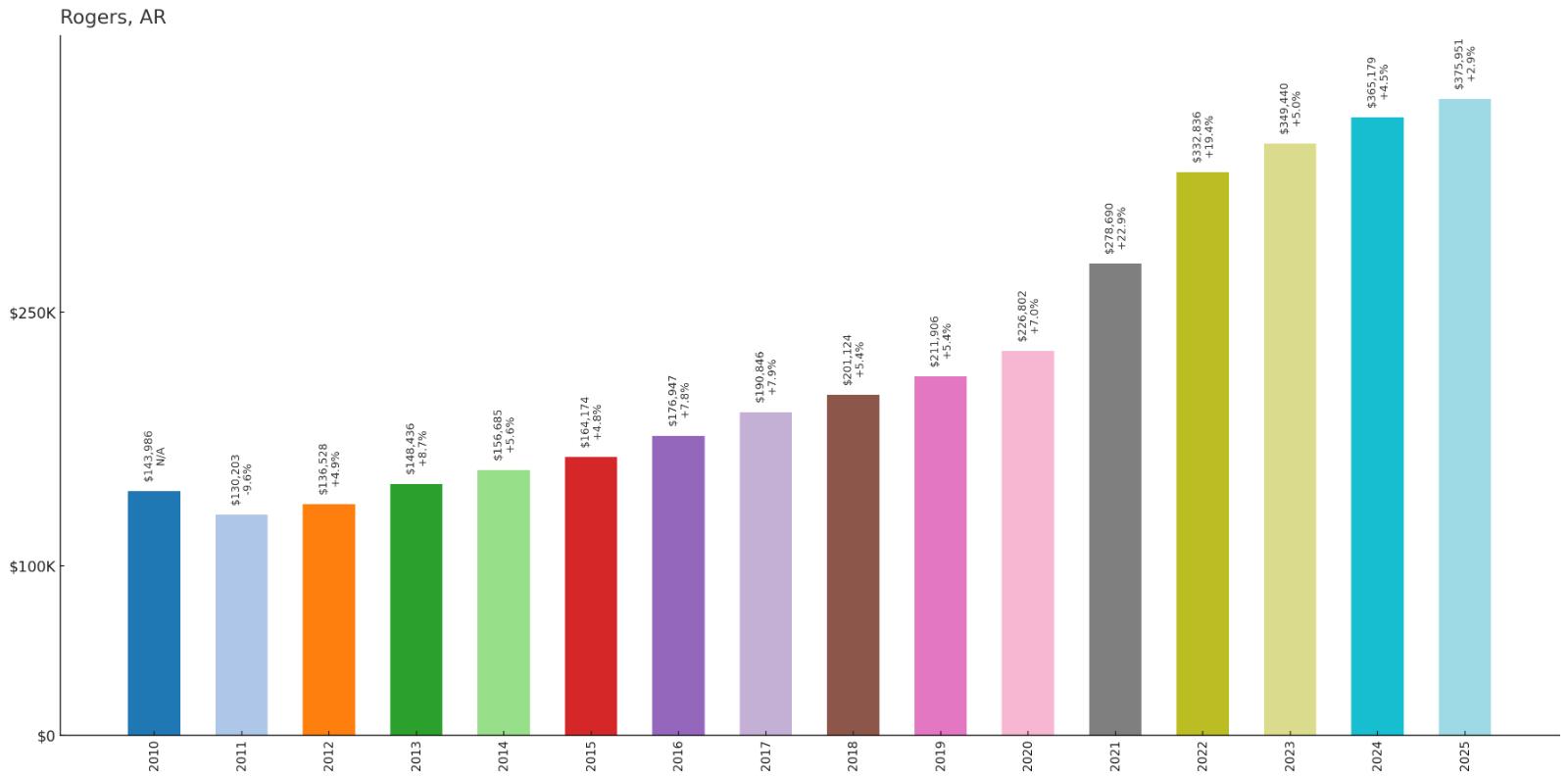
- 2010: $143,986
- 2011: $130,203
- 2012: $136,528
- 2013: $148,436
- 2014: $156,685
- 2015: $164,174
- 2016: $176,947
- 2017: $190,846
- 2018: $201,124
- 2019: $211,906
- 2020: $226,802
- 2021: $278,690
- 2022: $332,836
- 2023: $349,440
- 2024: $365,179
- 2025: $375,951
Rogers experienced remarkable growth, with home values more than doubling from $143,986 in 2010 to $375,951 in 2025. After recovering from early-decade declines, the city showed consistent appreciation through the 2010s before surging after 2020. The strongest period was 2021-2022, when prices jumped by more than $100,000.
Why Rogers?
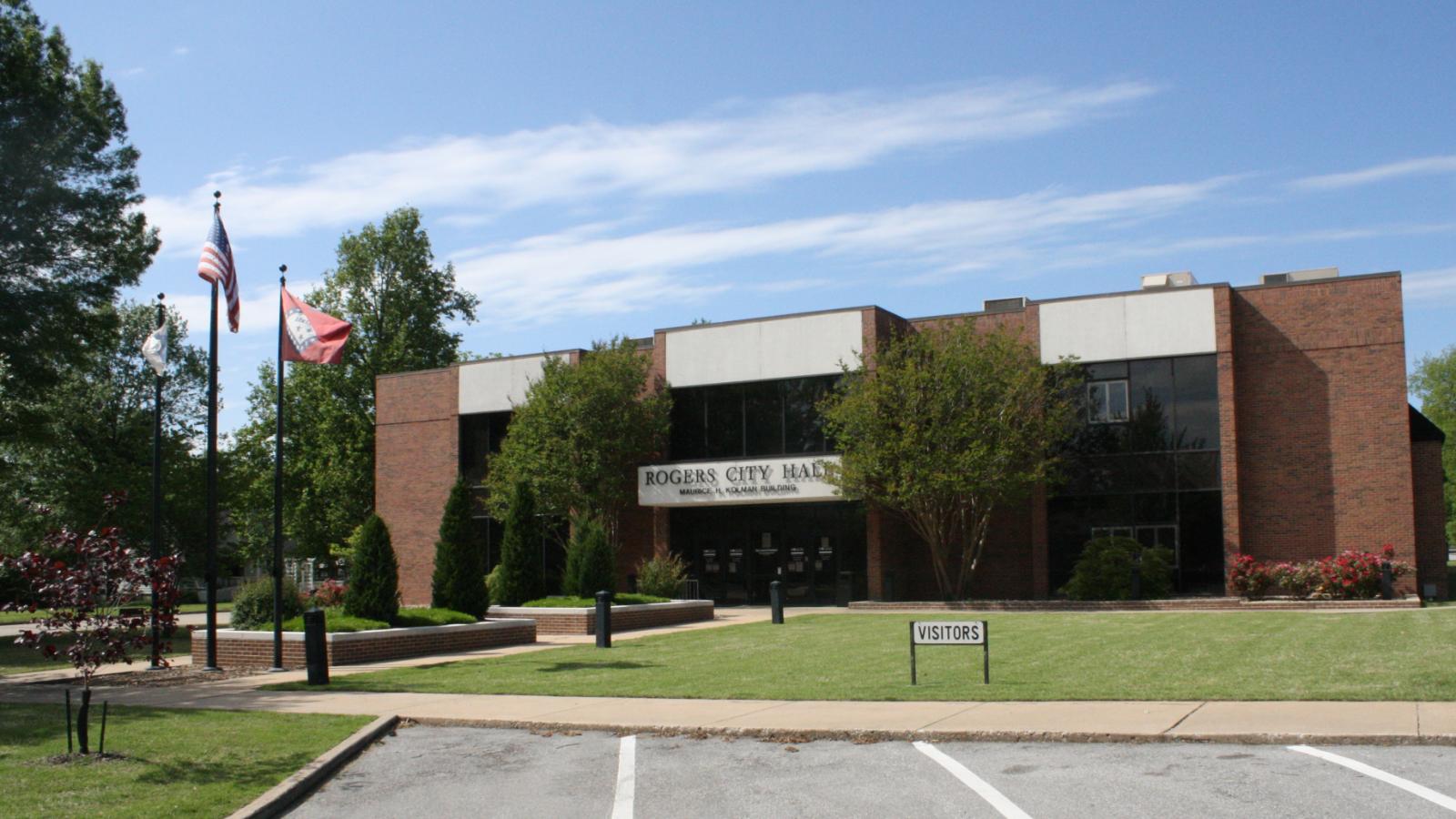
Why Are People Willing to Pay So Much to Live Here? What’s Special About It?
Rogers attracts buyers with its central location in Northwest Arkansas and proximity to major employers including Walmart. The city offers established neighborhoods, excellent schools, and comprehensive city services while maintaining convenient access to regional attractions and employment centers. Families value the community’s stability and quality amenities.
The city’s position as a regional hub provides shopping, dining, and entertainment options while serving as a gateway to outdoor recreation opportunities. This combination of urban amenities and regional access has made Rogers consistently attractive to families and professionals.
How Rogers Rose to Prominence
Rogers was established in the 1880s as a railroad town, serving as an important transportation hub for the region’s agricultural products. The city grew steadily as a regional center for commerce and transportation, developing a diverse economy that included agriculture, manufacturing, and retail.
The city’s proximity to Bentonville and its role as a regional center helped it benefit from Northwest Arkansas’s economic transformation. Rogers has maintained its position as an important commercial and residential center while adapting to the region’s growth and changing economy.
3 Interesting Tidbits
- Frisco Station – Rogers is home to the beautifully restored Frisco Station, which serves as a museum and community gathering place celebrating the city’s railroad heritage.
- Pinnacle Hills – The city features major retail developments including Pinnacle Hills Promenade, one of Northwest Arkansas’s premier shopping destinations.
- Sports Complex – Rogers has invested heavily in sports facilities, including a state-of-the-art aquatics center and baseball complex that attract regional tournaments.
6. Garfield – 179% Home Price Increase Since 2010
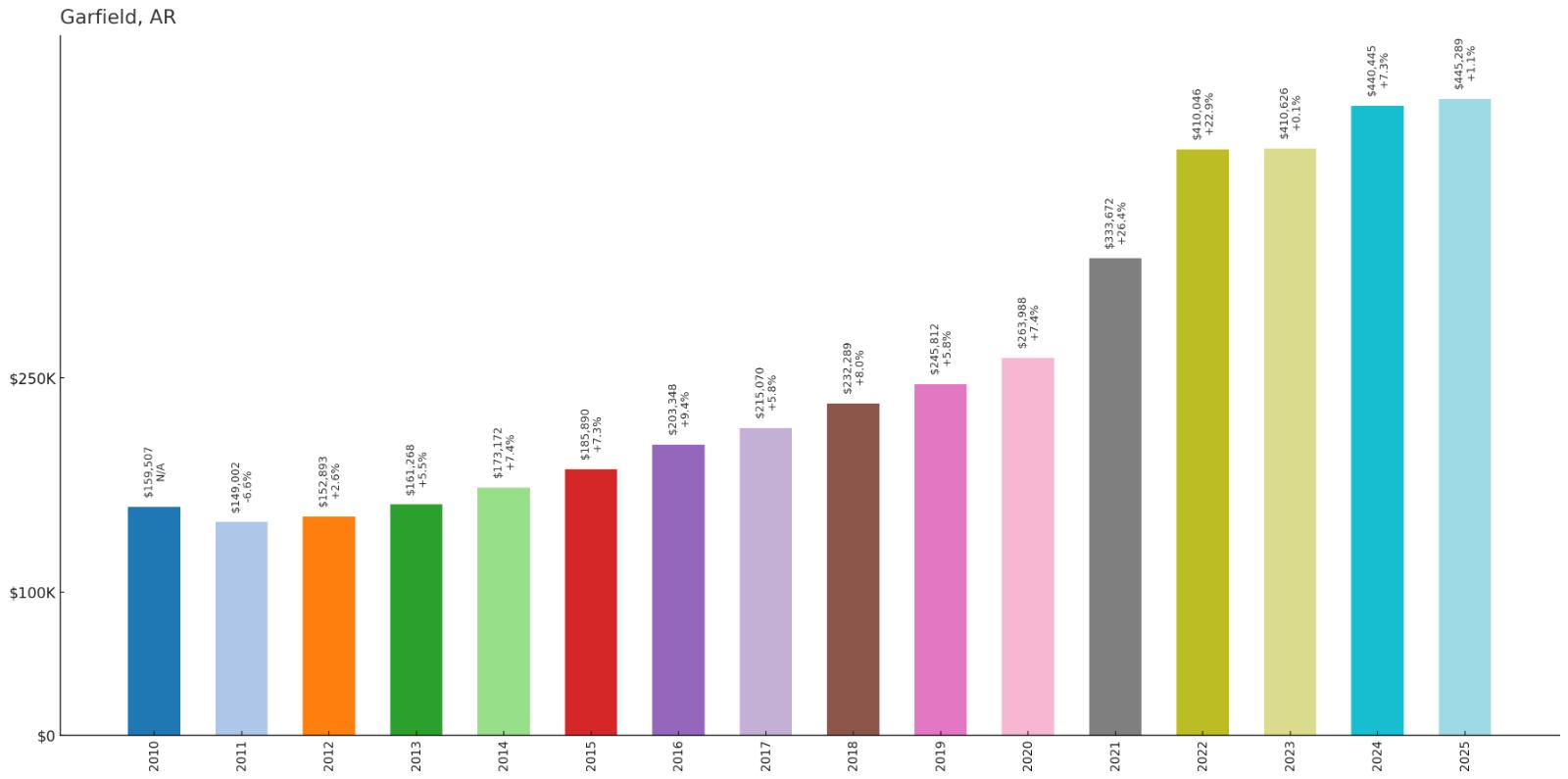
- 2010: $159,507
- 2011: $149,002
- 2012: $152,893
- 2013: $161,268
- 2014: $173,172
- 2015: $185,890
- 2016: $203,348
- 2017: $215,070
- 2018: $232,289
- 2019: $245,812
- 2020: $263,988
- 2021: $333,672
- 2022: $410,046
- 2023: $410,626
- 2024: $440,445
- 2025: $445,289
Garfield demonstrated exceptional growth, with home values nearly tripling from $159,507 in 2010 to $445,289 in 2025. The community showed steady appreciation throughout the 2010s before exploding after 2020. The most dramatic period was 2021-2022, when prices surged by more than $145,000 in two years.
Why Garfield?
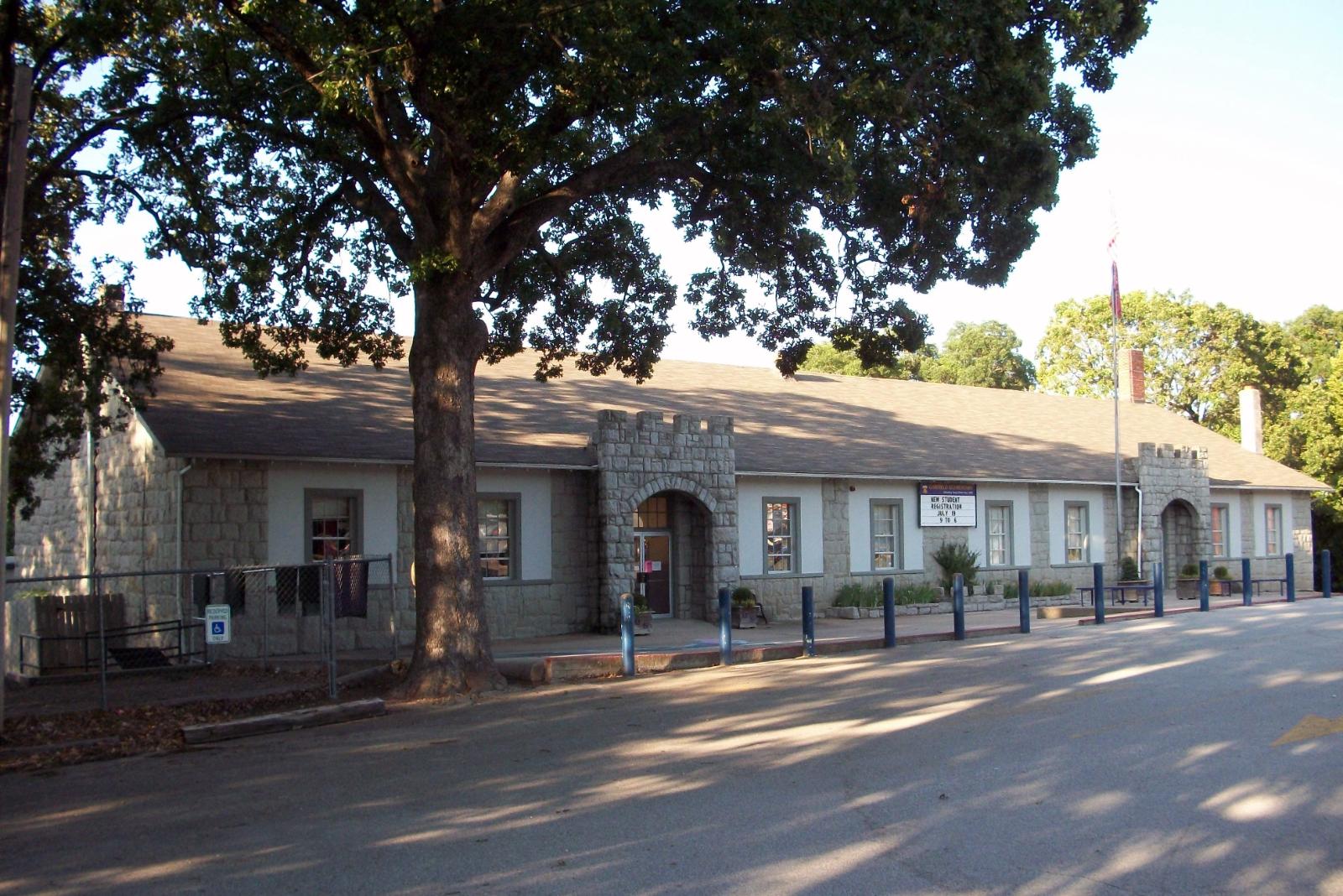
Why Are People Willing to Pay So Much to Live Here? What’s Special About It?
Garfield attracts buyers with its scenic setting and proximity to outdoor recreation opportunities while maintaining access to Northwest Arkansas employment centers. The small community offers rural character with beautiful natural surroundings that appeal to those seeking privacy and space. Residents value the peaceful environment and close-knit community atmosphere.
The area’s natural beauty and rural setting provide an attractive alternative to more developed suburbs while still offering reasonable access to regional amenities and job markets. This combination has made Garfield increasingly appealing to buyers seeking country living with modern conveniences.
How Garfield Rose to Prominence
Garfield developed as a small agricultural community in Benton County, remaining primarily rural through most of its history. The area was characterized by farming operations and scattered homesteads, with the community maintaining a quiet, rural character.
As Northwest Arkansas’s economy boomed and land values rose throughout the region, Garfield’s natural beauty and rural character began attracting buyers seeking alternatives to more developed areas. The community has experienced significant growth while working to preserve its rural identity and natural environment.
3 Interesting Tidbits
- Scenic Beauty – Garfield’s rolling hills and natural landscapes provide some of the most scenic residential settings in Northwest Arkansas.
- Rural Retreat – The community offers a peaceful rural atmosphere while remaining within commuting distance of major employment centers.
- Natural Preserve – Much of the area maintains its natural character with forests and open spaces that attract wildlife and outdoor enthusiasts.
5. Bentonville – 169% Home Price Increase Since 2010
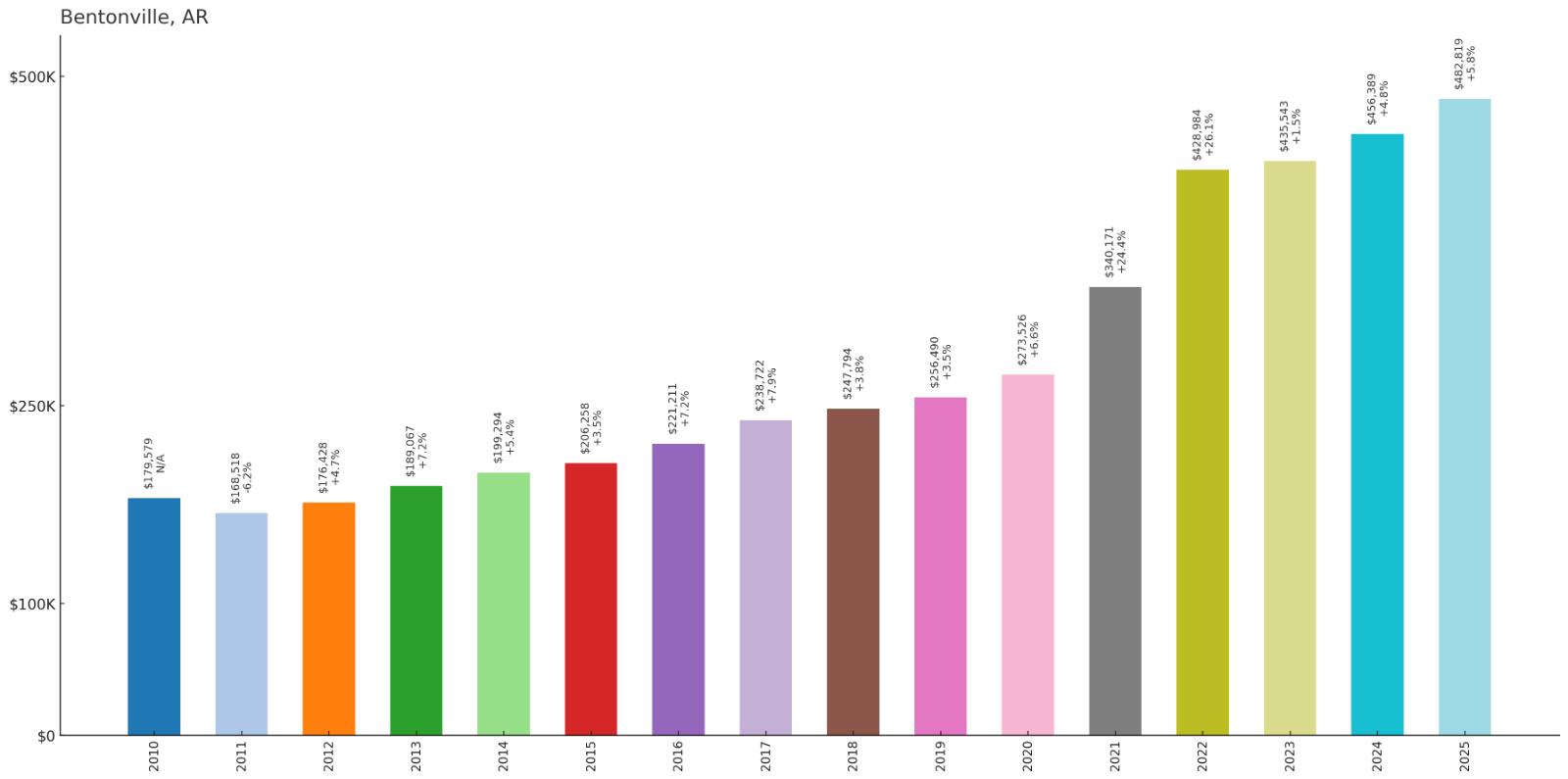
- 2010: $179,579
- 2011: $168,518
- 2012: $176,428
- 2013: $189,067
- 2014: $199,294
- 2015: $206,258
- 2016: $221,211
- 2017: $238,722
- 2018: $247,794
- 2019: $256,490
- 2020: $273,526
- 2021: $340,171
- 2022: $428,984
- 2023: $435,543
- 2024: $456,389
- 2025: $482,819
Bentonville experienced dramatic growth, with home values more than doubling from $179,579 in 2010 to $482,819 in 2025. The city showed steady appreciation through the 2010s before accelerating significantly after 2020. The strongest period was 2021-2022, when prices surged by more than $155,000.
Why Bentonville?
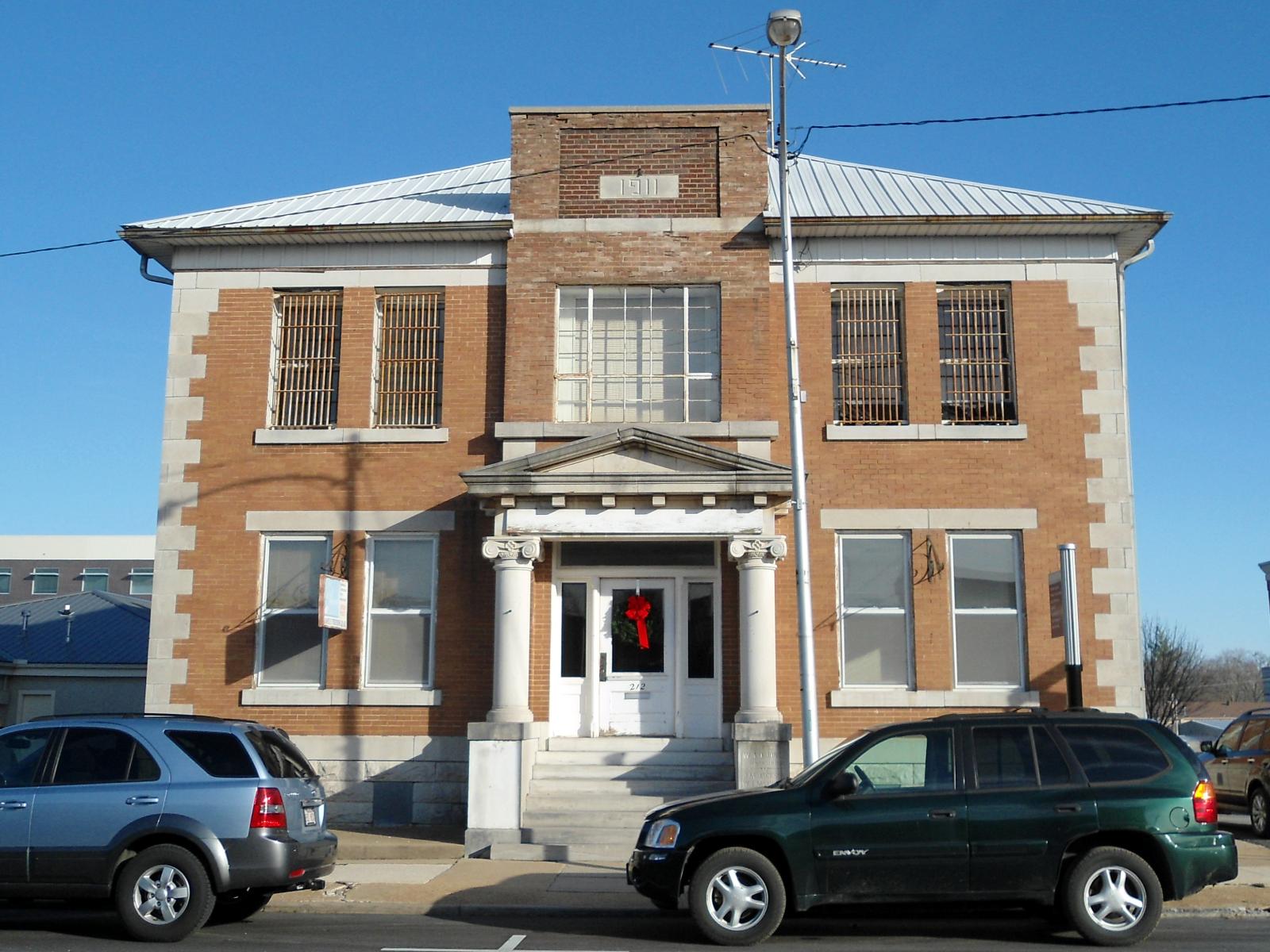
Why Are People Willing to Pay So Much to Live Here? What’s Special About It?
Bentonville attracts buyers as the global headquarters of Walmart and a major corporate center with world-class amenities. The city offers high-end neighborhoods, cultural attractions like Crystal Bridges Museum, and extensive biking trails that appeal to executives and professionals. Residents value the combination of small-town charm with big-city resources and employment opportunities.
The city’s transformation into a cultural destination with major art museums, upscale dining, and recreational amenities has made it attractive to affluent buyers from across the nation and internationally. This unique combination of corporate headquarters and cultural sophistication has driven significant property value appreciation.
How Bentonville Rose to Prominence
Bentonville was established in 1837 and remained a small county seat town for most of its history. The city’s transformation began in 1962 when Sam Walton opened the first Walmart store, eventually growing the company into the world’s largest retailer with its headquarters remaining in Bentonville.
Walmart’s success brought international attention and investment to Bentonville, attracting suppliers, executives, and cultural institutions. The Walton family’s philanthropy, including the creation of Crystal Bridges Museum of American Art, has further elevated the city’s profile and cultural amenities, making it a unique destination that combines corporate power with world-class cultural resources.
3 Interesting Tidbits
- Walmart Headquarters – Bentonville serves as the global headquarters of Walmart, the world’s largest retailer, bringing international business and executive talent to the city.
- Crystal Bridges – The city is home to Crystal Bridges Museum of American Art, founded by Alice Walton, which features a world-class collection of American art.
- Bike Capital – Bentonville has become known as a premier mountain biking destination with extensive trail systems that attract riders from around the world.
4. Little Flock – 172% Home Price Increase Since 2010

- 2010: $182,881
- 2011: $170,187
- 2012: $179,192
- 2013: $194,419
- 2014: $206,673
- 2015: $215,877
- 2016: $230,172
- 2017: $255,414
- 2018: $267,938
- 2019: $281,473
- 2020: $301,891
- 2021: $373,405
- 2022: $444,851
- 2023: $463,626
- 2024: $479,479
- 2025: $497,461
Little Flock experienced exceptional growth, with home values more than doubling from $182,881 in 2010 to $497,461 in 2025. The city showed consistent appreciation throughout the 2010s before accelerating dramatically after 2020. The strongest period was 2021-2022, when prices jumped by more than $140,000.
Why Little Flock?

Why Are People Willing to Pay So Much to Live Here? What’s Special About It?
Little Flock attracts buyers seeking upscale suburban living with proximity to major Northwest Arkansas employment centers. The community offers newer developments, excellent schools, and family-friendly amenities while maintaining convenient access to Bentonville and Rogers. Families value the modern infrastructure and planned community development.
The city’s strategic location and commitment to quality development have made it particularly attractive to executives and professionals working for major regional employers. This combination of location and community planning has driven significant appreciation in property values.
How Little Flock Rose to Prominence
Little Flock was incorporated in 1971 as Northwest Arkansas began its transformation from a rural area to a major economic region. The community was developed with modern planning principles, emphasizing quality residential development and municipal services from its inception.
As the region’s economy grew around major employers like Walmart and Tyson Foods, Little Flock’s proximity to these employment centers and commitment to planned development made it increasingly attractive to professionals and executives. The city has continued to grow while maintaining high standards for development and community amenities.
3 Interesting Tidbits
- Modern Planning – Little Flock was incorporated in 1971 with modern municipal planning, allowing for coordinated development and high community standards.
- Executive Community – The city has attracted many executives and professionals working for major Northwest Arkansas employers.
- Quality Development – Little Flock has maintained strict development standards that have helped preserve property values and community character.
3. Cave Springs – 142% Home Price Increase Since 2010

- 2010: $231,924
- 2011: $217,044
- 2012: $228,526
- 2013: $243,133
- 2014: $261,838
- 2015: $271,367
- 2016: $285,528
- 2017: $301,031
- 2018: $311,646
- 2019: $319,116
- 2020: $334,804
- 2021: $406,223
- 2022: $495,276
- 2023: $509,137
- 2024: $528,778
- 2025: $560,232
Cave Springs demonstrated strong consistent growth, with home values more than doubling from $231,924 in 2010 to $560,232 in 2025. The city showed steady appreciation throughout the 2010s before accelerating significantly after 2020. The strongest period was 2021-2022, when prices surged by more than $160,000.
Why Cave Springs?
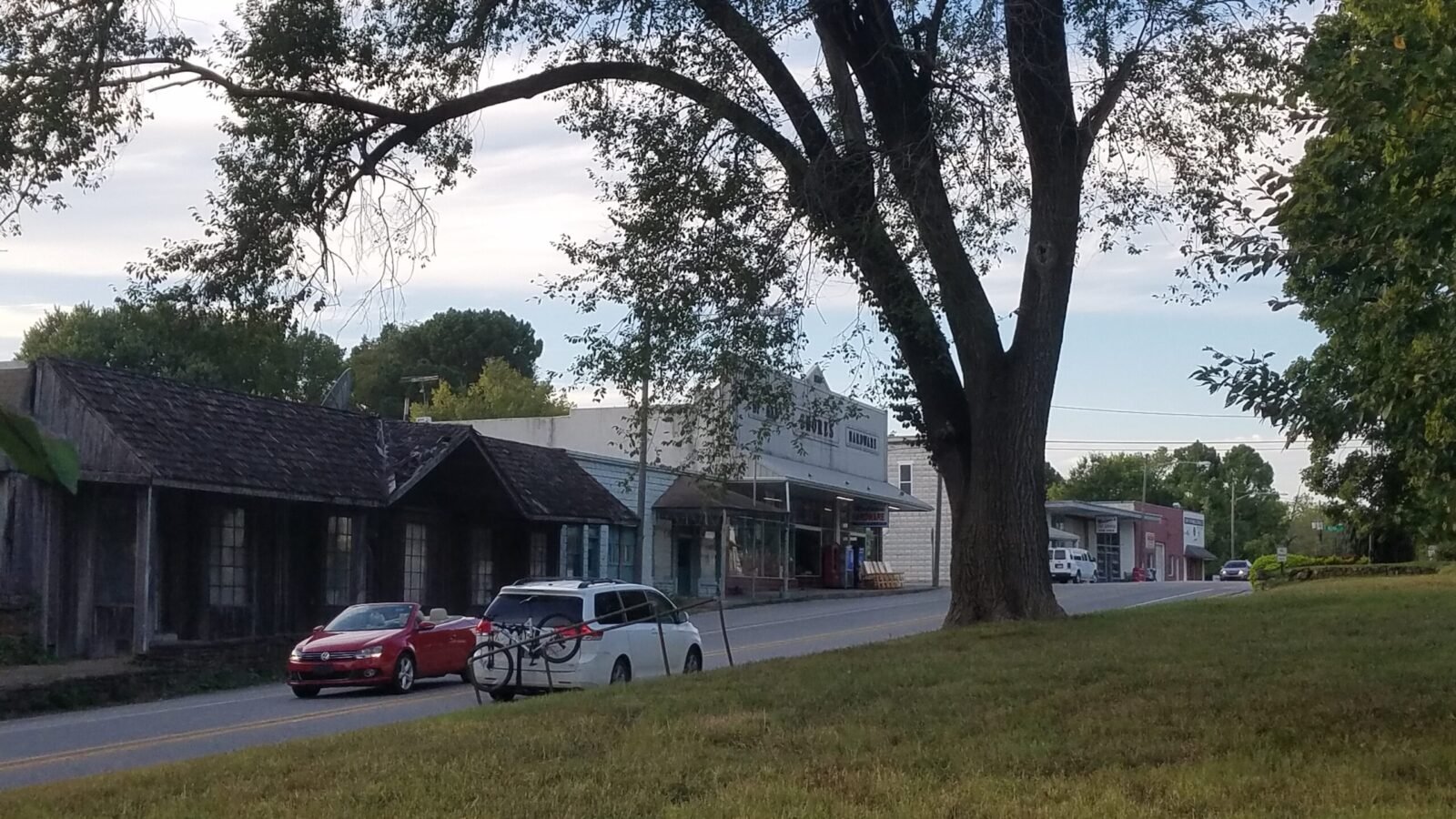
Why Are People Willing to Pay So Much to Live Here? What’s Special About It?
Cave Springs attracts buyers with its upscale neighborhoods and proximity to major Northwest Arkansas employment centers and amenities. The community offers large lots, luxury homes, and excellent schools while maintaining convenient access to Bentonville, Rogers, and regional attractions. Residents value the suburban setting and high-end residential developments.
The city’s reputation for quality development and affluent neighborhoods has made it a preferred destination for executives and successful professionals. This concentration of high-income residents and quality amenities has driven significant appreciation in property values.
How Cave Springs Rose to Prominence
Cave Springs developed around natural springs that gave the community its name, remaining a small rural area through most of the 20th century. The city’s transformation began as Northwest Arkansas’s economy expanded and suburban development spread outward from major employment centers.
The community’s strategic location and commitment to upscale residential development attracted affluent buyers seeking suburban living with easy access to regional employment and amenities. Cave Springs has maintained its position as one of the region’s most exclusive residential communities.
3 Interesting Tidbits
- Natural Springs – The city takes its name from natural springs that were historically important to the area’s development.
- Luxury Market – Cave Springs is home to some of Northwest Arkansas’s most expensive and exclusive residential developments.
- Executive Enclave – The community has attracted many high-level executives from major regional employers, creating an affluent residential base.
2. Elm Springs – 140% Home Price Increase Since 2010
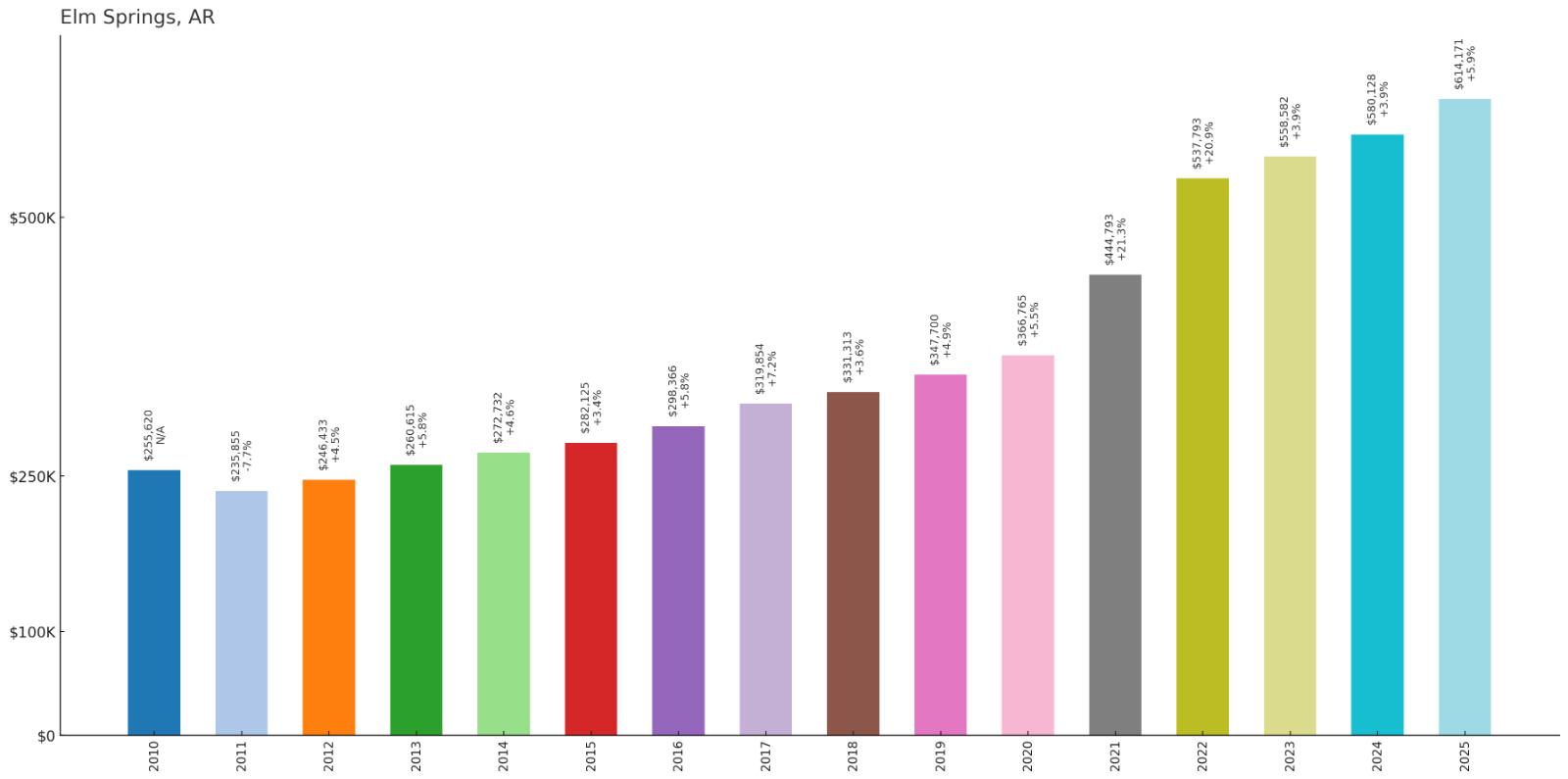
- 2010: $255,620
- 2011: $235,855
- 2012: $246,433
- 2013: $260,615
- 2014: $272,732
- 2015: $282,125
- 2016: $298,366
- 2017: $319,854
- 2018: $331,313
- 2019: $347,700
- 2020: $366,765
- 2021: $444,793
- 2022: $537,793
- 2023: $558,582
- 2024: $580,128
- 2025: $614,171
Elm Springs experienced substantial growth, with home values more than doubling from $255,620 in 2010 to $614,171 in 2025. The community showed steady appreciation throughout the 2010s before accelerating dramatically after 2020. The strongest period was 2021-2022, when prices surged by more than $170,000.
Why Elm Springs?
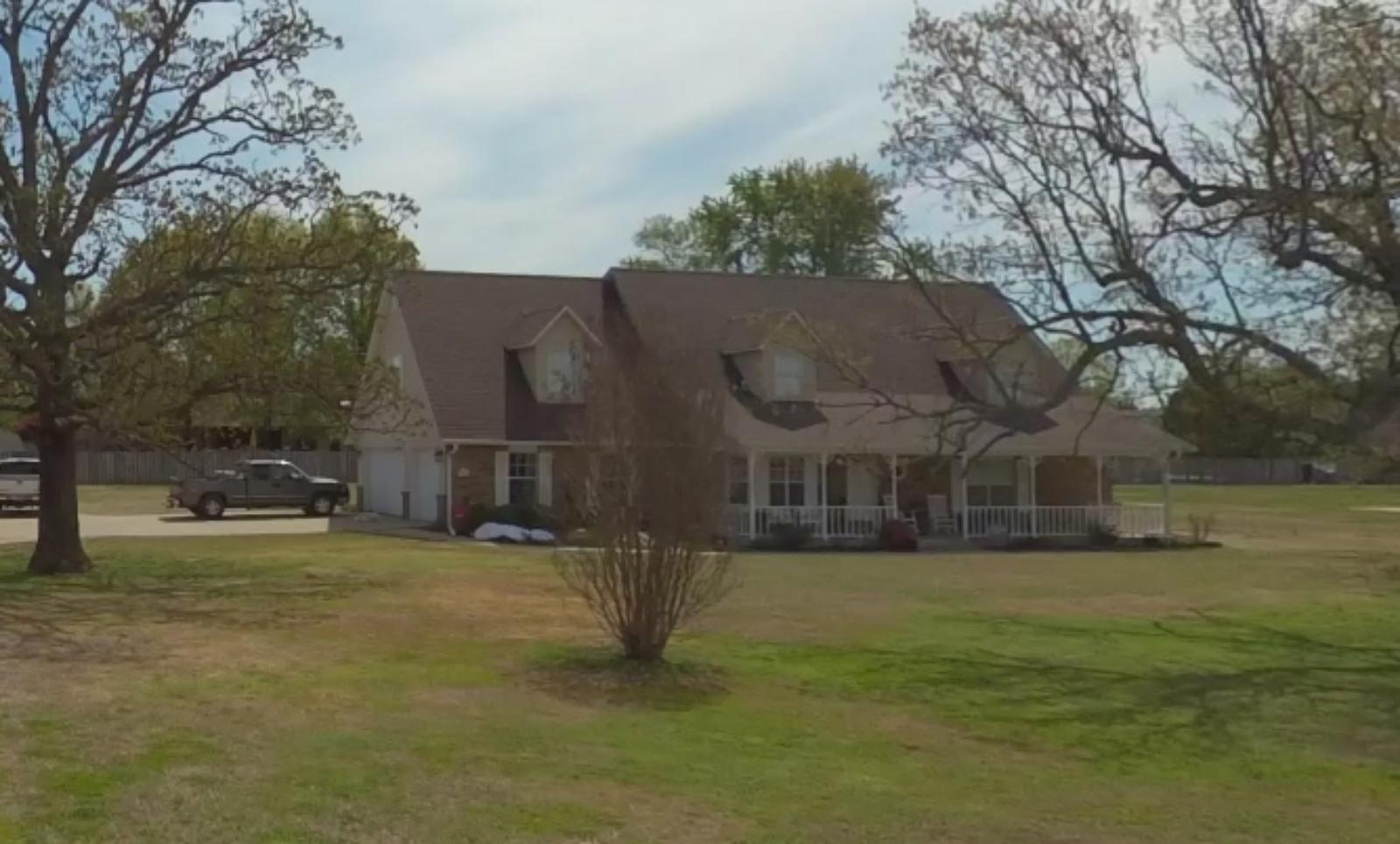
Why Are People Willing to Pay So Much to Live Here? What’s Special About It?
Elm Springs attracts buyers seeking luxury living with rural character and modern amenities. The community offers custom homes, large lots, and upscale developments while maintaining a semi-rural atmosphere that appeals to affluent families. Residents value the privacy and space that comes with exclusive residential development.
The area’s combination of luxury amenities and rural setting provides an attractive alternative to more dense suburban developments while maintaining convenient access to regional employment centers. This unique positioning has made Elm Springs particularly appealing to high-income buyers.
How Elm Springs Rose to Prominence
Elm Springs developed as a small rural community in Washington County, remaining primarily agricultural through most of its history. The area began attracting residential development as Northwest Arkansas’s economy expanded and demand grew for upscale housing options.
The community’s rural setting and availability of large tracts for custom home development made it attractive to affluent buyers seeking luxury living with privacy and space. Elm Springs has evolved into one of the region’s most exclusive residential areas while maintaining its rural character.
3 Interesting Tidbits
- Custom Estates – Elm Springs is known for its large custom-built homes and estate-style properties that attract affluent buyers.
- Rural Luxury – The community offers a unique combination of luxury amenities and rural character that sets it apart from typical suburban developments.
- Privacy Haven – Large lots and low-density development provide privacy and space that appeals to high-end residential buyers.
1. Goshen – 124% Home Price Increase Since 2010
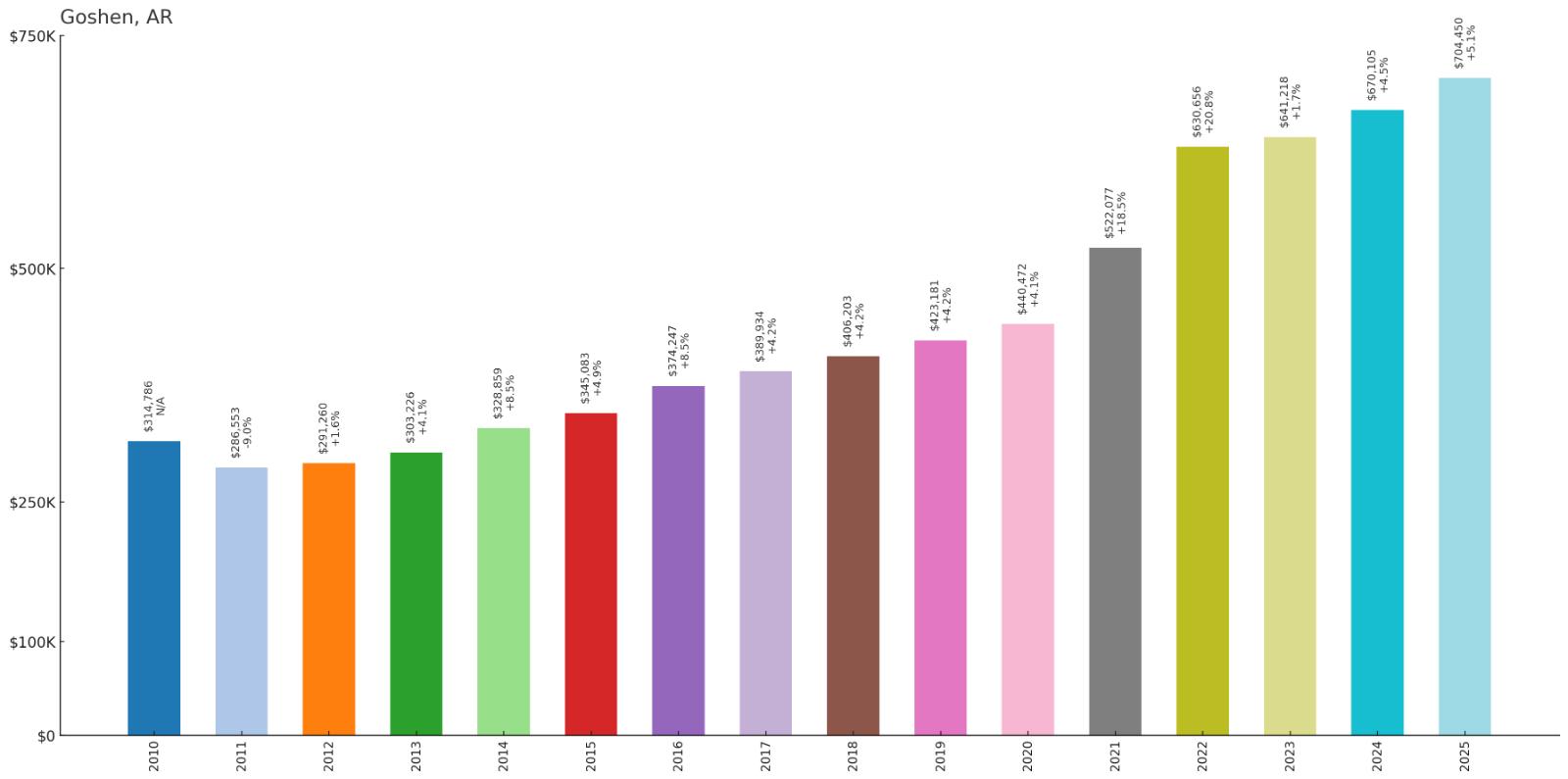
- 2010: $314,786
- 2011: $286,553
- 2012: $291,260
- 2013: $303,226
- 2014: $328,859
- 2015: $345,083
- 2016: $374,247
- 2017: $389,934
- 2018: $406,203
- 2019: $423,181
- 2020: $440,472
- 2021: $522,077
- 2022: $630,656
- 2023: $641,218
- 2024: $670,105
- 2025: $704,450
Goshen tops this list with the highest home values in Arkansas, more than doubling from $314,786 in 2010 to $704,450 in 2025. Despite having the most expensive baseline in 2010, the community continued strong appreciation throughout the period. The strongest growth came in 2021-2022, when prices jumped by more than $190,000.
Why Goshen?

Why Are People Willing to Pay So Much to Live Here? What’s Special About It?
Goshen attracts the region’s most affluent buyers with its exclusive residential character and scenic rural setting. The community offers custom luxury homes, large estates, and privacy while maintaining proximity to Fayetteville and Northwest Arkansas employment centers. Residents value the combination of exclusivity, natural beauty, and convenient access to urban amenities.
The area’s reputation as the region’s premier residential destination has created a self-reinforcing cycle of high property values and continued appreciation. This exclusive status has made Goshen the ultimate address for successful professionals and executives in Northwest Arkansas.
How Goshen Rose to Prominence
Goshen developed as a small rural community east of Fayetteville, remaining agricultural through most of the 20th century. The area’s scenic setting and proximity to Fayetteville made it attractive for upscale residential development as the region’s economy grew.
The community’s transformation into Arkansas’s most exclusive residential area occurred gradually as successful professionals and executives sought luxury homes with rural settings and urban access. Goshen has maintained its position as the state’s premier residential destination, consistently attracting the region’s most affluent buyers.
3 Interesting Tidbits
- Arkansas’s Most Expensive – Goshen consistently ranks as Arkansas’s most expensive residential market, attracting the state’s most affluent buyers.
- Executive Estates – The community is known for its luxury custom homes and estate properties that serve as showcases for regional success.
- Scenic Prestige – Goshen’s combination of natural beauty, large lots, and exclusive character has made it the ultimate status address in Arkansas.



